Year
2015
11 entries in this year | view all years
A Merry Christmas to All
Posted December 2015 in Engraving, Painters|Photographers, PhotoSeed, Publishing, Typography
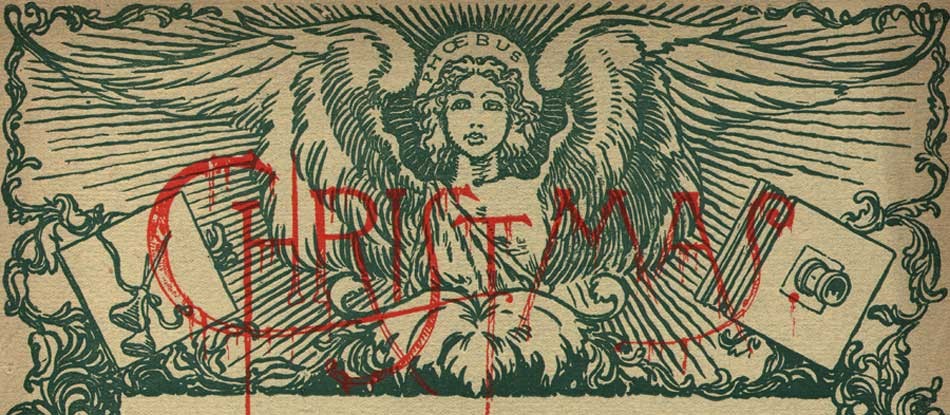 Detail: "Phoebus": by George Wharton Edwards: American 1859-1950: multiple-color woodcut used as part of cover illustration for periodical "Sun & Shade": New York: December, 1890: whole #28: N.Y. Photo-Gravure Co.: 32.1 x 25.3 cm | 35.3 x 28.0 cm: from: PhotoSeed Archive
Detail: "Phoebus": by George Wharton Edwards: American 1859-1950: multiple-color woodcut used as part of cover illustration for periodical "Sun & Shade": New York: December, 1890: whole #28: N.Y. Photo-Gravure Co.: 32.1 x 25.3 cm | 35.3 x 28.0 cm: from: PhotoSeed Archive
 "Christmas Eve": by Sir John Everett Millais: English 1829-1896: photogravure published in periodical "Sun & Shade": New York: December, 1890: whole #28: N.Y. Photo-Gravure Co.: 19.2 x 15.7 cm | 34.9 x 27.2 cm: from: PhotoSeed Archive
"Christmas Eve": by Sir John Everett Millais: English 1829-1896: photogravure published in periodical "Sun & Shade": New York: December, 1890: whole #28: N.Y. Photo-Gravure Co.: 19.2 x 15.7 cm | 34.9 x 27.2 cm: from: PhotoSeed Archive
 Detail: "A Merry Christmas": Emilie V. Clarkson: American 1863-1946: photogravure published in periodical "Sun & Shade": New York: December, 1890: whole #28: N.Y. Photo-Gravure Co.: 20.1 x 14.5 cm | 34.9 x 27.2 cm: from: PhotoSeed Archive
Detail: "A Merry Christmas": Emilie V. Clarkson: American 1863-1946: photogravure published in periodical "Sun & Shade": New York: December, 1890: whole #28: N.Y. Photo-Gravure Co.: 20.1 x 14.5 cm | 34.9 x 27.2 cm: from: PhotoSeed Archive
 Detail: "We Praise Thee O Lord" ("Sang with many a change Christmas carols until morn.": Emilie V. Clarkson: American 1863-1946: photogravure published in periodical "Sun & Shade": New York: December, 1890: whole #28: N.Y. Photo-Gravure Co.: 20.0 x 15.5 cm | 34.9 x 27.2 cm: from: PhotoSeed Archive
Detail: "We Praise Thee O Lord" ("Sang with many a change Christmas carols until morn.": Emilie V. Clarkson: American 1863-1946: photogravure published in periodical "Sun & Shade": New York: December, 1890: whole #28: N.Y. Photo-Gravure Co.: 20.0 x 15.5 cm | 34.9 x 27.2 cm: from: PhotoSeed Archive
 Detail: "Christmas Morning by the Sea" (alt: Winter's Touch on Land And Sea": Mrs. J.M. Appleton: American: photogravure published in periodical "Sun & Shade": New York: December, 1890: whole #28: N.Y. Photo-Gravure Co.: 10.5 x 16.1 cm | 34.9 x 27.2 cm: from: PhotoSeed Archive
Detail: "Christmas Morning by the Sea" (alt: Winter's Touch on Land And Sea": Mrs. J.M. Appleton: American: photogravure published in periodical "Sun & Shade": New York: December, 1890: whole #28: N.Y. Photo-Gravure Co.: 10.5 x 16.1 cm | 34.9 x 27.2 cm: from: PhotoSeed Archive
No Junk in Trunk
Posted December 2015 in Alternate Processes, Cameras, Color Photography, New Additions, Photography, Unknown Photographers
If the story is to be believed, the contents of a mystery trunk ⎯the artistic passion of yet another unknown early 20th Century photographer ⎯have been saved once again in the name of photographic collecting. The evidence was several hundred photographs tucked inside:
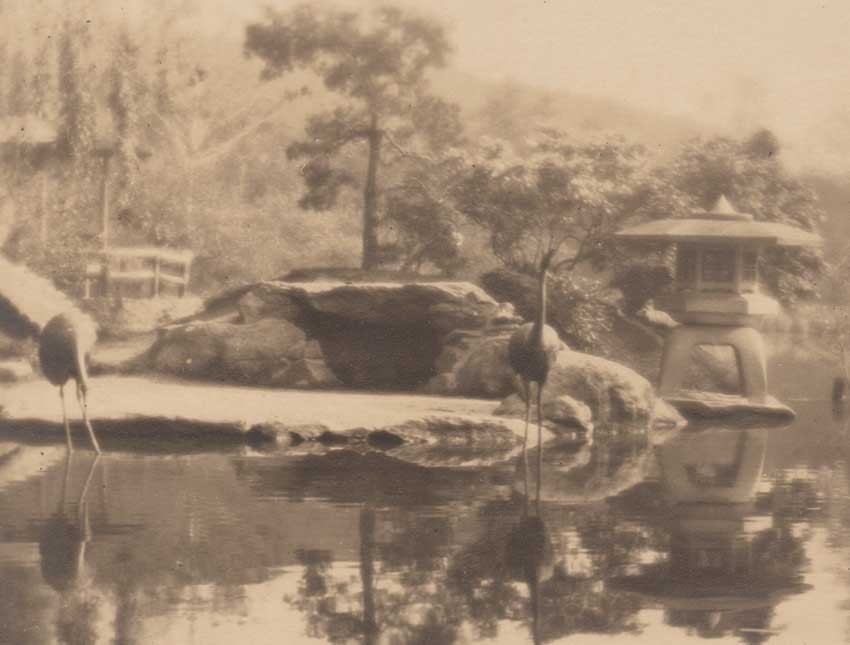 Detail: "Japanese Hill-and-Pond Garden Island" (at Brooklyn, New York Botanic Garden): ca. 1920-25: Unknown Brooklyn photographer: gelatin silver: 8.8 x 11.4 cm | 12.6 x 17.3 cm cream-colored, photographic paper stock: from: PhotoSeed Archive
Detail: "Japanese Hill-and-Pond Garden Island" (at Brooklyn, New York Botanic Garden): ca. 1920-25: Unknown Brooklyn photographer: gelatin silver: 8.8 x 11.4 cm | 12.6 x 17.3 cm cream-colored, photographic paper stock: from: PhotoSeed Archive
”The dealer had bought a trunk from an estate of a lady who had passed away.”
A story I’ve encountered before in my online foraging. My offer, in order to keep the archive together, was fortunately accepted, and now share with you a glimpse of some of these fruits.
Typically, when photographs enter this collection, initial research on origins and other factors are made and then set aside-often for years- until more deductions can be made or oftentimes additional primary source material percolates into that vast library we all humbly know as the public Internet.
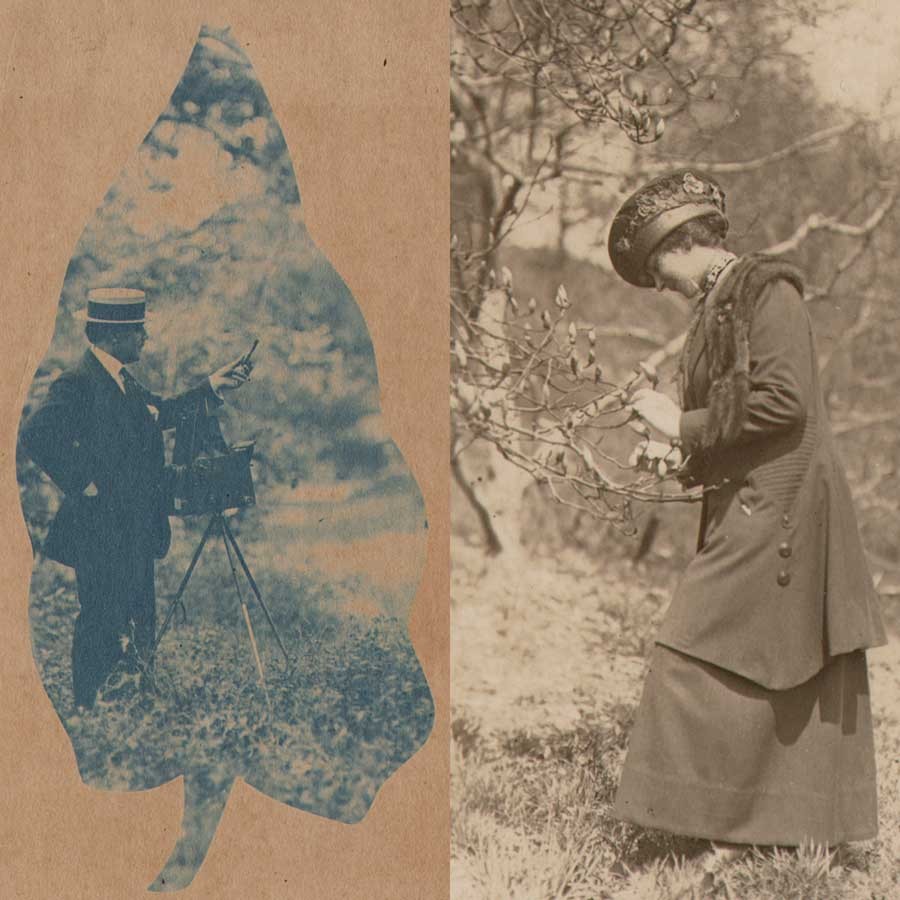 Husband & Wife? L: Detail: "Photographer in Boater Hat Behind Graflex Camera": ca. 1910-1920: Unknown Brooklyn photographer: cyanotype: 11.2 x 5.2 cm | 14.6 x 8.2 cm: image printed within leaf shape on thin cream-colored paper: R: Detail: "Woman Examining Magnolia Blossom": ca. 1910-1920: Unknown Brooklyn photographer: gelatin silver: 11.1 x 7.3 cm | 17.1 x 10.5 cm: both from: PhotoSeed Archive
Husband & Wife? L: Detail: "Photographer in Boater Hat Behind Graflex Camera": ca. 1910-1920: Unknown Brooklyn photographer: cyanotype: 11.2 x 5.2 cm | 14.6 x 8.2 cm: image printed within leaf shape on thin cream-colored paper: R: Detail: "Woman Examining Magnolia Blossom": ca. 1910-1920: Unknown Brooklyn photographer: gelatin silver: 11.1 x 7.3 cm | 17.1 x 10.5 cm: both from: PhotoSeed Archive
But exceptions, at least in my world, always exist. For these latest trunk photographs coming to light, my discovery a small portion documenting a place and event celebrating 100 year anniversaries in 2015 were primary motivators in showcasing them now with this post. These were the establishment of the Japanese Hill-and-Pond Garden in 1915 at the Brooklyn Botanic Garden, considered the first Japanese garden created in an American public garden, as well as a small cache of photographs taken the same year at the Panama-Pacific International Exposition in San Francisco, California.
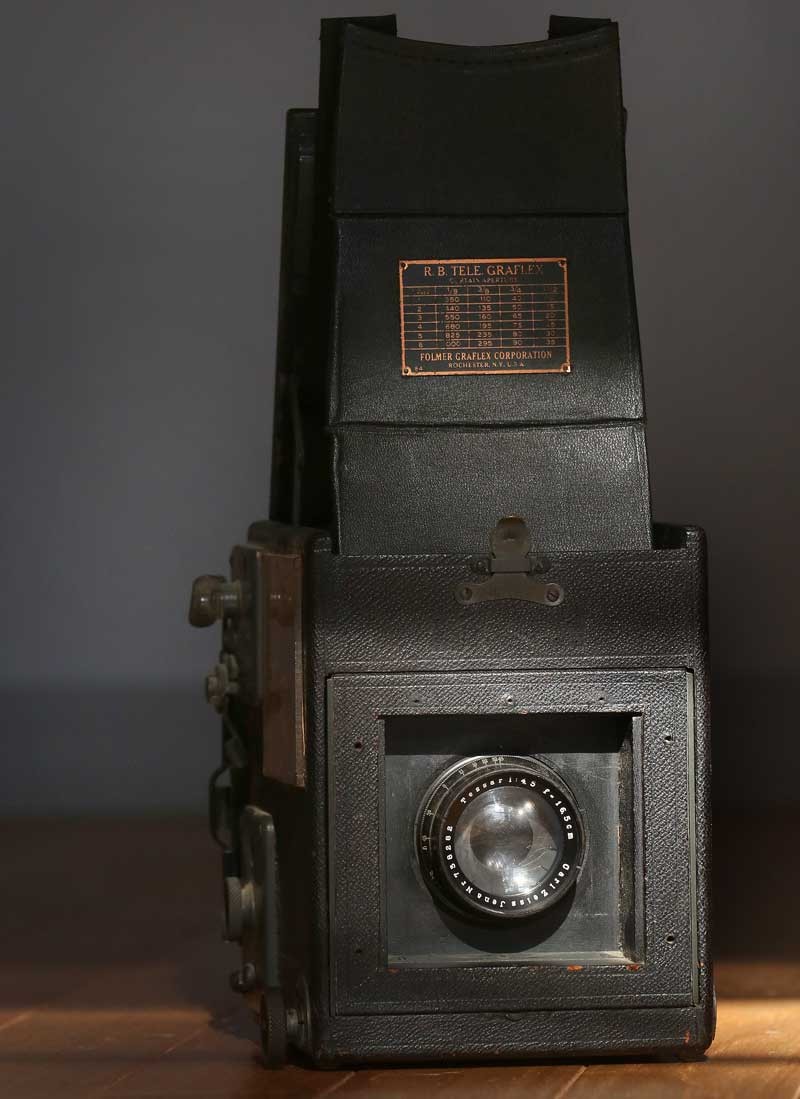 R.B.Tele-Graflex Camera outfitted with Carl Zeiss Tessar lens ca. 1913 (last patent is for June of this year on camera bottom) Manufactured by the Folmer Graflex Corporation, Rochester, New York. The Unknown Brooklyn photographer who took the images seen with this post used a similar Graflex model pictured in the above cyanotype. Lightweight so it could be carried in the field and used on a tripod or hand-held, it features a revolving back so the glass or cut film plates loaded into individual holders could be oriented on the camera back for a vertical or horizontal field of view. The photographer looked through the top of the camera (shown in open position here) and focused on the ground glass inside while bringing the subject into focus by manipulating the bellows (not extended in this photo) using the knob located at the far left of the lens board on lower side of camera. from: PhotoSeed Archive
R.B.Tele-Graflex Camera outfitted with Carl Zeiss Tessar lens ca. 1913 (last patent is for June of this year on camera bottom) Manufactured by the Folmer Graflex Corporation, Rochester, New York. The Unknown Brooklyn photographer who took the images seen with this post used a similar Graflex model pictured in the above cyanotype. Lightweight so it could be carried in the field and used on a tripod or hand-held, it features a revolving back so the glass or cut film plates loaded into individual holders could be oriented on the camera back for a vertical or horizontal field of view. The photographer looked through the top of the camera (shown in open position here) and focused on the ground glass inside while bringing the subject into focus by manipulating the bellows (not extended in this photo) using the knob located at the far left of the lens board on lower side of camera. from: PhotoSeed Archive
But there’s more as they say. Many of the photographs: gorgeous little jewels printed directly onto small impressed and ruled pieces of photographic paper which act as mounts-some toned in verdant hues of green for landscapes, blues for seascapes and others beautifully hand-colored, are known to have been taken in the mother of the Brooklyn Botanic Garden itself, the expansive 585-acre Prospect Park designed by Frederick Law Olmsted and Calvert Vaux- Brooklyn’s version of New York City’s Central Park which is celebrating its’ 150th anniversary in 2016.
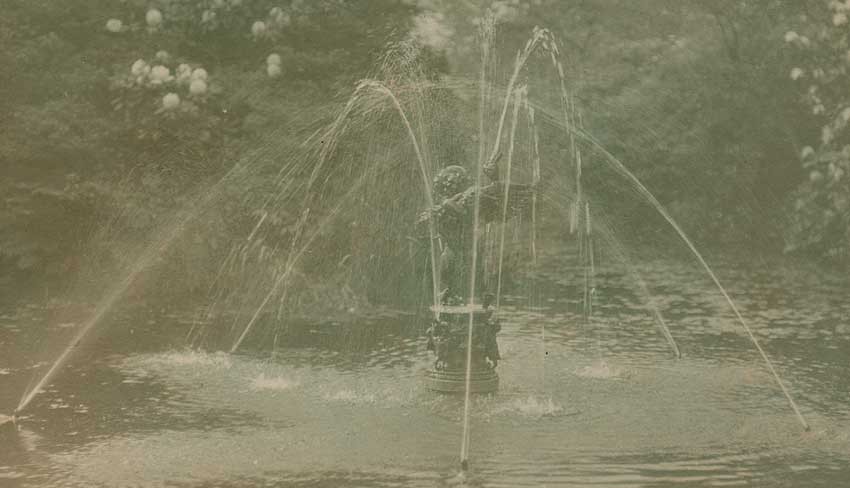 Detail: "Boy and Duck Fountain in Vale of Cashmere", sculpture by Frederick William MacMonnies, American: 1863-1937 (at Brooklyn Botanic Garden): ca. 1910-20: Unknown Brooklyn photographer: green toned gelatin silver: 8.8 x 11.6 cm|12.4 x 16.9 cm: from: PhotoSeed Archive
Detail: "Boy and Duck Fountain in Vale of Cashmere", sculpture by Frederick William MacMonnies, American: 1863-1937 (at Brooklyn Botanic Garden): ca. 1910-20: Unknown Brooklyn photographer: green toned gelatin silver: 8.8 x 11.6 cm|12.4 x 16.9 cm: from: PhotoSeed Archive
Frustratingly, the photographer’s identity responsible for these fruits is presently unknown, other than a cyanotype image included with the collection showing a dapper gentleman believed to be this person standing behind a tripod-mounted Graflex model camera. Photographically printed within the outlines of a leaf while standing in a park-like setting, he wears a straw boater hat while dressed in a suit and raises his hand clenching a pipe towards the scene before him as if to say, “now that’s a scene worthy of my camera”, or something to that effect.
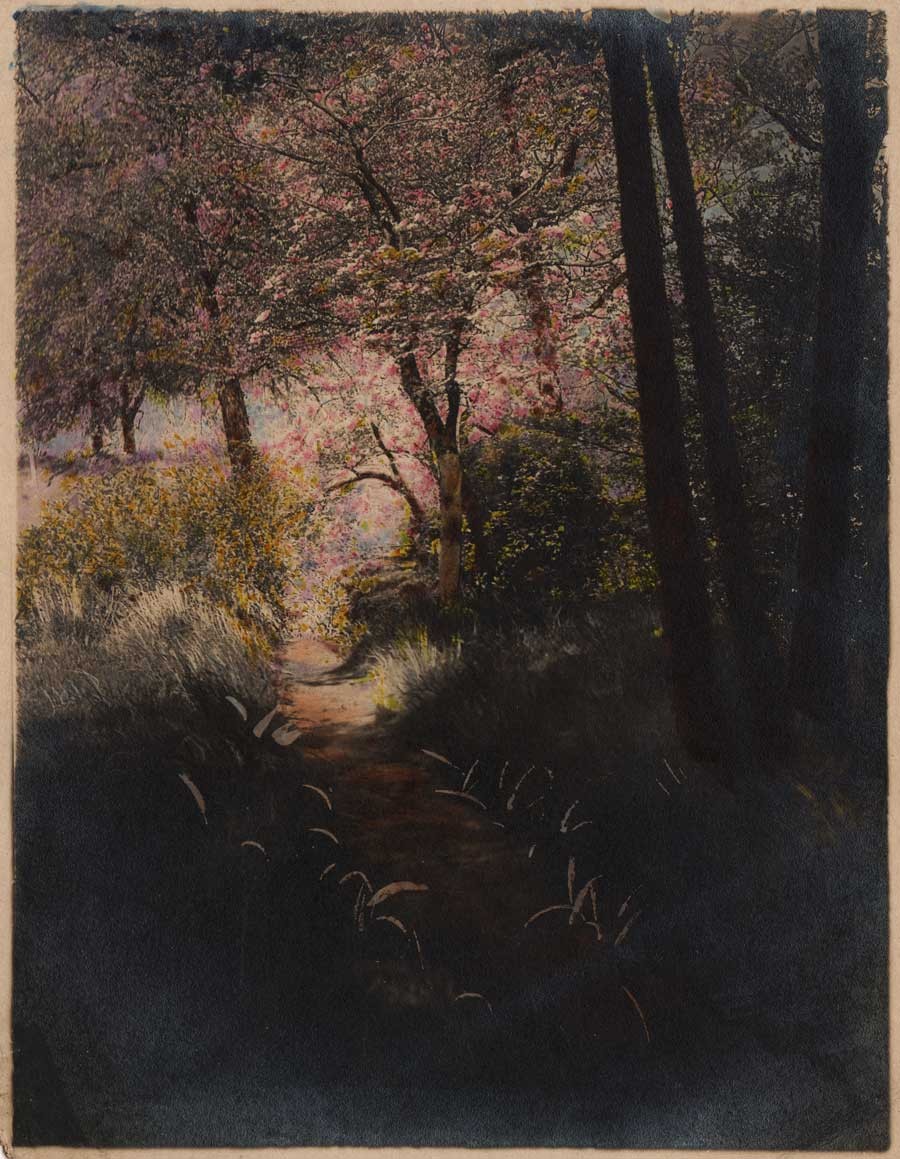 "Spring at Prospect Park"(Brooklyn, New York): ca. 1910-20: Unknown Brooklyn photographer: hand-colored gelatin silver: 11.8 x 9.0 cm | 13.2 x 9.9 cm: from: PhotoSeed Archive
"Spring at Prospect Park"(Brooklyn, New York): ca. 1910-20: Unknown Brooklyn photographer: hand-colored gelatin silver: 11.8 x 9.0 cm | 13.2 x 9.9 cm: from: PhotoSeed Archive
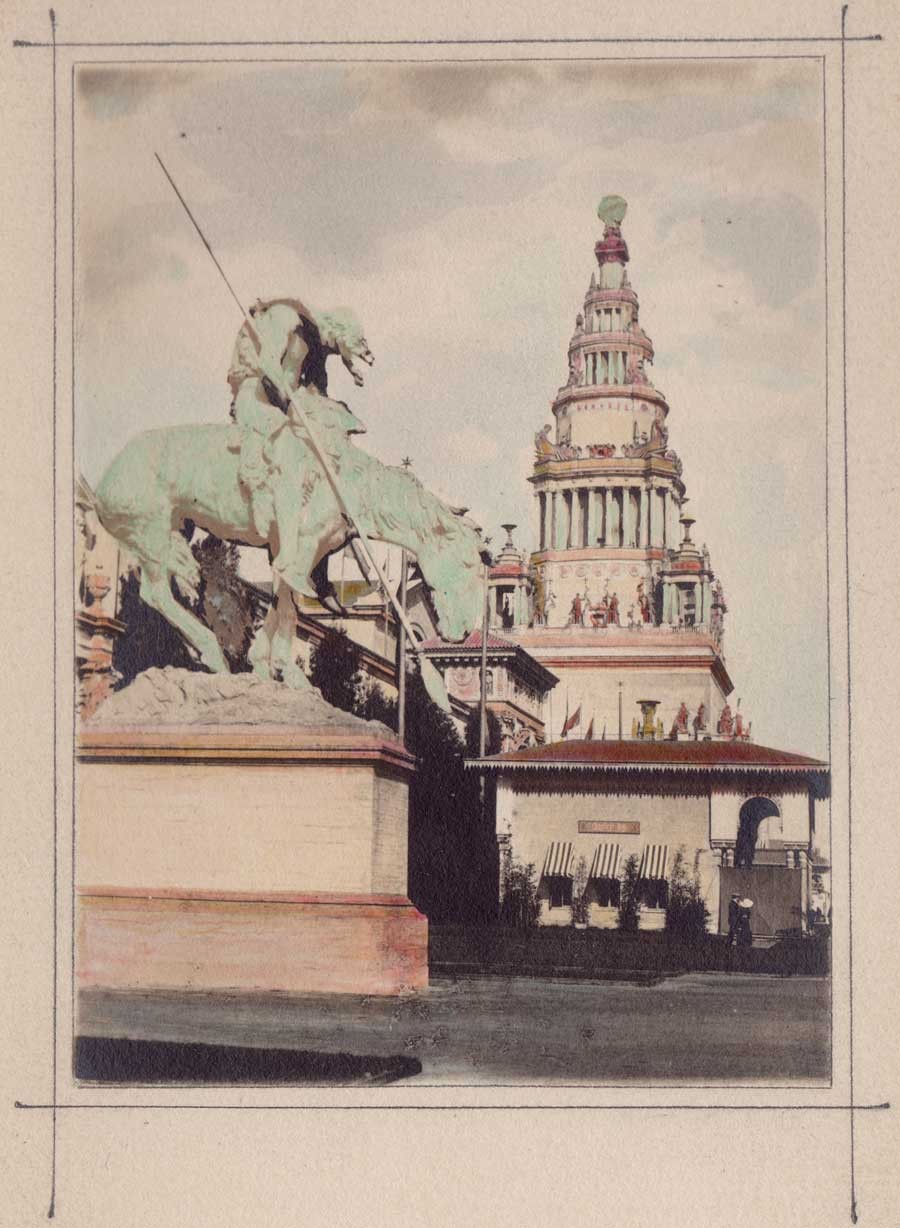 "The End of the Trail": sculpture by James Earle Fraser (American: 1876-1953) at Panama-Pacific International Exposition, San Francisco, California (Tower of Jewels in background) : 1915: Unknown Brooklyn photographer: hand-ruled & colored gelatin silver: 11.0 x 8.0 cm | 17.1 x 11.5 cm: from: PhotoSeed Archive
"The End of the Trail": sculpture by James Earle Fraser (American: 1876-1953) at Panama-Pacific International Exposition, San Francisco, California (Tower of Jewels in background) : 1915: Unknown Brooklyn photographer: hand-ruled & colored gelatin silver: 11.0 x 8.0 cm | 17.1 x 11.5 cm: from: PhotoSeed Archive
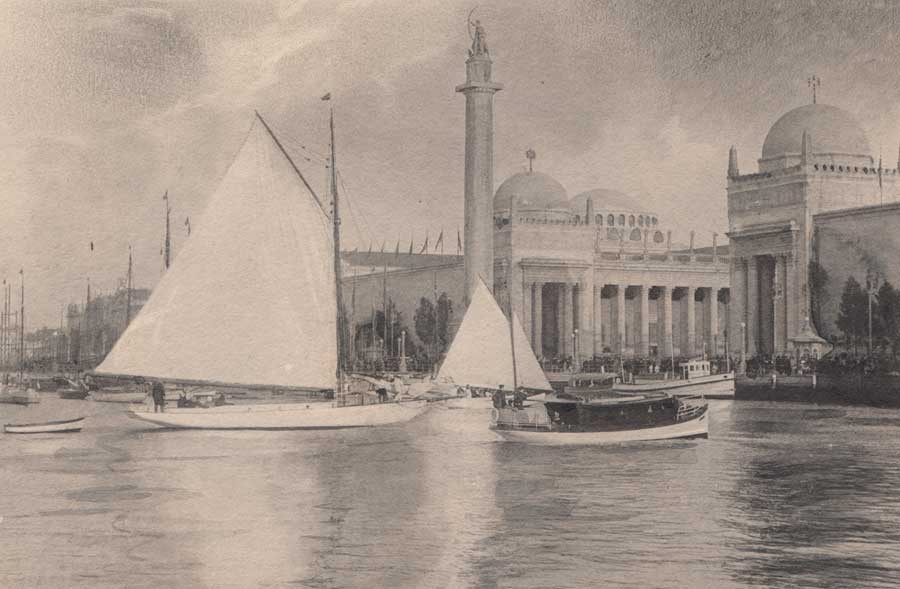 Detail: "Yacht Harbor at Panama-Pacific International Exposition" (Palaces of Agriculture & Transportation in background): 1915: Unknown Brooklyn photographer: gelatin silver with ink wash & photographic border: 7.4 x 11.5 cm | 11.4 x 17.8 cm: from: PhotoSeed Archive
Detail: "Yacht Harbor at Panama-Pacific International Exposition" (Palaces of Agriculture & Transportation in background): 1915: Unknown Brooklyn photographer: gelatin silver with ink wash & photographic border: 7.4 x 11.5 cm | 11.4 x 17.8 cm: from: PhotoSeed Archive
Several other photographs showing an unknown woman, most likely the photographer’s wife, or perhaps the artist herself, (can’t be ruled out) were also included in the trunk photographs. In one, a full-length profile view, she examines a Magnolia blossom in a park setting. (shown here) In another, her gaze is directed towards the camera while wearing an Asian influenced floral dress posing in front of blooming Wisteria vines. The dealer who had initially acquired the photographs, according to the seller I purchased them from, stated they had been acquired from the estate of a woman, (most likely depicted in the photographs) who had (presumably) attended or graduated from Wesleyan Female College, (now Wesleyan College) in Macon, Georgia at the turn of the 20th Century.
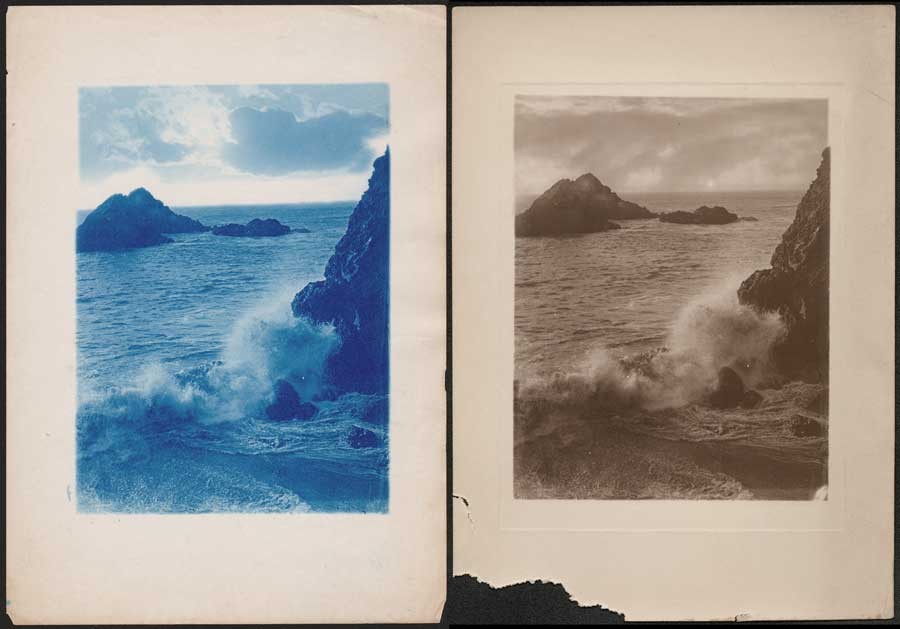 L: "Coastline with Rocks & Wave Action" (possibly California ) :12.3 x 9.0 cm | 17.7 x 12.6 cm: ca. 1910-1920: Unknown Brooklyn photographer: cyanotype with addition of clouds from alternate source photo: R: variant: "Coastline with Rocks & Wave Action" (possibly California) : 11.5 x 9.0 cm | 17.6 x 12.7 cm: ca. 1910-1920: Unknown Brooklyn photographer: gelatin silver: (mouse damage to lower margin): both from: PhotoSeed Archive
L: "Coastline with Rocks & Wave Action" (possibly California ) :12.3 x 9.0 cm | 17.7 x 12.6 cm: ca. 1910-1920: Unknown Brooklyn photographer: cyanotype with addition of clouds from alternate source photo: R: variant: "Coastline with Rocks & Wave Action" (possibly California) : 11.5 x 9.0 cm | 17.6 x 12.7 cm: ca. 1910-1920: Unknown Brooklyn photographer: gelatin silver: (mouse damage to lower margin): both from: PhotoSeed Archive
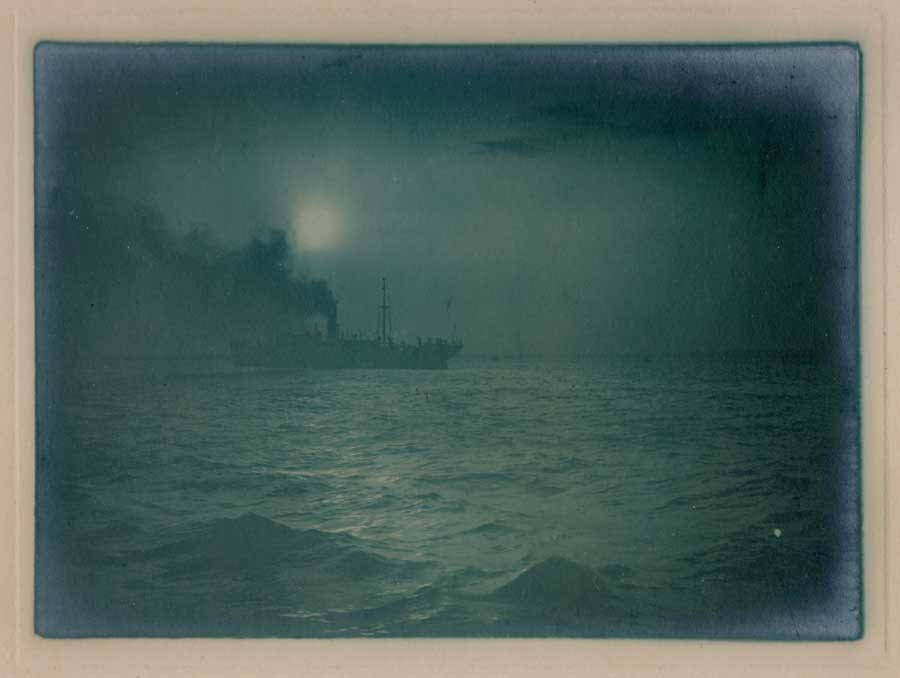 "Steamer in New York Harbor": ca. 1910-20: Unknown Brooklyn photographer: green toned gelatin silver: 8.4 x 11.6 cm | 12.3 x 17.9 cm: from: PhotoSeed Archive
"Steamer in New York Harbor": ca. 1910-20: Unknown Brooklyn photographer: green toned gelatin silver: 8.4 x 11.6 cm | 12.3 x 17.9 cm: from: PhotoSeed Archive
And even though the photographs ended their life residing in a mystery trunk in the American South, I’ll label them for now as being the work of Unknown Brooklyn, in order to keep their attribution consistent for those searching this archive going forward.
Oh, Dear, My Thanksgiving Dinner!
Posted November 2015 in New Additions, Publishing
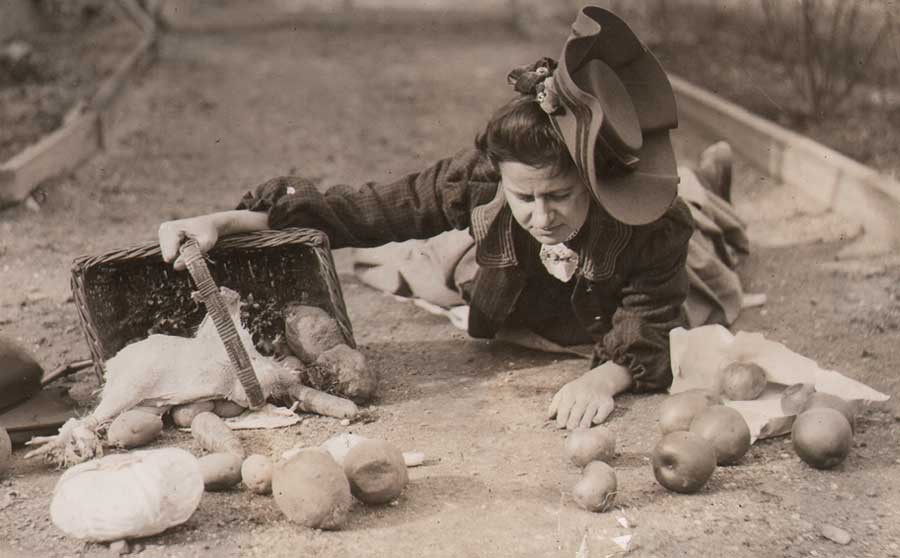 Detail: "Oh, Dear, My Thanksgiving Dinner!" c. 1907 by Jeanette Bernard: American, born Germany: (1855-1941) gelatin silver print c. 1935-40 from original glass plate negative acquired by Culver Service : 15.6 x 20.0 cm: from PhotoSeed Archive
Detail: "Oh, Dear, My Thanksgiving Dinner!" c. 1907 by Jeanette Bernard: American, born Germany: (1855-1941) gelatin silver print c. 1935-40 from original glass plate negative acquired by Culver Service : 15.6 x 20.0 cm: from PhotoSeed Archive
Hope & Yearning for Light
Posted October 2015 in Alternate Processes, Painters|Photographers, Publishing
Photography up to our modern day is by definition “Drawing with Light”, whereby the permanent recording of an object is achieved via electronic or chemical action. Simplistically this makes sense, but in order to make the outcome relevant and interesting enough to matter, especially in our visually overloaded present, practitioners to put it mildly need to include a bit of heart and soul into their efforts.
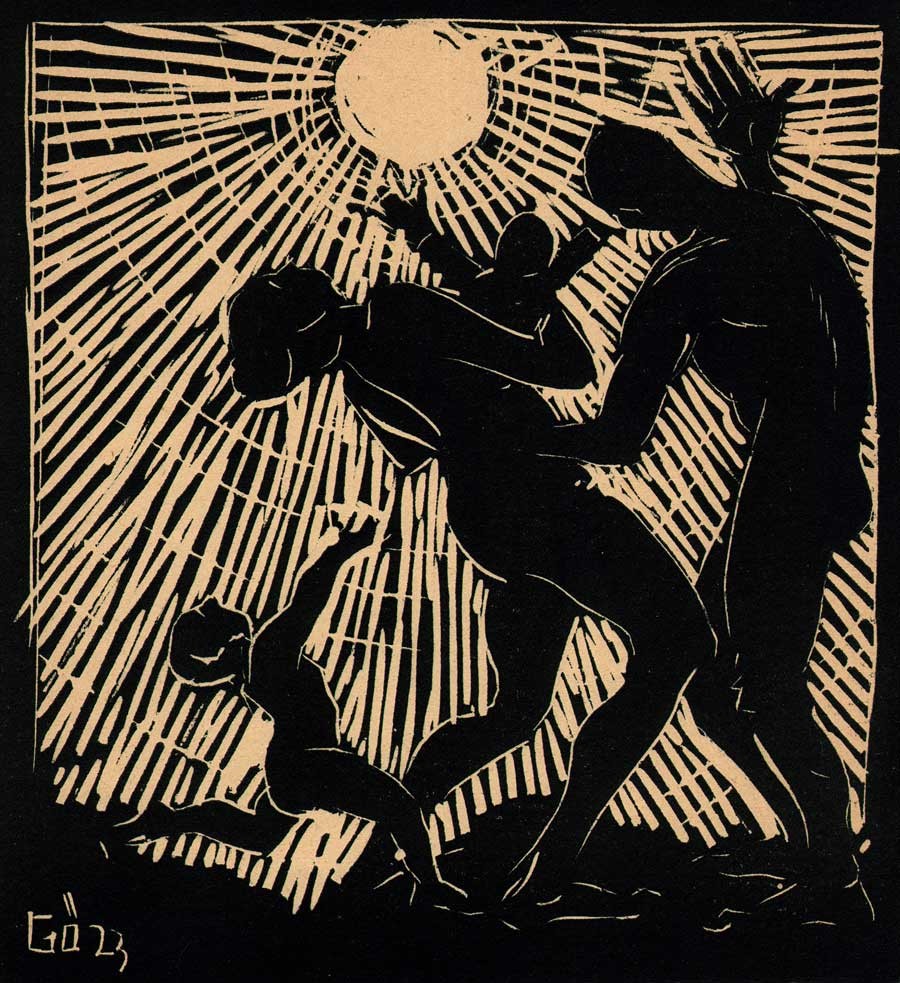 Detail: Linoleum cut: "Family in an Explosion of Light" : (20.5 x 18.8 cm impression | 28.9 x 25.0 cm paper) 1925 print by Emery Gondor, American (b. Hungary) : included in unpublished folio: "Sehnsucht nach Licht" (Yearning for Light) : "8 Original Linoleum schnitte von Emerich Göndör" (8 original Linoleum cuts by Emerich Göndör) from: PhotoSeed Archive
Detail: Linoleum cut: "Family in an Explosion of Light" : (20.5 x 18.8 cm impression | 28.9 x 25.0 cm paper) 1925 print by Emery Gondor, American (b. Hungary) : included in unpublished folio: "Sehnsucht nach Licht" (Yearning for Light) : "8 Original Linoleum schnitte von Emerich Göndör" (8 original Linoleum cuts by Emerich Göndör) from: PhotoSeed Archive
Emery Gondor (Emerich Göndör: 1896-1977) had these last two qualities in abundance. A Hungarian artist of prodigious talent who worked in multiple artistic disciplines including photography, the recent acquisition by this archive of some of his signed 1925 linocuts prove a teachable moment for why the manipulations of light and dark in another medium are instructive for creative souls in the present.
Some background, including the reality and history of turbulence in early 20th Century Europe, are critical to our understanding in how artists like Gondor could not be defeated by hatred which destroyed millions of lives and split apart society’s fabric there.
Indeed, his empathy for those shattered lives were taken to heart in the aftermath of his three and a half year service as a soldier in World War I which changed his life forever. Combined with his interest in progressive art education for children discovered in the early 1920’s while attending Vienna’s Academy of Industrial Arts and his work with emotionally disturbed children at the University Clinic there gave him an outlet and purpose for artistic expression, and would culminate towards the end of his career in the 1960’s as director of the art program at the Institute for Mental Retardation at New York Medical College (today : Westchester Institute for Human Development) after earning a degree in Clinical Psychology from New York State University. (1.)
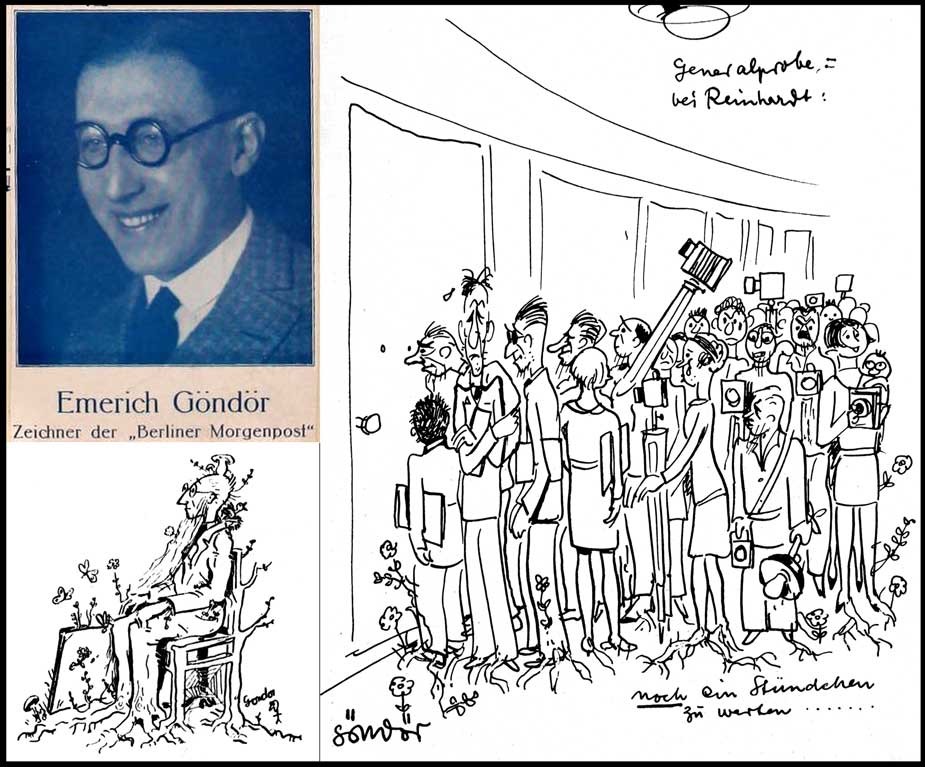 Upper left: 1929 photograph of Emery Gondor when employed as artist for Berliner Morgenpost newspaper in Germany. Bottom left: humorous caricature from early 1920's shows the artist seated with legs growing into the ground like roots. His cartoon poking fun at an interminable wait to see an editor at Berlin's Ullstein Verlag publishing house earned him a twelve year career there, where he excelled in multiple artistic disciplines including press photography with theatre subjects a specialty. Right: cartoon titled "Generalprobe bei Reinhardt" (Rehearsal at the Reinhardt) shows the artist (first figure standing at left wearing glasses) along with other members of the press waiting outside the Deutsches Theater to be let in for a press review. The drawing appeared in the May, 1930 issue of Blätter Des Deutschen Theaters. (Journal of the German Theater of Berlin) Surreally, the first name in a contributing, alphabetical list of well known actors, artists, writers and composers for the issue was Benno von Arent, an art director and production designer who became a ranking member of the Nazi SS responsible for art, theatres and cinema for Hitler. sources: portrait and theatre cartoon: Series V: Clippings and Scrapbooks, 1909-1935: Emery and Bertalan Gondor Collection; Leo Baeck Institute; lower left: illustration from graphic arts journal PM, 1936: New York: "Mr. Gondor comes to America".
Upper left: 1929 photograph of Emery Gondor when employed as artist for Berliner Morgenpost newspaper in Germany. Bottom left: humorous caricature from early 1920's shows the artist seated with legs growing into the ground like roots. His cartoon poking fun at an interminable wait to see an editor at Berlin's Ullstein Verlag publishing house earned him a twelve year career there, where he excelled in multiple artistic disciplines including press photography with theatre subjects a specialty. Right: cartoon titled "Generalprobe bei Reinhardt" (Rehearsal at the Reinhardt) shows the artist (first figure standing at left wearing glasses) along with other members of the press waiting outside the Deutsches Theater to be let in for a press review. The drawing appeared in the May, 1930 issue of Blätter Des Deutschen Theaters. (Journal of the German Theater of Berlin) Surreally, the first name in a contributing, alphabetical list of well known actors, artists, writers and composers for the issue was Benno von Arent, an art director and production designer who became a ranking member of the Nazi SS responsible for art, theatres and cinema for Hitler. sources: portrait and theatre cartoon: Series V: Clippings and Scrapbooks, 1909-1935: Emery and Bertalan Gondor Collection; Leo Baeck Institute; lower left: illustration from graphic arts journal PM, 1936: New York: "Mr. Gondor comes to America".
In an 1936 artist profile published in the graphic arts journal PM Magazine soon after his immigration to the United States from Europe, Emery Gondor writes:
”But my real interest and love is children. I illustrated many children’s books for the “Union Verlag” Stuttgart, the biggest children’s publishing house, and other youth-publications.” …I made up many hundreds of games for children, puzzles for adults, comic strips. I exhibited again and wrote many articles about humorous observations of children. I always received hundreds of fan letters from my children friends.” (2.)
The Germinal Circle
As a young artist living and just getting by in Vienna after WWI, Gondor did not shy away from progressive ideas as well as the opportunity to sell his original artwork while promoting himself. Traveling to London in late 1923, he did live caricature sketches of poems read aloud by their authors on November 5th and 23rd as an invited guest of the Germinal Circle. Organized by the Italian anarchist Silvio Corio and his lover Sylvia Pankhurst, a like-minded British writer whose mother Emmeline Pankhurst was the leader of the British suffragette movement, the circle was an artistic and literary salon for their short-lived political and cultural monthly magazine Germinal founded the same year. (3.)
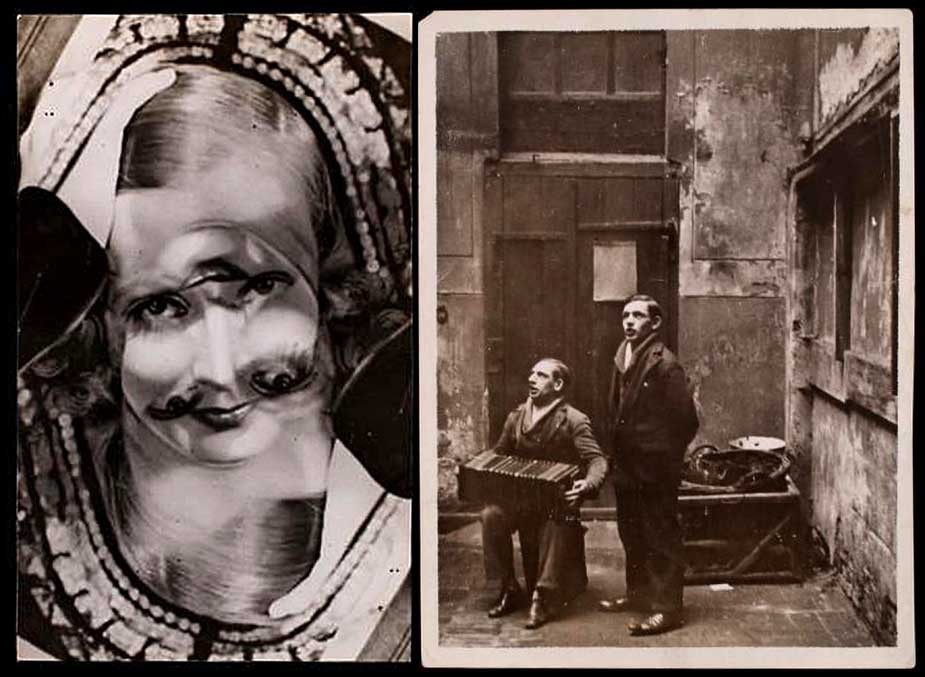 Although better known as an artist, Emery Gondor was an accomplished photographer whose work appeared in some of the largest European newspapers (principally German) from the mid 1920's into the 1930's. Work contained in his archive at the Leo Baeck Institute in New York City shows a talent equally adept at documentary in addition to staged subject matter including theatrical. Hartmuth Merleker, his former editor at the Ullstein newspapers Tempo and Berliner Montagspost, describes Gondor as not only an artist but a press photographer for the publications between 1929-1933. After learning his grandfather was a lithographer and father an engraver, an excerpt from his 1936 profile by the artist states further on the subject of photography: "I have always had an interest in the problems of reproduction technique. I learned press-photography too. In a short time I learned all the chemical and technical details. I worked one year for the "B.Z. am Mittag," the quickest German daily paper, as press photographer, and in accordance with my plan Ullstein built eight dark rooms for their daily paper photo service." Photographs by Gondor shown here: left: photomontage likely from the late 1920's of a theatrical subject. It likely appeared in one of Ullstein's German publications. Right: documentary subject of street musicians from early 1930's Europe or possibly 1940's New York; with Gondor's red-ink New York City stamp on print verso. Sources for both: Emery I. Gondor Collection; AR 25397; Box 2; Folder #49; Leo Baeck Institute.
Although better known as an artist, Emery Gondor was an accomplished photographer whose work appeared in some of the largest European newspapers (principally German) from the mid 1920's into the 1930's. Work contained in his archive at the Leo Baeck Institute in New York City shows a talent equally adept at documentary in addition to staged subject matter including theatrical. Hartmuth Merleker, his former editor at the Ullstein newspapers Tempo and Berliner Montagspost, describes Gondor as not only an artist but a press photographer for the publications between 1929-1933. After learning his grandfather was a lithographer and father an engraver, an excerpt from his 1936 profile by the artist states further on the subject of photography: "I have always had an interest in the problems of reproduction technique. I learned press-photography too. In a short time I learned all the chemical and technical details. I worked one year for the "B.Z. am Mittag," the quickest German daily paper, as press photographer, and in accordance with my plan Ullstein built eight dark rooms for their daily paper photo service." Photographs by Gondor shown here: left: photomontage likely from the late 1920's of a theatrical subject. It likely appeared in one of Ullstein's German publications. Right: documentary subject of street musicians from early 1930's Europe or possibly 1940's New York; with Gondor's red-ink New York City stamp on print verso. Sources for both: Emery I. Gondor Collection; AR 25397; Box 2; Folder #49; Leo Baeck Institute.
Several of Gondor’s original linocuts, including one incorporated into an advertisement showing a figure with outstretched arms standing next to a grouping of over-sized flowers facing emanating sun rays were reproduced as part of promotional literature in Germinal. The artist from this period is described in a typescript document held with the reproduction in the library of the Leo Baeck Institute in New York City:
The Germinal Circle has pleasure in introducing the work of Emerich Gondor, a young Hungarian artist, who has not previously exhibited in this country. A rapid caricaturist and cartoonist, he works with equal facility through lithography, wood-cuts, lino-cuts and many other mediums. (4.)
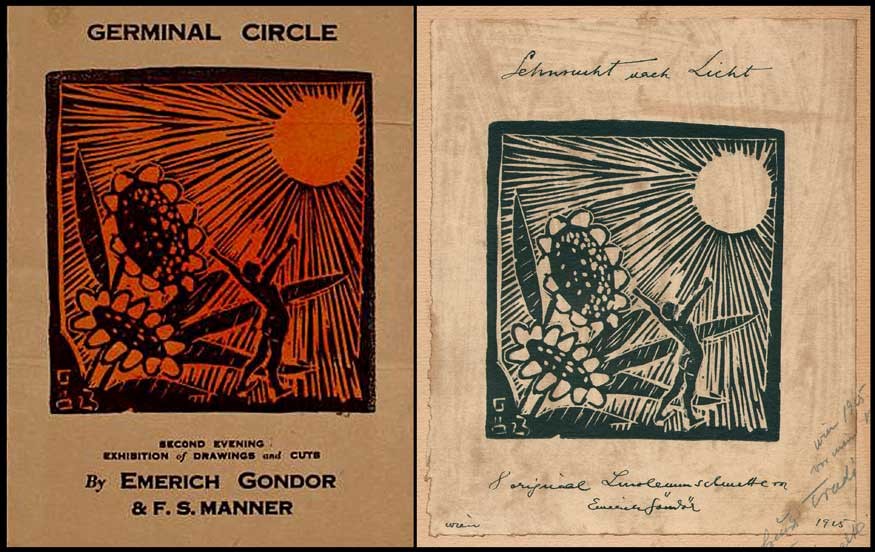 Left: detail: 1923 linoleum cut in two colors by Emery Gondor used as program advertisement for the Germinal Circle art salon's "Second Evening Exhibition of Drawings and Cuts which took place at the Ashburton Restaurant in London on November 28, 1923. source: Emery and Bertalan Gondor Collection; Leo Baeck Institute. Right: detail: same illustration with impression pulled in 1925 (20.5 x 18.8 cm ) used as cover maquette for Gondor's unpublished folio: "Sehnsucht nach Licht" (Yearning for Light) : "8 Original Linoleum schnitte von Emerich Göndör" (8 original Linoleum cuts by Emerich Göndör) from: PhotoSeed Archive
Left: detail: 1923 linoleum cut in two colors by Emery Gondor used as program advertisement for the Germinal Circle art salon's "Second Evening Exhibition of Drawings and Cuts which took place at the Ashburton Restaurant in London on November 28, 1923. source: Emery and Bertalan Gondor Collection; Leo Baeck Institute. Right: detail: same illustration with impression pulled in 1925 (20.5 x 18.8 cm ) used as cover maquette for Gondor's unpublished folio: "Sehnsucht nach Licht" (Yearning for Light) : "8 Original Linoleum schnitte von Emerich Göndör" (8 original Linoleum cuts by Emerich Göndör) from: PhotoSeed Archive
Sehnsucht nach Licht: Yearning for Light
Emery Gondor’s style in his surviving linoleum cuts from the early 1920’s were certainly influenced by the German Expressionists, and of the heartbreak and for many, hope in the aftermath of the first World War. With emotional joy and pathos rendered in exaggerated strokes of light and dark, the symbolism of the sun and its streaming rays reaching out to embrace humankind is duly represented by his hopeful thematic subjects among others including a family, baby, old man, a blind man, and prisoner locked in a cell as well as the artist himself in signed impressions, several of which are seen here.
The original 1925 cover maquette linoleum cut by Gondor, featuring the aforementioned figure with outstretched arms, has the hopeful title Sehnsucht nach Licht . (Yearning for Light) Featuring eight original linoleum cuts with the themes outlined above, the work is not believed to have been published other than several copies, although seven of the eight plates as well as the maquette can be found here on this website as well as the full compliment and other examples of Gondor’s artwork from his career at the Baeck Institute online site.
 Detail: Linoleum cut: "Old Prisoner gazing at the Light" : (20.0 x 18.7 cm impression | 28.5 x 25.0 cm paper) 1925 print by Emery Gondor, American (b. Hungary) : included in unpublished folio: "Sehnsucht nach Licht" (Yearning for Light) : "8 Original Linoleum schnitte von Emerich Göndör" (8 original Linoleum cuts by Emerich Göndör) from: PhotoSeed Archive
Detail: Linoleum cut: "Old Prisoner gazing at the Light" : (20.0 x 18.7 cm impression | 28.5 x 25.0 cm paper) 1925 print by Emery Gondor, American (b. Hungary) : included in unpublished folio: "Sehnsucht nach Licht" (Yearning for Light) : "8 Original Linoleum schnitte von Emerich Göndör" (8 original Linoleum cuts by Emerich Göndör) from: PhotoSeed Archive
Sobering, but Necessary
Eventually, Gondor’s talents paid off. Besides honed artistic chops, abundant energy, charisma and a sunny disposition as evidenced by his ever-present smile seen in surviving photographs, he attained the title of Art Director for the Ullstein Verlag publishing house of Berlin, the largest concern in Europe. But then in 1933, the Nazis came, he wrote in the 1936 PM profile, and everything changed and was lost. In September of 1935, Gondor’s former editor Hartmuth Merleker of the Ullstein newspapers Tempo and Berliner Montagspost wrote a glowing review of his talents which spoke of this fine character giving him the needed credibility in the eyes of German authorities and the right to emigrate for his new life in America:
”He worked mainly as comic and propaganda artist and as a theater photographer and absolved himself to everyone’s satisfaction. He tactfully refrained from attending any non-artistic, non-photographic activities, and as a Hungarian citizen was never known to abuse the right to hospitality he enjoyed in Germany to Germany’s disadvantage.” (5.)
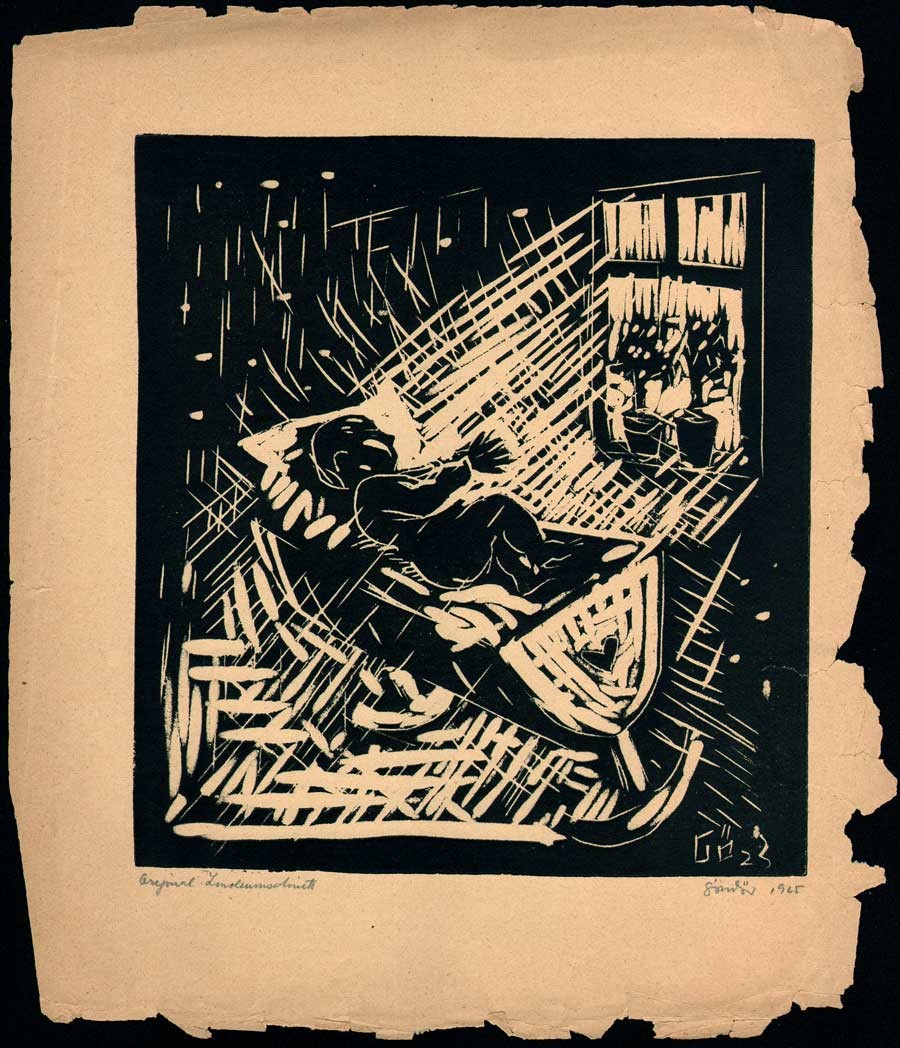 Linoleum cut: "Child in an Explosion of Light" : (20.5 x 18.8 cm impression | 28.9 x 24.8 paper) 1925 print by Emery Gondor, American (b. Hungary) : included in unpublished folio: "Sehnsucht nach Licht" (Yearning for Light) : "8 Original Linoleum schnitte von Emerich Göndör" (8 original Linoleum cuts by Emerich Göndör) from: PhotoSeed Archive
Linoleum cut: "Child in an Explosion of Light" : (20.5 x 18.8 cm impression | 28.9 x 24.8 paper) 1925 print by Emery Gondor, American (b. Hungary) : included in unpublished folio: "Sehnsucht nach Licht" (Yearning for Light) : "8 Original Linoleum schnitte von Emerich Göndör" (8 original Linoleum cuts by Emerich Göndör) from: PhotoSeed Archive
Sobering in hindsight of course. What true artist in their own mind could “tactfully refrain from “any non-artistic, non-photographic activities” during the course of his or her work? Fortunately for us, Emery Gondor had a bit of luck going his way as well, with earlier examples of his artistic legacy preserved here for posterity and later career achievements benefiting those children he helped and inspired a testament to the abundant light emanating from his own oversized heart and soul.
David Spencer- October, 2015
Notes:
1. background: Emery Gondor: Biographical/Historical Note: from: Emery I. Gondor Collection: Leo Baeck Institute online archive accessed Oct. 2015. In Gondor’s 1954 application to publisher Doubleday for his book Art and Play Therapy published the same year, it stated he “is a sensitive clinician of long and varied experience. Early in his career he had no intention of becoming a psychologist or psychotherapist, but began as an artist and teacher of art after attending the Royal Hungarian University and receiving his diplomas from the Federal Academy of Art in Budapest. As a young art teacher, however, he was faced with the misery of children who suffered tremendously during and after the first World War, and felt that he had to understand more about their problems in order to be able to help them. Thus began his interest in the study of psychology.”
2. PM: 1936: Mr. Gondor comes to America: p. 7
3. Germinal, a quarto monthly ran for two issues in July, 1923 and one other unknown issue published in 1924. “This illustrated journal published fiction by Gorky, drama by Ernest Toller, poetry by Alexander Blok, by Anna Akhmatova and by Pankhurst.” see: Morag Shiach: Modernism, Labour and Selfhood in British Literature and Culture, 1890-1930: Sylvia Pankhurst: labour and representation: 2004: p. 103
4. see: The Germinal Circle: Leo Baeck Institute Archives: New York: Folder 1/16: Call number AR 25397
5. translated, hand-written copy of Sept 7, 1935 letter by editor Hartmuth Merleker contained in Leo Baeck Institute online archives.
Some Summer Sculling
Posted August 2015 in Hand Cameras
Presenting a Summer idyll on the River Thames.
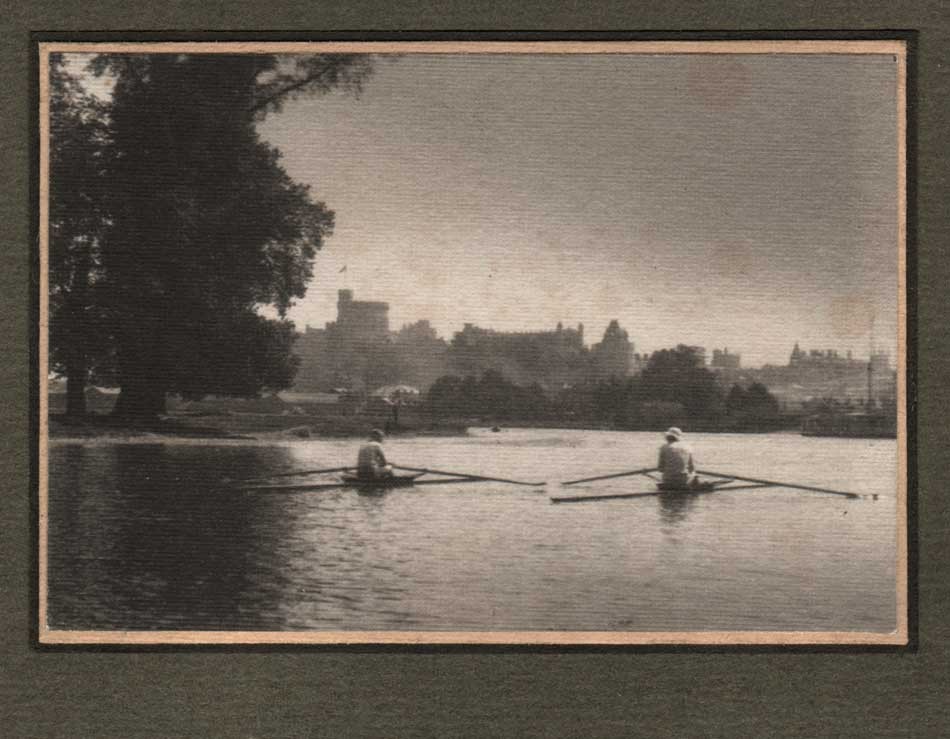 "Windsor Castle" (River Thames) August, 1904: R.R. Rawkins, English: platinum print 5.2 x 7.7 cm on 30.6 x 25.0 cm mount: print #19 from the Hand Camera Postal Club portfolio for 1904: R.R. Rawkins (Ralph Rowland Rawkins 1874-1951) Honorary Secretary: details: taken with a Pony Premo 5 x4 camera on Kodak film, 1/100th shutter; printed on Willis & Clements Platinum CC paper & matted by pressure. from: PhotoSeed Archive
"Windsor Castle" (River Thames) August, 1904: R.R. Rawkins, English: platinum print 5.2 x 7.7 cm on 30.6 x 25.0 cm mount: print #19 from the Hand Camera Postal Club portfolio for 1904: R.R. Rawkins (Ralph Rowland Rawkins 1874-1951) Honorary Secretary: details: taken with a Pony Premo 5 x4 camera on Kodak film, 1/100th shutter; printed on Willis & Clements Platinum CC paper & matted by pressure. from: PhotoSeed ArchiveA Happy 4th to All
Posted July 2015 in Childhood Photography, New Additions
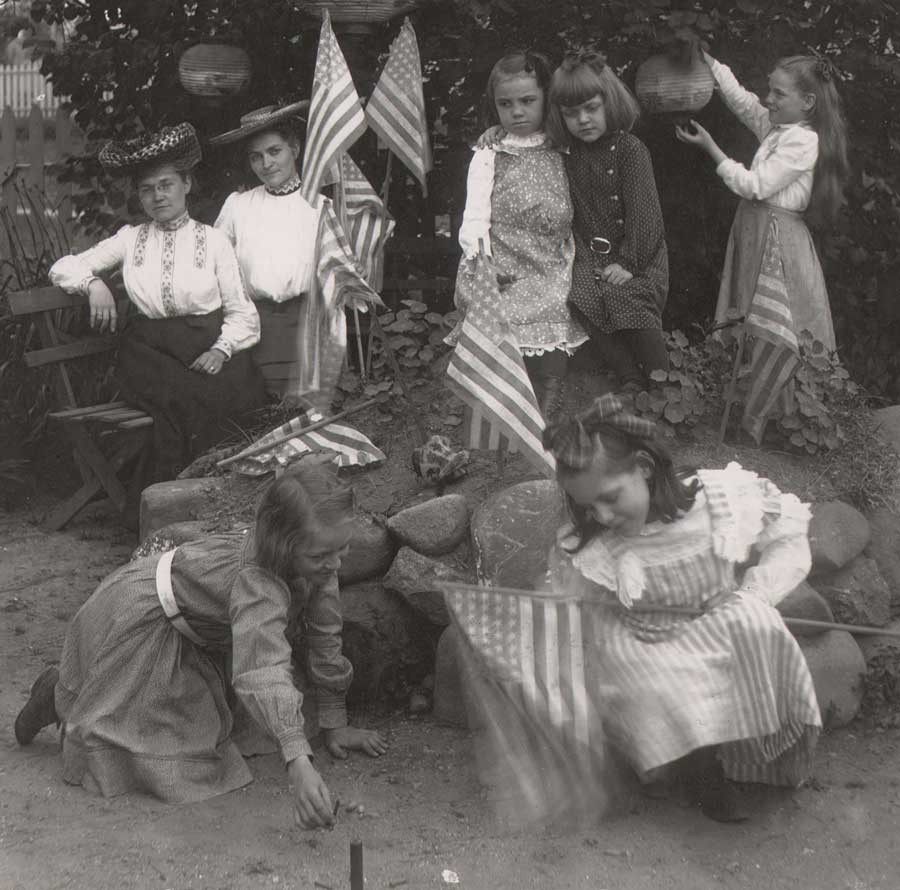 Detail: "4th of July", c. 1905 by Jeanette Bernard: American, born Germany: (1855-1941) gelatin silver print c. 1935-40 from original glass plate negative acquired by Culver Service : 18.7 x 16.1 cm: from PhotoSeed Archive
Detail: "4th of July", c. 1905 by Jeanette Bernard: American, born Germany: (1855-1941) gelatin silver print c. 1935-40 from original glass plate negative acquired by Culver Service : 18.7 x 16.1 cm: from PhotoSeed Archive
Nature's Camera
Posted May 2015 in Alternate Processes, History of Photography, Scientific Photography
Spring, that time of rebirth for the temperate regions of the world, is thankfully showing itself off again. With new growth on trees, flowers showing off and the lingering sweet smells of airborne pollen, these are but a few signs of the season.
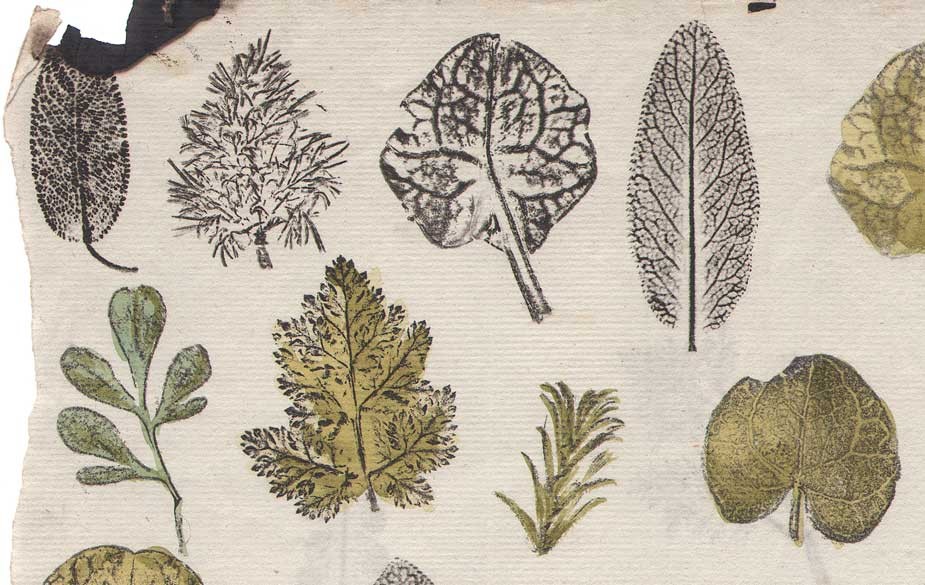 Detail: Nature prints: English: unknown maker: (recto) leaf specimens with selective hand-coloring: ca. 1775-1825: 30.5 x 38.3 cm: laid paper leaf (separated) with Britannia shield and C&S watermarks. from: PhotoSeed Archive
Detail: Nature prints: English: unknown maker: (recto) leaf specimens with selective hand-coloring: ca. 1775-1825: 30.5 x 38.3 cm: laid paper leaf (separated) with Britannia shield and C&S watermarks. from: PhotoSeed Archive
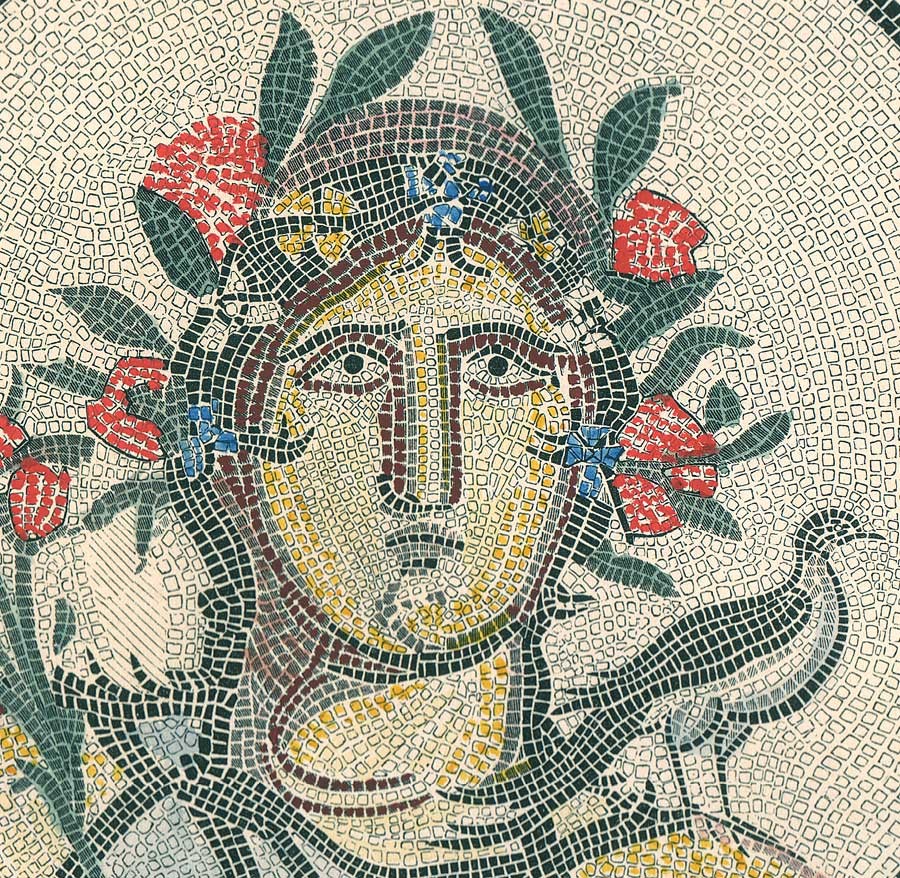 Detail: "Flora", the Roman goddess of Spring and flowers: 1850: hand-colored lithograph from Talbotype by Philip Henry Delamotte (1821-1889) of hand-drawn and colored tracing of Roman mosaic (mid 2nd Century A.D.) at Cirencester, England. 14.5 x 10.2 cm: reproduced as plate V in: "Illustrations of the Remains of Roman Art, in Cirencester, The Site of Antient Corinium": London. This floor mosaic of Flora was one of three seasonal mosaics excavated at Cirencester in 1849. From: PhotoSeed Archive
Detail: "Flora", the Roman goddess of Spring and flowers: 1850: hand-colored lithograph from Talbotype by Philip Henry Delamotte (1821-1889) of hand-drawn and colored tracing of Roman mosaic (mid 2nd Century A.D.) at Cirencester, England. 14.5 x 10.2 cm: reproduced as plate V in: "Illustrations of the Remains of Roman Art, in Cirencester, The Site of Antient Corinium": London. This floor mosaic of Flora was one of three seasonal mosaics excavated at Cirencester in 1849. From: PhotoSeed Archive
As children, our very first “photographs” joyously executed in winter climes would have taken the form of angelic impressions left in the newly fallen snow, or tropical: designs left on sandy seashores.
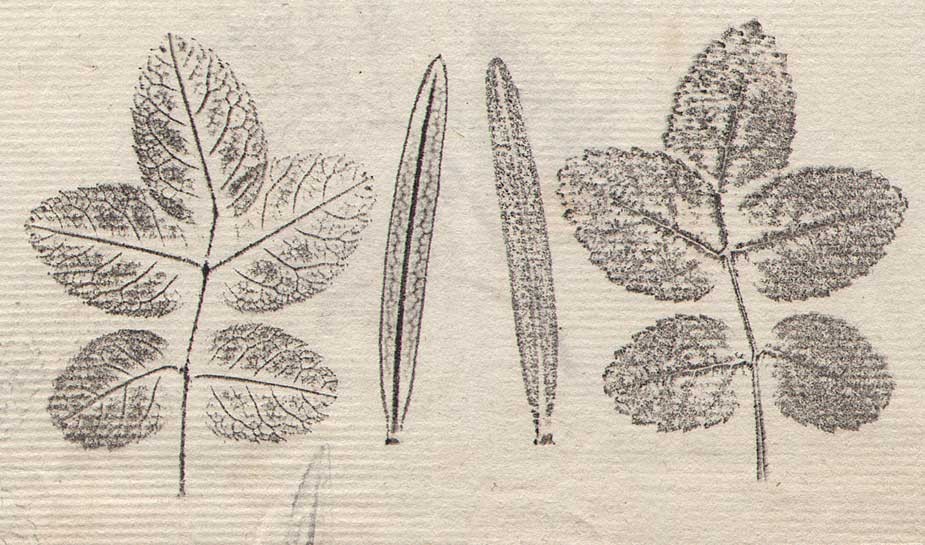 Detail: Nature prints: English: unknown maker: mirror impression of unknown grass and leaf cluster specimens: ca. 1775-1825: 30.5 x 38.3 cm: laid paper leaf (separated) with Britannia shield and C&S watermarks. from: PhotoSeed Archive
Detail: Nature prints: English: unknown maker: mirror impression of unknown grass and leaf cluster specimens: ca. 1775-1825: 30.5 x 38.3 cm: laid paper leaf (separated) with Britannia shield and C&S watermarks. from: PhotoSeed Archive
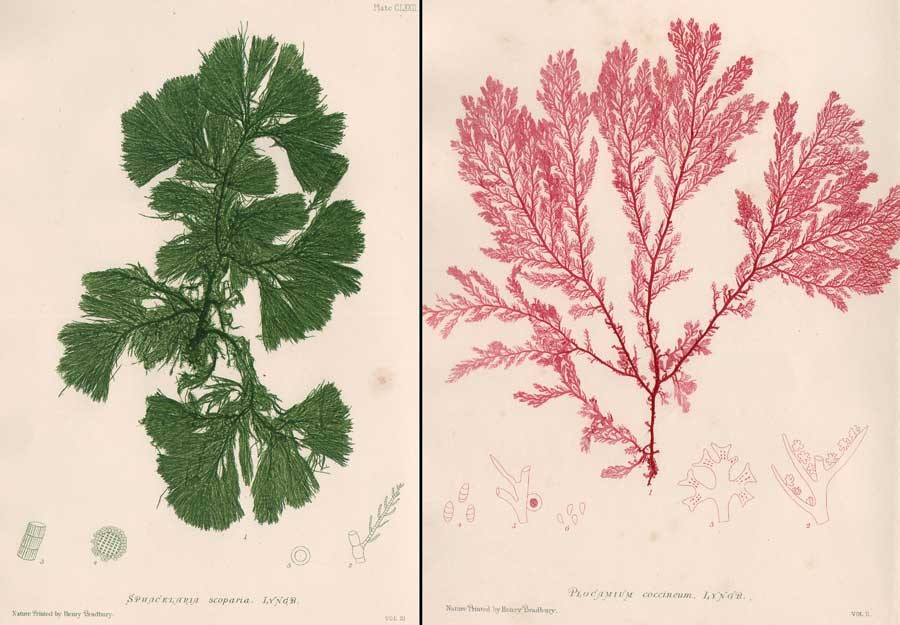 Examples of nature-printed British Seaweeds printed in intaglio by Henry Bradbury, English. (1831-1860) Left: Sphacelaria Scoparia Lyngb.: 1860; 23.9 x 15.5 cm: plate CLXXII from vol. III: "The Nature-Printed British Sea-Weeds: A History, Accompanied by figures and dissections, of the algae of the British Isles" : London: Bradbury and Evans. Right: Plocamium Coccineum, Lyngb.: 1859; 23.9 x 15.5 cm: plate LXVIII from vol. II: "The Nature-Printed British Sea-Weeds": Bradbury's technique commercialized nature printing for the masses-he adapted an 1852 process invented by Viennese engravers Alois Auer and Andreas Worring creating a matrix by placing botanical specimens between a sheet of soft lead and steel which were then electroplated, inked and printed. from: PhotoSeed Archive
Examples of nature-printed British Seaweeds printed in intaglio by Henry Bradbury, English. (1831-1860) Left: Sphacelaria Scoparia Lyngb.: 1860; 23.9 x 15.5 cm: plate CLXXII from vol. III: "The Nature-Printed British Sea-Weeds: A History, Accompanied by figures and dissections, of the algae of the British Isles" : London: Bradbury and Evans. Right: Plocamium Coccineum, Lyngb.: 1859; 23.9 x 15.5 cm: plate LXVIII from vol. II: "The Nature-Printed British Sea-Weeds": Bradbury's technique commercialized nature printing for the masses-he adapted an 1852 process invented by Viennese engravers Alois Auer and Andreas Worring creating a matrix by placing botanical specimens between a sheet of soft lead and steel which were then electroplated, inked and printed. from: PhotoSeed Archive
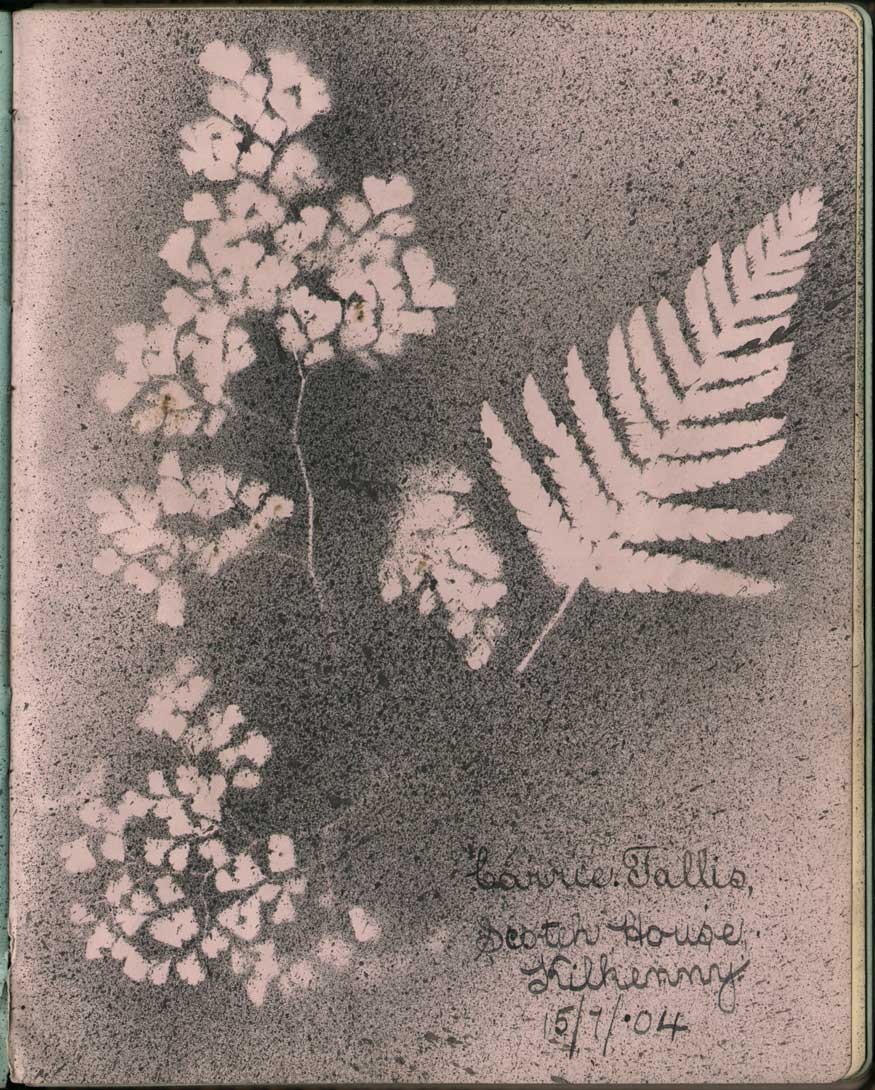 "Ink Splatter Photogram of Fern and Flowers on Paper", 1904: by amateur Irish artist Caroline Emily Tallis, (1889-1972) (21.9 x 17.2 cm): single page from English or Irish compiled Edwardian album signed lower right: "Carrie Tallis, Scotch House Kilkenny 15/7/04": from: PhotoSeed Archive
"Ink Splatter Photogram of Fern and Flowers on Paper", 1904: by amateur Irish artist Caroline Emily Tallis, (1889-1972) (21.9 x 17.2 cm): single page from English or Irish compiled Edwardian album signed lower right: "Carrie Tallis, Scotch House Kilkenny 15/7/04": from: PhotoSeed ArchiveOur very own Pencils of Nature.
An impression of ourselves for sure, but also quickly obliterated-or not, like nature herself. Photography in this form has in a way been part of Earth’s plant and animal fossil record stretching back millions of years, with Mankind’s permanent efforts barely stretching back to the early 19th Century.
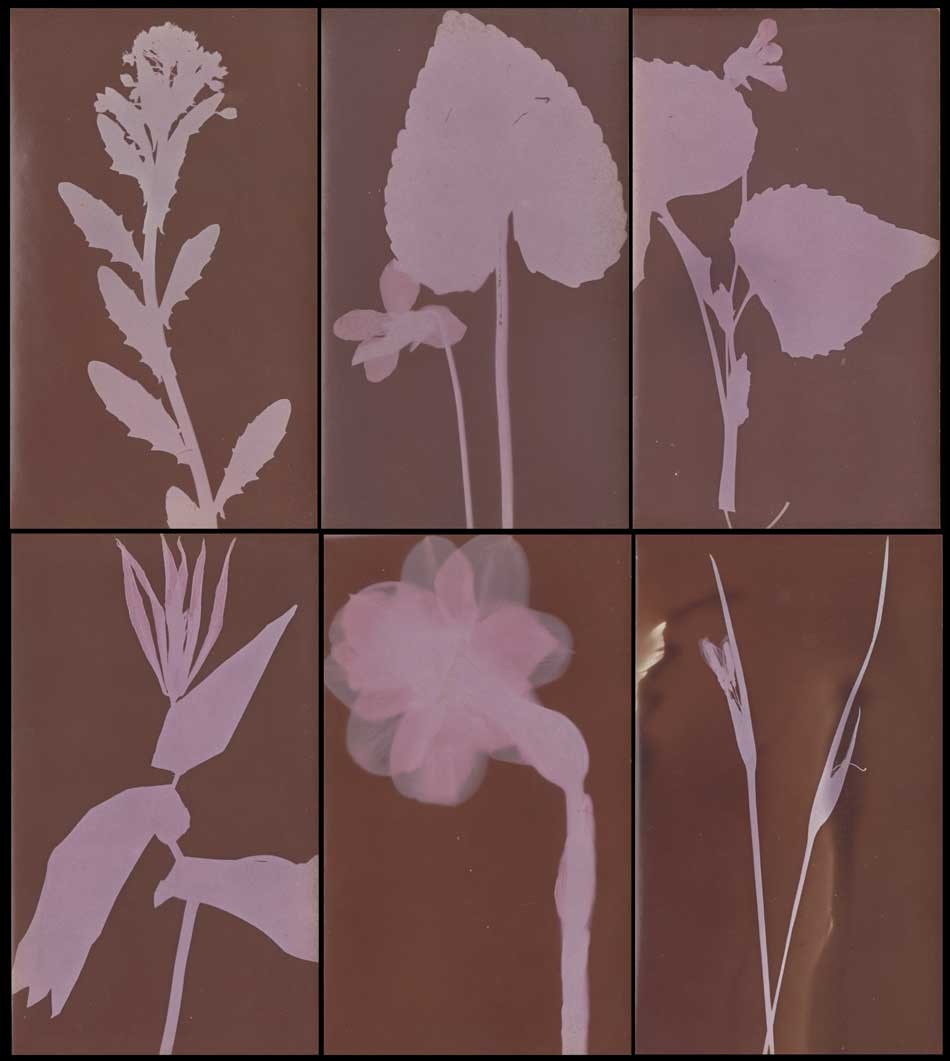 (6) individual Photograms, ca. 1925, by unknown American photographer on Kodak Self-Toning, single-weight glossy paper. (gelatin-silver developing out paper) each: 10.8 x 6.4 cm. Even before he discovered how to permanently "fix" what eventually became known as paper photographs in order to prevent their fading, Englishman William Henry Fox Talbot (1800-1877) first used his Photogenic Drawing method in 1834 to produce photograms. To do this he first placed a botanical specimen on a sheet of salt and silver nitrate-coated sheet of writing paper which produced a temporary, exact image of it when exposed to the Sun. Soon after, the lustrous blue Cyanotype process, perhaps best known today by the artistic plant studies perfected by Englishwoman Anna Atkins (1799-1871) made between 1843-53, gave way to even cheaper commercial methods for the photogram. Using store-bought, pre-sensitized photographic paper which home darkroom hobbyists readily exploited-similar to these examples- the art form was popularized even more in the early 20th Century. Specimens: top row, left to right: Shepherd's Purse, Purple Violet, Yellow Violet; Bottom row, left to right: Bell Wort, Narcissus, Blue-Eyed Grass. all from: PhotoSeed Archive
(6) individual Photograms, ca. 1925, by unknown American photographer on Kodak Self-Toning, single-weight glossy paper. (gelatin-silver developing out paper) each: 10.8 x 6.4 cm. Even before he discovered how to permanently "fix" what eventually became known as paper photographs in order to prevent their fading, Englishman William Henry Fox Talbot (1800-1877) first used his Photogenic Drawing method in 1834 to produce photograms. To do this he first placed a botanical specimen on a sheet of salt and silver nitrate-coated sheet of writing paper which produced a temporary, exact image of it when exposed to the Sun. Soon after, the lustrous blue Cyanotype process, perhaps best known today by the artistic plant studies perfected by Englishwoman Anna Atkins (1799-1871) made between 1843-53, gave way to even cheaper commercial methods for the photogram. Using store-bought, pre-sensitized photographic paper which home darkroom hobbyists readily exploited-similar to these examples- the art form was popularized even more in the early 20th Century. Specimens: top row, left to right: Shepherd's Purse, Purple Violet, Yellow Violet; Bottom row, left to right: Bell Wort, Narcissus, Blue-Eyed Grass. all from: PhotoSeed Archive
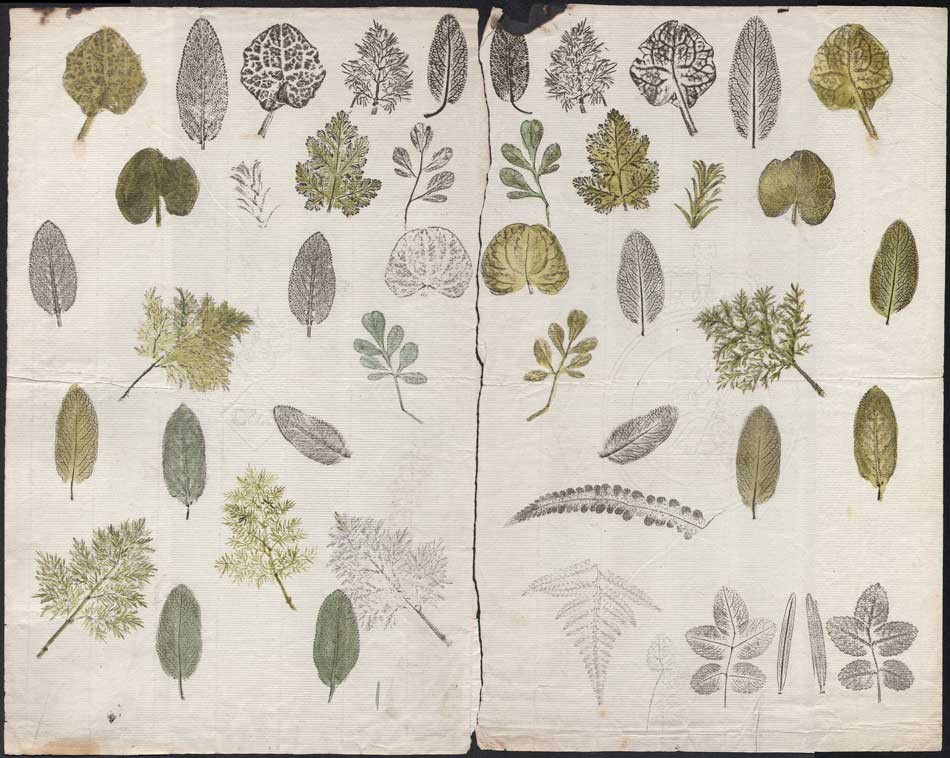 Nature prints: English: unknown maker: ca. 1775-1825: multiple, mirror impressions of unknown grass and leaf cluster specimens done with black printers ink & selective hand-coloring on laid paper leaf. (separated at middle) Britannia shield and C&S watermarks: 30.5 x 38.3 cm. Addressing an 1857 meeting of the Royal Society of the Arts, English Aesthetic Movement designer Christopher Dresser (1834-1904) gave the following historical account of the art of nature printing, of which this sheet is a rare surviving example, although ink rather than carbon black was used: "The earliest mode with which we are acquainted of producing impressions of plants was this:—The plant, after being dried, was held over the smoke of a candle or oil lamp, when it became blackened by a deposit of soot, after which it was placed between two sheets of paper and rubbed with a smoothing-bone, which caused the soot to leave the prominences of the leaf and adhere to the paper. In this way an impression of the plant was produced. This method of procuring impressions was employed as early as the year A.D. 1650." from: PhotoSeed Archive
Nature prints: English: unknown maker: ca. 1775-1825: multiple, mirror impressions of unknown grass and leaf cluster specimens done with black printers ink & selective hand-coloring on laid paper leaf. (separated at middle) Britannia shield and C&S watermarks: 30.5 x 38.3 cm. Addressing an 1857 meeting of the Royal Society of the Arts, English Aesthetic Movement designer Christopher Dresser (1834-1904) gave the following historical account of the art of nature printing, of which this sheet is a rare surviving example, although ink rather than carbon black was used: "The earliest mode with which we are acquainted of producing impressions of plants was this:—The plant, after being dried, was held over the smoke of a candle or oil lamp, when it became blackened by a deposit of soot, after which it was placed between two sheets of paper and rubbed with a smoothing-bone, which caused the soot to leave the prominences of the leaf and adhere to the paper. In this way an impression of the plant was produced. This method of procuring impressions was employed as early as the year A.D. 1650." from: PhotoSeed Archive
Enjoy this gallery of images celebrating the beauty of flora. From original Nature Prints ca. 1775-1825: inked leaves placed between a sheet of paper and pulled through a printing press; to mosaic red flowers adorning the head of a Roman goddess imagined by an artist around 250 A.D. transcribed and copied by the radical Talbotype process and published in 1850; to delicate British seaweeds copied into lead and printed 1859-60 to modern examples still nearly a century old: six silhouetted jewels ca. 1925 from the time photographic hobbyists gazed in wonderment at their first efforts emerging from developer trays in home darkrooms.
The Idea of Hawaii
Posted April 2015 in History of Photography, New Additions, Typography
In the public consciousness at least, Hawaii has probably not changed too much in the past 100 years. By this I mean an island chain of magnificent tropical beauty, mystery, and earthly delights with a strong emphasis on the natural world being the preferred vision for this place for many of us; with the realities of crime, squalor and all the other maladies undoubtedly present on some scale cast aside for the sake of bliss. You see, in this chaotic world, people need and want to believe utopia by the name Hawaii must exist.
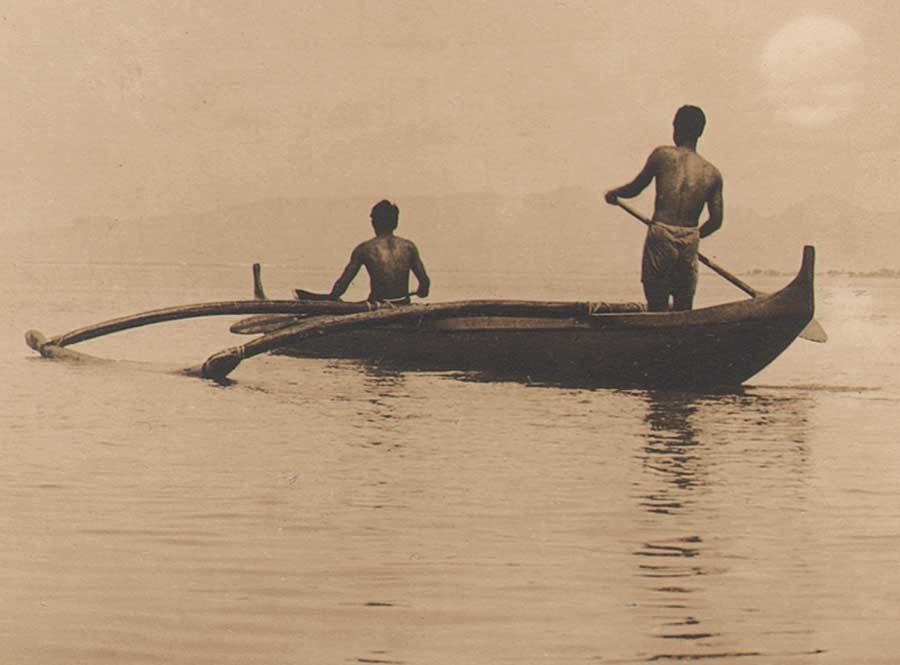 Detail: A.R. Gurrey Jr., American: "In measured tones subdued and low…" ca. 1910-20: vintage gelatin silver print from leaf included in volume "Idyls of Hawaii" (10.2 x 11.6 | 25.0 x 19.8 cm) Native Hawaiians are seen steering an outrigger canoe, possibly on Kaneohe Bay off the coast of Oʻahu. : From: PhotoSeed Archive
Detail: A.R. Gurrey Jr., American: "In measured tones subdued and low…" ca. 1910-20: vintage gelatin silver print from leaf included in volume "Idyls of Hawaii" (10.2 x 11.6 | 25.0 x 19.8 cm) Native Hawaiians are seen steering an outrigger canoe, possibly on Kaneohe Bay off the coast of Oʻahu. : From: PhotoSeed Archive
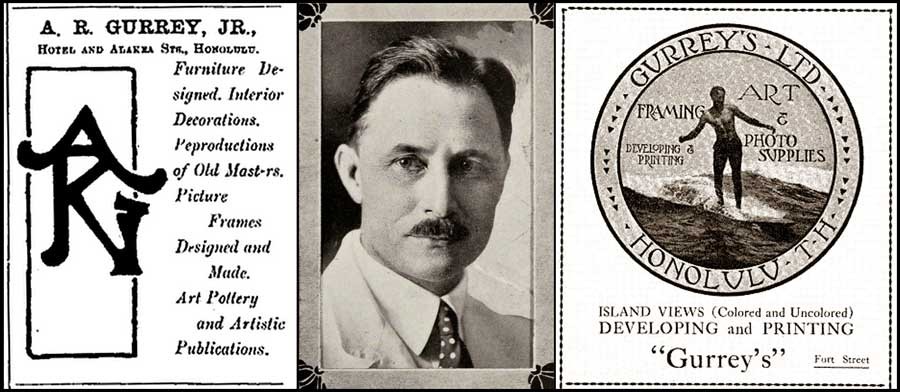 Left: first published version of A.R. Gurrey Jr. monogram from 1902 advertisement for his Honolulu store from "The Friend" magazine of that city. Middle: portrait of Gurrey Jr. published in "Men of Hawaii" from 1917. His WWI draft registration from 1918 listed his occupation as art dealer with his physical features being short, of medium build with gray eyes and brown hair. He lived with wife Caroline Haskins Gurrey, an accomplished portrait photographer, at 2512 Upper Manoa in Honolulu. Right: this circular logo for Gurrey's Ltd. located at 1066 Fort St. in Honolulu featured Duke Paoa Kahanamoku riding a surfboard. Open from late 1909 to 1923, the shop in a 1912 mention in Mid-Pacific magazine stated: "This Art and Photo Shop is the home of the Hawaiian Roycroftes, where you can see the work of the leading artists of the Islands, small views, native types and surfriders and other objects of art. Besides being the leading art shop, they are agents for the Ansco Cameras and Cyko Paper, with a developing and printing department that cannot be excelled." all images from: Hathi Trust.
Left: first published version of A.R. Gurrey Jr. monogram from 1902 advertisement for his Honolulu store from "The Friend" magazine of that city. Middle: portrait of Gurrey Jr. published in "Men of Hawaii" from 1917. His WWI draft registration from 1918 listed his occupation as art dealer with his physical features being short, of medium build with gray eyes and brown hair. He lived with wife Caroline Haskins Gurrey, an accomplished portrait photographer, at 2512 Upper Manoa in Honolulu. Right: this circular logo for Gurrey's Ltd. located at 1066 Fort St. in Honolulu featured Duke Paoa Kahanamoku riding a surfboard. Open from late 1909 to 1923, the shop in a 1912 mention in Mid-Pacific magazine stated: "This Art and Photo Shop is the home of the Hawaiian Roycroftes, where you can see the work of the leading artists of the Islands, small views, native types and surfriders and other objects of art. Besides being the leading art shop, they are agents for the Ansco Cameras and Cyko Paper, with a developing and printing department that cannot be excelled." all images from: Hathi Trust.
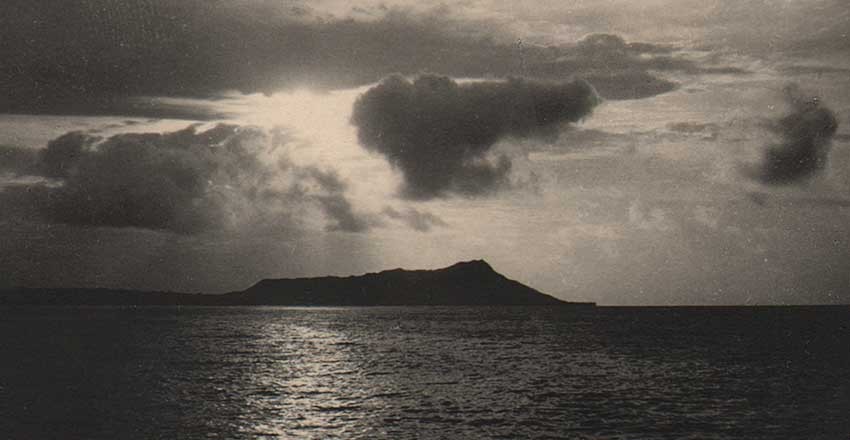 Detail: A.R. Gurrey Jr., American: "Old ocean singing a psalm of delight…" (ocean view of Diamond Head in silhouette) ca. 1910-20: vintage gelatin silver print from leaf included in volume "Idyls of Hawaii" (7.8 x 11.5 | 25.0 x 19.8 cm) : From: PhotoSeed Archive
Detail: A.R. Gurrey Jr., American: "Old ocean singing a psalm of delight…" (ocean view of Diamond Head in silhouette) ca. 1910-20: vintage gelatin silver print from leaf included in volume "Idyls of Hawaii" (7.8 x 11.5 | 25.0 x 19.8 cm) : From: PhotoSeed Archive
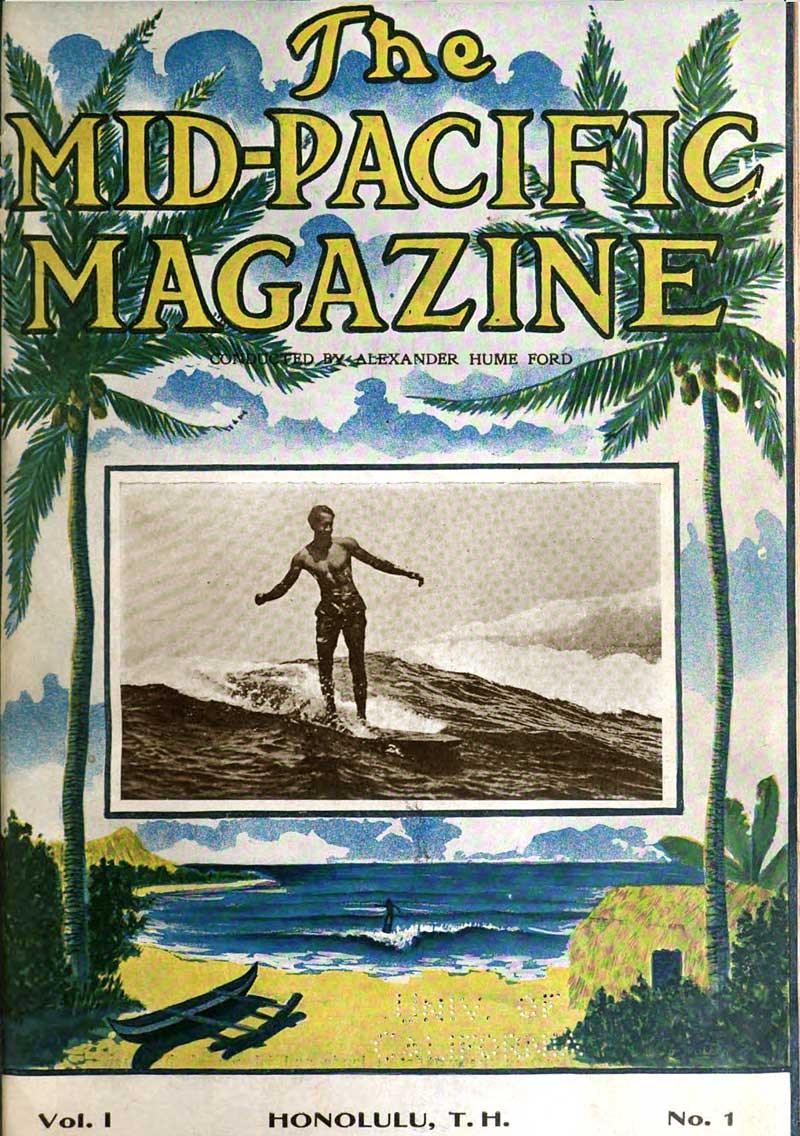 For the first issue of The Mid-Pacific Magazine in Jan., 1911, A.R.Gurrey Jr.'s photo from 1910 of Duke Kahanamoku riding a surfboard in Waikiki was published as part of the front color cover designed by artist Stuart S. Tabor. Acknowledged today as the father of surfing photography, Gurrey Jr.'s working methods in a 1912 article stated: "It necessitated going right out against the incoming surf, right at its height and meant invariably a swamping of the canoe and soaking for all in it. Mr. Gurrey felt amply repaid for his day's outing if at the end of the day he returned with his camera and one unspoiled negative out of twelve." from: Hathi Trust
For the first issue of The Mid-Pacific Magazine in Jan., 1911, A.R.Gurrey Jr.'s photo from 1910 of Duke Kahanamoku riding a surfboard in Waikiki was published as part of the front color cover designed by artist Stuart S. Tabor. Acknowledged today as the father of surfing photography, Gurrey Jr.'s working methods in a 1912 article stated: "It necessitated going right out against the incoming surf, right at its height and meant invariably a swamping of the canoe and soaking for all in it. Mr. Gurrey felt amply repaid for his day's outing if at the end of the day he returned with his camera and one unspoiled negative out of twelve." from: Hathi Trust
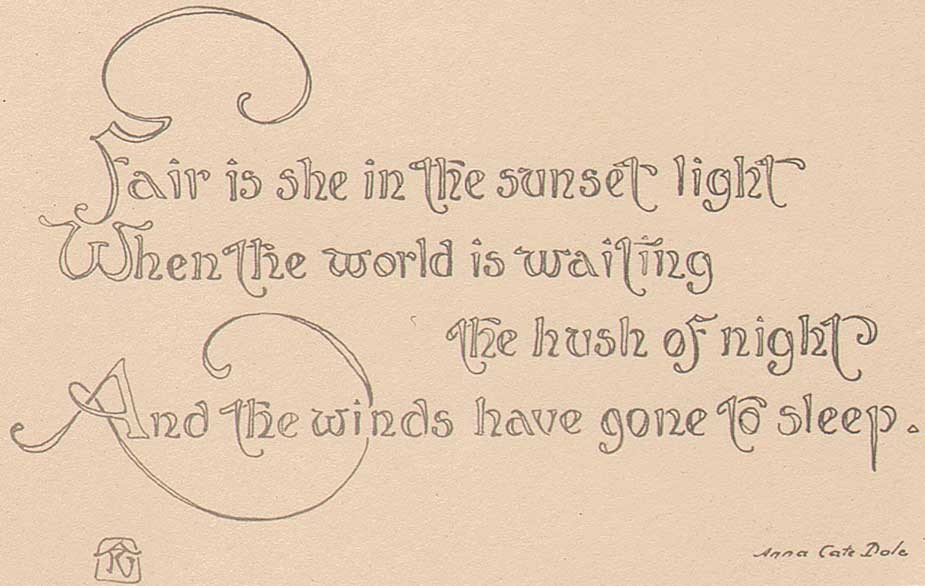 Detail: A.R. Gurrey Jr., American: photo-transfer of calligraphic text from poem "A Psalm for Hawaii" by Anna Cate Dole published in "Idyls of Hawaii" ca. 1910-20. Calligraphy was an important art-form practiced by Gurrey; so much so he often signed this work in "Idyls" using his stylized monogram seen above at lower left corner. from: PhotoSeed Archive
Detail: A.R. Gurrey Jr., American: photo-transfer of calligraphic text from poem "A Psalm for Hawaii" by Anna Cate Dole published in "Idyls of Hawaii" ca. 1910-20. Calligraphy was an important art-form practiced by Gurrey; so much so he often signed this work in "Idyls" using his stylized monogram seen above at lower left corner. from: PhotoSeed Archive
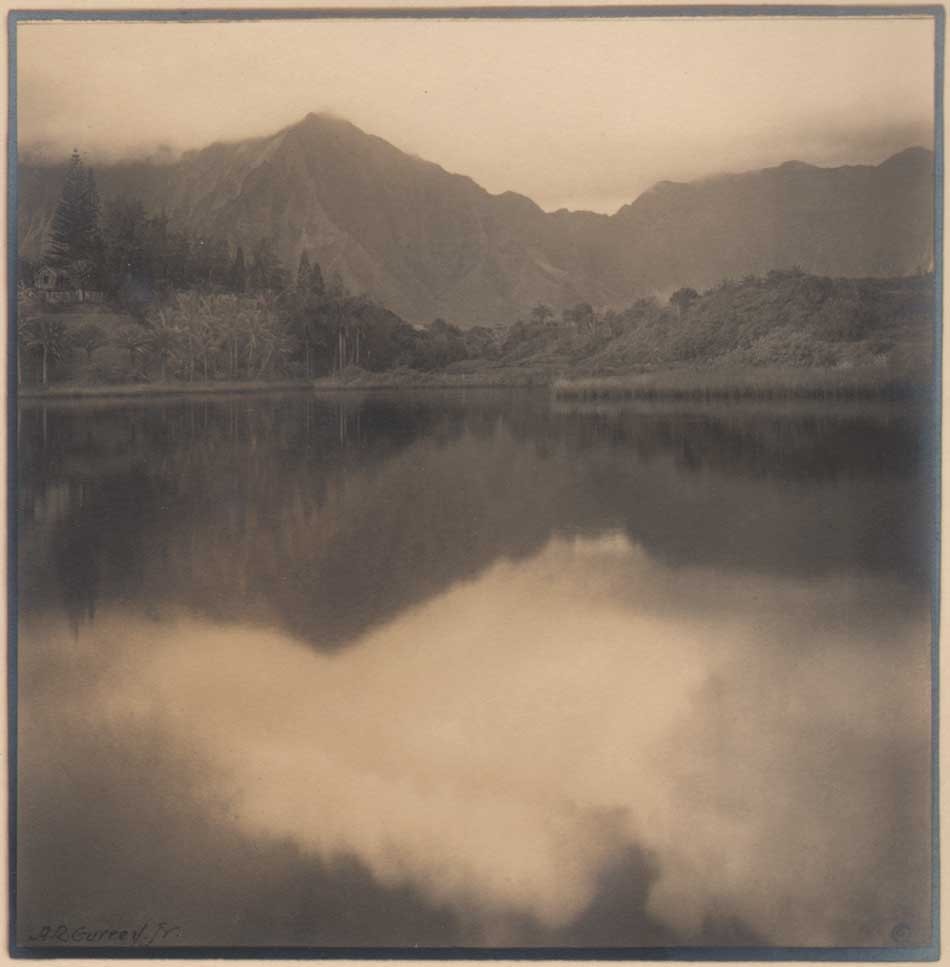 A.R. Gurrey Jr., American: "Fair is she in the morning light…" ca. 1910-20: vintage gelatin silver print used as frontis leaf included in volume "Idyls of Hawaii" (11.5 x 11.2 | 25.0 x 19.8 cm) Illustrating lines from the Anna Cate Dole poem "A Psalm for Hawaii" written ca. 1909, Gurrey's photograph of a mountainous Hawaiian landscape with her peaks and lake reflection shrouded in clouds confirms this place as idyllic. From: PhotoSeed Archive
A.R. Gurrey Jr., American: "Fair is she in the morning light…" ca. 1910-20: vintage gelatin silver print used as frontis leaf included in volume "Idyls of Hawaii" (11.5 x 11.2 | 25.0 x 19.8 cm) Illustrating lines from the Anna Cate Dole poem "A Psalm for Hawaii" written ca. 1909, Gurrey's photograph of a mountainous Hawaiian landscape with her peaks and lake reflection shrouded in clouds confirms this place as idyllic. From: PhotoSeed Archive
Photographer Alfred Richard Gurrey Jr. believed in that place. A Hawaiian transplant from San Francisco at the turn of the 20th Century, his beautiful photographs of the islands included in the self-published book Idyls of Hawaii ca. 1910-1920 now on this website is aptly titled, even if idyll is now spelled with two ls in the 21st. A truly renaissance man of the arts, his vision of beauty for a place we may never visit but hope to someday cannot help but give us all the hope we need in this hectic and often indifferent world- one where the idea of Hawaii can always be within reach. -David Spencer
Want to see more of this special place from long ago? click here
Step right up and see the show!
Posted March 2015 in New Additions, Significant Photographs
P.T. Barnum gave me permission. A recent news item that Ringling Bros. and Barnum & Bailey Circus would send their remaining ponderous performing pachyderms to a Florida retirement home by 2018 got me to thinking recently. Did I not possess in my archive one very old mysterious photograph of a stuffed elephant? Sure enough, I did.
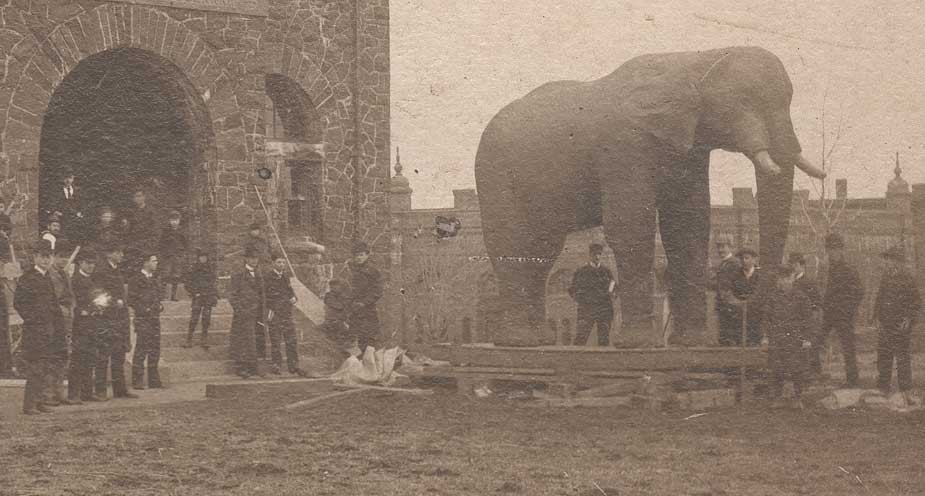 Detail: "Moving Jumbo into Barnum Museum, 1889" (assigned title by Tufts University Archives- see variant:ID: tufts:UA136.002.DO.00823 ): Attributed photographer: Charles Rollins Tucker, American (b. 1868): 1889: mounted brown-toned gelatin silver print on cabinet card: 8.3 x 11.0 cm | 10.8 x 13.2 cm. This rare photograph believed to have been taken on April 3, 1889 posthumously shows the famed circus elephant Jumbo (died 1885) formerly owned by circus showman P.T. Barnum sitting outside the Barnum Museum of Natural History on the Tufts College campus in Medford, Mass. before being placed on display. Vintage photograph from: PhotoSeed Archive.
Detail: "Moving Jumbo into Barnum Museum, 1889" (assigned title by Tufts University Archives- see variant:ID: tufts:UA136.002.DO.00823 ): Attributed photographer: Charles Rollins Tucker, American (b. 1868): 1889: mounted brown-toned gelatin silver print on cabinet card: 8.3 x 11.0 cm | 10.8 x 13.2 cm. This rare photograph believed to have been taken on April 3, 1889 posthumously shows the famed circus elephant Jumbo (died 1885) formerly owned by circus showman P.T. Barnum sitting outside the Barnum Museum of Natural History on the Tufts College campus in Medford, Mass. before being placed on display. Vintage photograph from: PhotoSeed Archive.
Looks kinda important.
Bunch of people standing outside a building… with a really big stuffed elephant.
Now to some Google “research”.
It’s Jumbo!
As in: “Jumbo was the greatest circus attraction in American history.” (1.)
So now I’m more interested in that old photo. But then it dawns on me: several years ago, I had purchased a trove of material taken by an amateur photographer named Charles Rollins Tucker. Never heard of him? Tufts College. Class of 1891. Bachelor of Philosophy with specialties in chemistry and physics, then a Master of Arts from the same institution in 1894. From Stoughton, Massachusetts, Tucker first resided in East Hall (room 26) on the Tufts campus after first matriculating in the Fall of 1887. Trust me. I know a great deal more, and eventually, time willing, you will too. Several photographs of his daughter Dorothy, (also a Tufts graduate) including “Girl with Kodak“ and an earlier study of her photographing her doll have been hiding in plain site on this website for several years now, and I eventually hope to show the progression of her growing up in a wonderful series of images taken by her father.
But now back to the main attraction, that old photograph. Like I said, Barnum would approve.
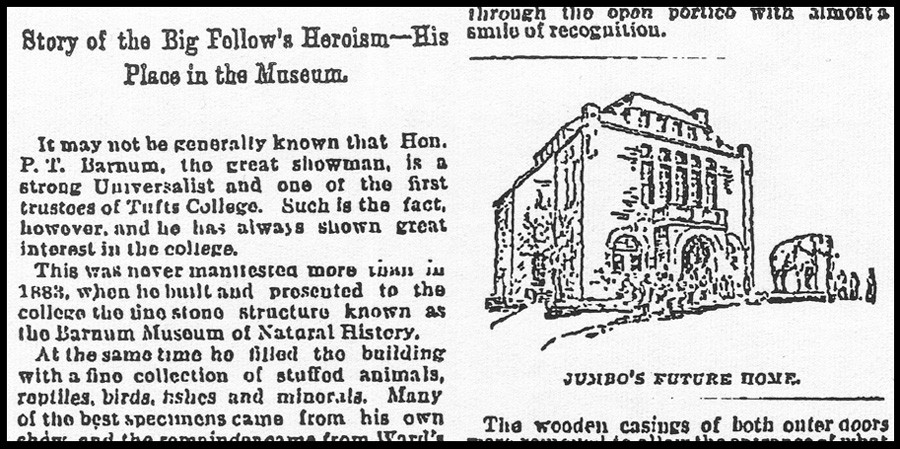 A woodcut taken from the Charles Tucker photograph of Jumbo before being placed on display inside the Barnum Museum of Natural History on the Tufts College campus on April 3, 1889 is one of two accompanying an article written by Tufts graduate and Boston Daily Globe reporter Julien C. Edgerly for the April 4, 1889 edition of the newspaper.
A woodcut taken from the Charles Tucker photograph of Jumbo before being placed on display inside the Barnum Museum of Natural History on the Tufts College campus on April 3, 1889 is one of two accompanying an article written by Tufts graduate and Boston Daily Globe reporter Julien C. Edgerly for the April 4, 1889 edition of the newspaper.
The Particulars
Jumbo, a word synonymous with someone or something very large or huge-especially so in the American lexicon, was an African elephant of immense proportions. According to Wikipedia, he was also the first “international animal superstar” after showman Phineas Taylor Barnum (1810-1891) purchased him from the London Zoo in 1882 for $10,000. However, in September of 1885, after entertaining North American circus audiences for a bit more than 3 years, he came to an inglorious end after being accidentally struck by a freight train after a Canadian performance.
Barnum being Barnum, a little thing like death was certainly not going to get in the way of Jumbo thrilling audiences while continuing to replenish his masters coffers- albeit in a more restrained and static way. An early trustee and munificent benefactor of the school, he gave it $55,000 in 1882 for the establishment of the Barnum Museum of Natural History on the campus, which was completed by 1884. Housing a museum of natural history showcasing a multitude of stuffed circus and zoological animal specimens as well as laboratories and classrooms, arrangements for Jumbo’s remains had been planned even while he was still alive. Overseeing the museum was John Marshall, the first professor of natural history at the school, who had presciently written to Henry A. Ward, Barnum’s taxidermist extraordinaire and owner of the “Natural Science Establishment” in Rochester, N.Y. two weeks before Jumbo’s death:
College Hill. Sep 1. 1885.
Dear Prof. Ward.
We fully expect to have the skin of Jumbo when he dies. Jumbo was excepted when the arrangement was made with the Smithsonian. I should not consider the Barnum Museum complete without this noble animal. It would be the greatest ornament that we could place in the Vestibule, near Mr. Barnum’s bust. Our front door to the Museum is [blank] feet high. You can judge whether the stuffed Jumbo would go in. It is wide enough, I think. Probably it would be necessary to stuff the skin in the vestibule. I have not decided upon the skeleton yet but will endeavor to let you know soon. - I think your offer to Mr. Barnum was $75 in exchange or $50 in money. Would you object to letting the $50 go towards the skulls? -
Yours very truly.
John P. Marshall (2.)
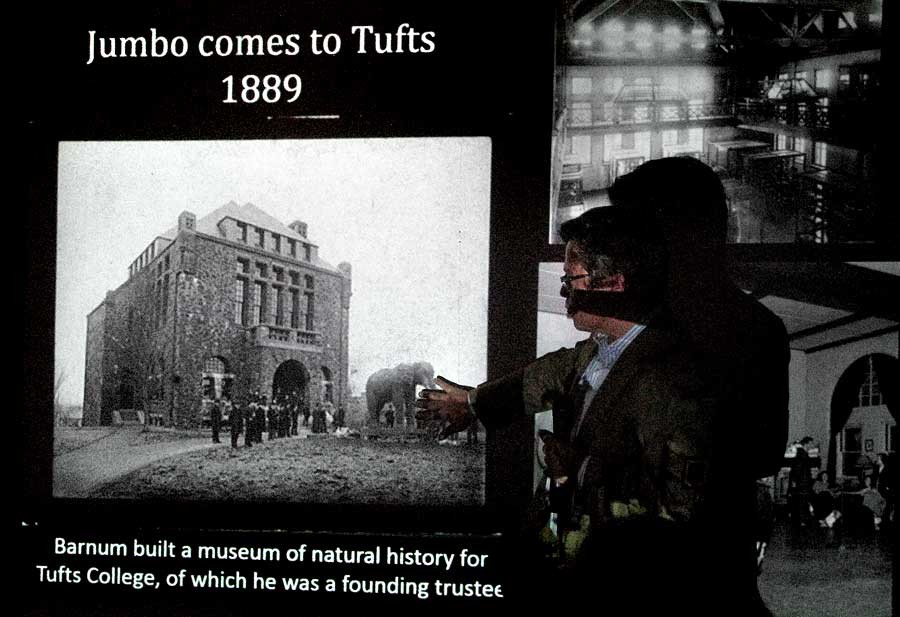 Tufts University Professor of Art History Dr. Andrew McClellan points to the photograph of the stuffed Jumbo before the elephant was placed on display inside the natural history museum on the Tufts campus in 1889 during a public lecture he gave at the Barnum Museum in Bridgeport, CT in April, 2015. In 2014, for the 125th anniversary of the arrival of Jumbo at Tufts, McClellan curated the life story of the famed elephant as part of the exhibit "Jumbo: Marvel, Myth, and Mascot", with the university publishing a pictorial monograph authored by him by the same title. Photo by David Spencer/PhotoSeed Archive
Tufts University Professor of Art History Dr. Andrew McClellan points to the photograph of the stuffed Jumbo before the elephant was placed on display inside the natural history museum on the Tufts campus in 1889 during a public lecture he gave at the Barnum Museum in Bridgeport, CT in April, 2015. In 2014, for the 125th anniversary of the arrival of Jumbo at Tufts, McClellan curated the life story of the famed elephant as part of the exhibit "Jumbo: Marvel, Myth, and Mascot", with the university publishing a pictorial monograph authored by him by the same title. Photo by David Spencer/PhotoSeed Archive
After Jumbo’s demise, Ward was dispatched to Canada in order to secure the animal’s remains, not an easy task. Arriving two days after the accident on Sept. 17, souvenir seekers had to be kept at bay by police:
In addition to the problem of size, Jumbo’s fame caused added complications. Relic seekers had done some damage before Ward arrived, and a policeman had been put on guard to prevent further mutilation. It took Ward, his assistants, and half a dozen butchers from St. Thomas, two days to dissect the elephant and prepare the hide and skeleton for shipment. The hide weighed 1,538 pounds, the bones 2,400 pounds. Coins of many kinds were found in Jumbo’s stomach, and Ward was quoted as having said that “Jumbo was a bank all by himself.” His stomach also contained rivets, a bunch of keys on a ring, a policeman’s whistle, and various ornaments. (3.)
By March of the following year, after his skin had been tanned and “scraped to a uniform thickness and nailed to a huge wooden framework with 74,480 nails”, (4.) Ward’s Natural Science Establishment delivered two finished mounts of Jumbo to Barnum at a reported cost of $1200.00: (5.) one of his skeleton and another for his hide. This stuffed version of Jumbo, after two additional years of touring with The Greatest Show on Earth, eventually made its’ way to Medford and the college via train after Barnum made the decision to (mostly) “retire” him from traveling circus life.
A Rare Survivor
With this mounted cabinet card seemingly the only photographic evidence of his arrival on campus, it must have been quite a sight to see all the steps taken to safely transport Jumbo by train, ferryboat and horse-drawn carriage on his final journey to Tufts. Beginning on Friday, March 29 from his winter home in Bridgeport, CT , Jumbo finally arrived in front of the Barnum museum at the college on Wednesday, April 3, 1889, with the final leg of the journey described as:
…” he was hauled to Tufts by a double team of horses. When that team proved unable to pull him up College Hill, more than 50 Tufts professors and students, aided by some local boys, completed the task.” (6.)
An alternate dispatch from 1888 Tufts graduate Julien C. Edgerly, (1865-1913) a reporter and news editor for the Boston Daily Globe newspaper who witnessed the famed elephants arrival on campus, wrote an article published in the edition for Thursday, April 4, 1889, illustrated by a small woodcut of the mounted cabinet card seen here. Conclusive proof it was taken by Tufts student Charles Rollins Tucker-albeit without being named directly-was included in Edgerly’s article. Some excerpts:
The mounted skin of Jumbo this morning stands in front of the museum on the top of College hill, as shown in the accompanying cuts, one of which shows the animal with a man at his side to give by contrast an idea of his size, and the other shows both Jumbo and the building which, barring the cadence of fortune, is destined to be his last long home. …
After Jumbo made his final journey, pulled by 6 horses up College Hill to the front doors of the Barnum Museum, the carriage he was riding on was “taken apart and drawn away.” … and:
The canvas coverings were removed to allow a student photographer to transfer his image to the plate of the camera. Several views were taken, some with ambitious young men upon the great beast’s back. Then the coverings were replaced and he will stand as lone sentinel till today when he will be placed inside the museum. He will occupy the centre of the large front room, facing the entrance. (7.)
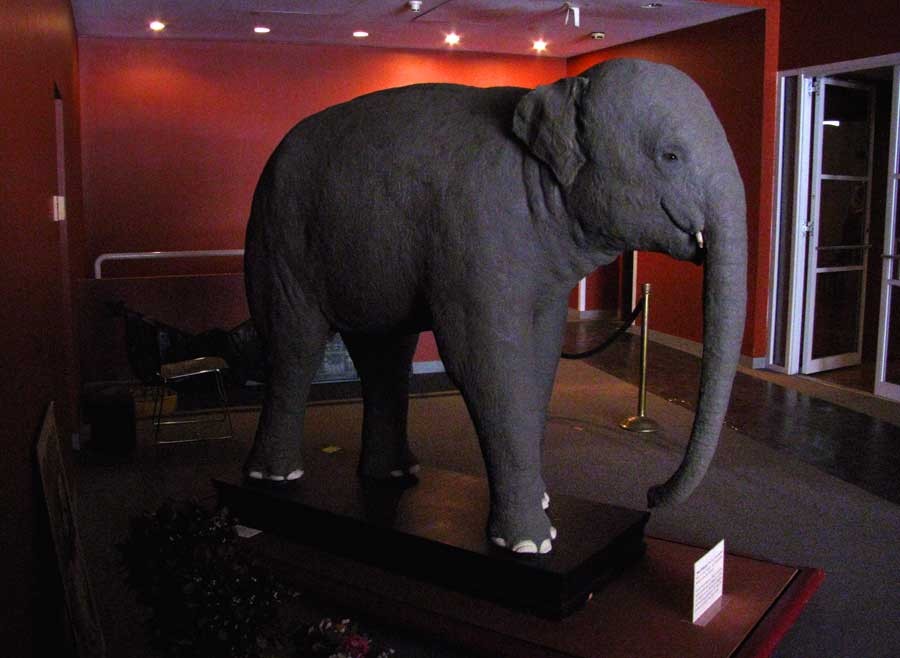 A survivor indeed. Standing nearly 7' and weighing 700 pounds, "Baby Bridgeport" is a preserved Asian elephant that was only the second elephant born in captivity in America owned by P.T. Barnum. Similarly mounted like Jumbo by taxidermist Henry Ward when he died at four years of age in 1886 and originally displayed alongside Jumbo inside the Barnum museum at Tufts in 1889, Baby Bridgeport continues to be a popular attraction for visitors to the Barnum Museum in Bridgeport, CT seen here in April, 2015. Photo by David Spencer/PhotoSeed Archive
A survivor indeed. Standing nearly 7' and weighing 700 pounds, "Baby Bridgeport" is a preserved Asian elephant that was only the second elephant born in captivity in America owned by P.T. Barnum. Similarly mounted like Jumbo by taxidermist Henry Ward when he died at four years of age in 1886 and originally displayed alongside Jumbo inside the Barnum museum at Tufts in 1889, Baby Bridgeport continues to be a popular attraction for visitors to the Barnum Museum in Bridgeport, CT seen here in April, 2015. Photo by David Spencer/PhotoSeed Archive
Professor Marshall, writing in the Annual Report of the President of Tufts College for 1889, also gave an interesting account of Jumbo’s arrival that day, commenting Jumbo had increased visitors to the museum among other observations:
Jumbo was brought to the Barnum Museum on Fast Day of the present year, and moved into the vestibule the following day. All the wood-work was removed from the great arch of the portico, leaving barely room for the entrance of the largest mounted elephant of modern times. It will be taken away, September 20, to be exhibited in London during the coming winter. About the first of April of next year, it will become a permanent attraction of the Museum. During the five months of its exhibition here the number of visitors to the Museum was largely increased. Your attention is again respectfully invited to the need of additional cases for the proper exhibition of specimens which have been accumulating during the past two years.
Respectfully submitted,
JOHN P. MARSHALL,
Director. Tufts College,
September 19, 1889. (8.)
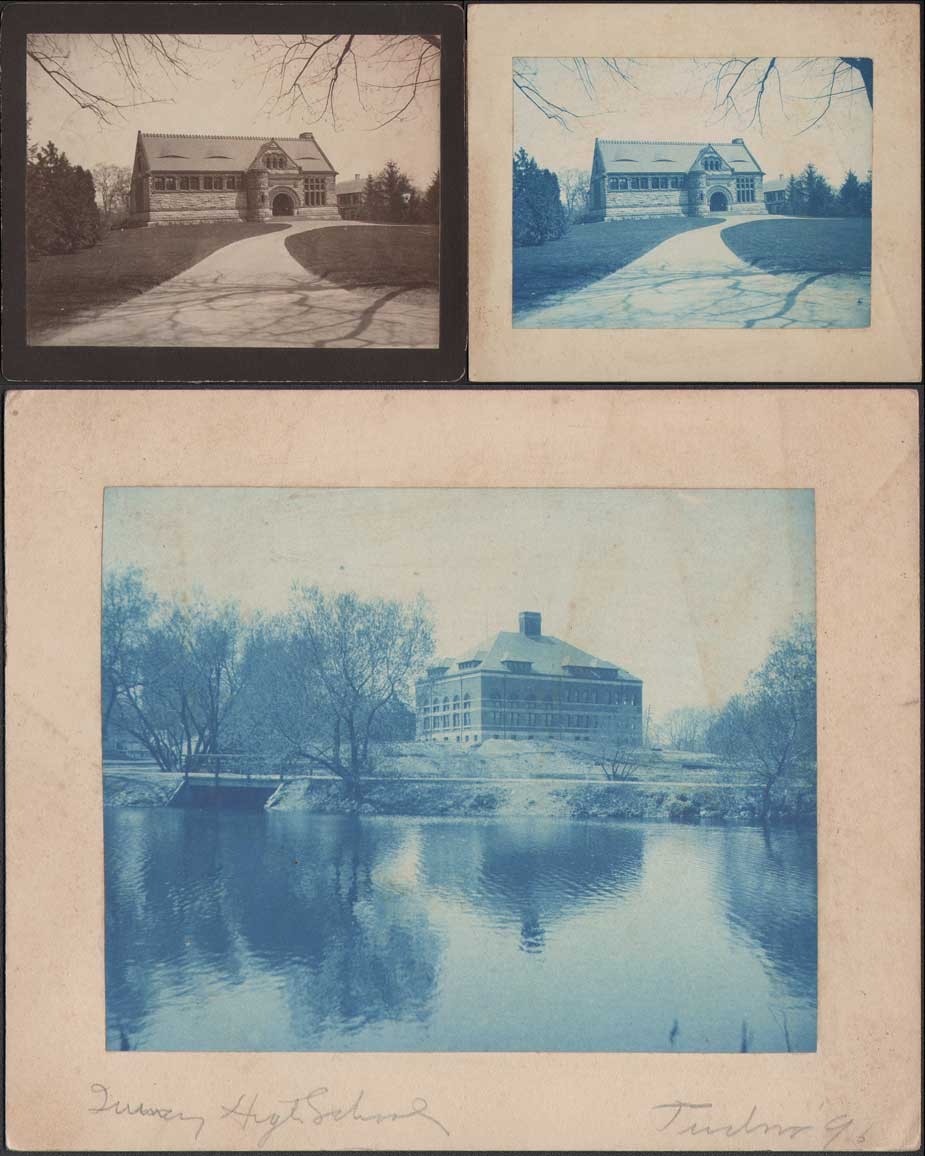 Top left: Exterior entrance view showing the Thomas Crane Public Library (built 1882) by architect Henry Hobson Richardson in Quincy, Mass. : Attributed photographer: Charles Rollins Tucker, American (b. 1868):Vintage brown-toned gelatin silver print on cabinet card: 9.0 x 11.8 cm | 10.8 x 13.2 cm. Top Right: Exterior entrance view showing the Thomas Crane Public Library (built 1882) by architect Henry Hobson Richardson in Quincy, Mass. : Attributed photographer: Charles Rollins Tucker, American (b. 1868): 1896: Vintage cyanotype print on cabinet card: 9.1 x 12.0 cm | 12.7 x 15.2 cm. Bottom: Exterior view of "Quincy High School" with pond in foreground: Signed lower right: "Tucker '96": Charles Rollins Tucker, American (b. 1868):Vintage cyanotype print on cabinet card: 9.4 x 11.9 cm | 12.7 x 15.3 cm. All from: PhotoSeed Archive
Top left: Exterior entrance view showing the Thomas Crane Public Library (built 1882) by architect Henry Hobson Richardson in Quincy, Mass. : Attributed photographer: Charles Rollins Tucker, American (b. 1868):Vintage brown-toned gelatin silver print on cabinet card: 9.0 x 11.8 cm | 10.8 x 13.2 cm. Top Right: Exterior entrance view showing the Thomas Crane Public Library (built 1882) by architect Henry Hobson Richardson in Quincy, Mass. : Attributed photographer: Charles Rollins Tucker, American (b. 1868): 1896: Vintage cyanotype print on cabinet card: 9.1 x 12.0 cm | 12.7 x 15.2 cm. Bottom: Exterior view of "Quincy High School" with pond in foreground: Signed lower right: "Tucker '96": Charles Rollins Tucker, American (b. 1868):Vintage cyanotype print on cabinet card: 9.4 x 11.9 cm | 12.7 x 15.3 cm. All from: PhotoSeed Archive
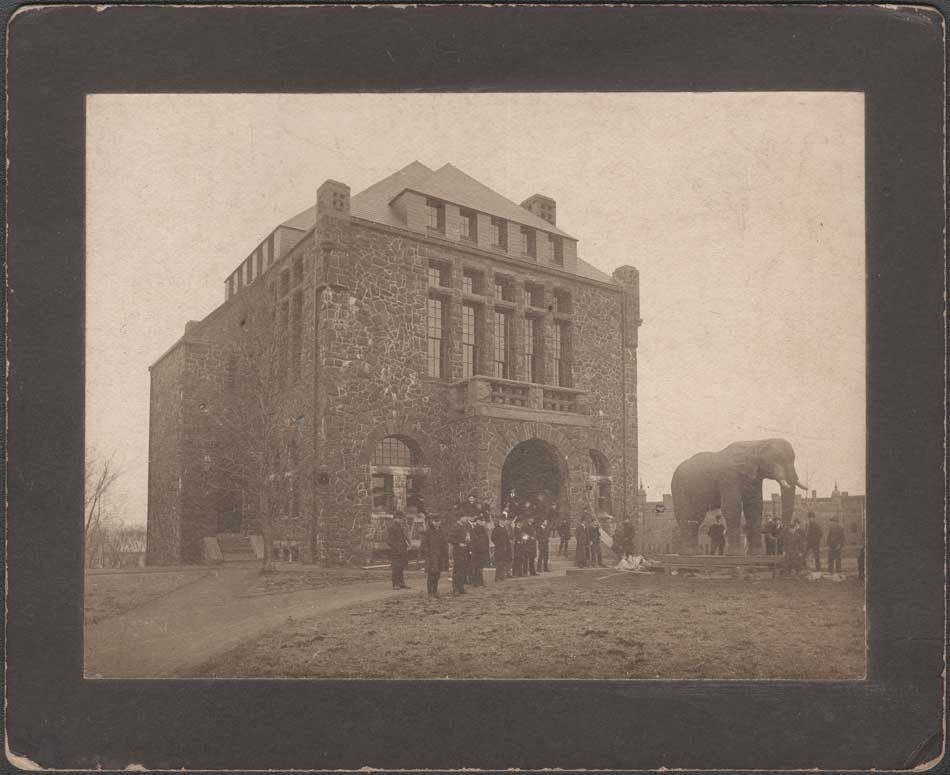 "Moving Jumbo into Barnum Museum, 1889" (assigned title by Tufts University Archives- see variant:ID: tufts:UA136.002.DO.00823 ): Attributed photographer: Charles Rollins Tucker, American (b. 1868): 1889: mounted brown-toned gelatin silver print on cabinet card: 8.3 x 11.0 cm | 10.8 x 13.2 cm. This rare photograph taken on April, 3 1889 posthumously shows the famed circus elephant Jumbo (died 1885) once owned by circus showman P.T. Barnum, now stuffed, sitting outside the Barnum Museum of Natural History on the Tufts College campus in Medford, Mass. before being placed on display. Vintage photograph from: PhotoSeed Archive.
"Moving Jumbo into Barnum Museum, 1889" (assigned title by Tufts University Archives- see variant:ID: tufts:UA136.002.DO.00823 ): Attributed photographer: Charles Rollins Tucker, American (b. 1868): 1889: mounted brown-toned gelatin silver print on cabinet card: 8.3 x 11.0 cm | 10.8 x 13.2 cm. This rare photograph taken on April, 3 1889 posthumously shows the famed circus elephant Jumbo (died 1885) once owned by circus showman P.T. Barnum, now stuffed, sitting outside the Barnum Museum of Natural History on the Tufts College campus in Medford, Mass. before being placed on display. Vintage photograph from: PhotoSeed Archive.
Picking up the Ashes
Jumbo has given back to Tufts, no pun intended, in a Huge way. Period accounts state he was immediately adopted as the school’s new mascot shortly after his arrival in 1889 and continues in that role today at Tufts University. The school website, semantics aside, brags Jumbo is the “only college mascot found in Webster’s Dictionary.” But alas, Jumbo endured a second death, this time by fire in 1975, when faulty wiring lead to a conflagration that gutted the 1884 Barnum museum. But all was not lost. Fortunately, the school’s archives held a section of Jumbo’s tail removed earlier because of students continual penchant for tugging on it, and a university staff member, while the rubble was still smoldering, had the smarts to scoop up some of his ashes that now reside in a Skippy peanut butter jar at the school. (nice trivia question- it’s secured with a Peter Pan Crunchy brand lid) Members of the sports teams on campus are said to rub this jar for good luck before an important game, and students indelible memories of college life at Tufts have been published every year since 1917 in the “Jumbo” yearbook.
With reporter Julien Edgerly’s account of a Tufts student photographer recording Jumbo for posterity in front of the museum on April 3, 1889, my argument and “Conclusive proof” Charles Rollins Tucker was that author working with Edgerly seems credible. For comparison, the Tufts archives holds a photograph dated 1889 showing Jumbo later on exhibit inside the museum credited to noted marine photographer N. L. Stebbins. (Nathaniel Livermore Stebbins-1847-1922) But given Jumbo’s immense fame, why is there no back-mark or other attribution for Stebbins for this exterior view of Jumbo? Surely, like one of his famous yachting studies, Stebbins would have insisted on it!
On his way to becoming a fine pictorialist photographer in the early 20th Century, Charles Tucker took a series of architectural photographs that survive in this archive which further gives credibility to his being responsible for the 1889 exterior Jumbo photograph. These include several examples seen above showing (ca. 1890-95) one of architect Henry Hobson Richardson’s masterpieces, the Thomas Crane Public Library (built 1882) located in Quincy, south of Boston. This is a gelatin silver mounted cabinet card using the same card-stock as the Jumbo photograph as well as a variant mounted cyanotype on a different paper stock. Finally, when he finished with his masters degree in late 1894 at Tufts, Tucker became sub-master until 1896 at Quincy High School- the same town as Richardson’s library. Two of his photographic views of this additionally survive, with a card-mounted, signed cyanotype by him dated 1896 seen here.
Notes:
1. excerpt: Step Right Up! : Bob Brooke presents the history of the circus in America : from: History Magazine: October/November 2001 issue: online version accessed March, 2015.
2. excerpt: Jumbo: by John R. Russell: in: University of Rochester Library Bulletin: vol. III, no. 1: Fall, 1947: River Campus Libraries online resource accessed March, 2015
3. Ibid
4. excerpt: Jumbo: Here and There at Tufts: Medford: Tufts College: Lewis Doane, Editor-in-chief: 1907: p. 44
5. excerpt: Jumbo: by John R. Russell: in: University of Rochester Library Bulletin: vol. III, no. 1: Fall, 1947: River Campus Libraries online resource accessed March, 2015
6. excerpt: Jumbo Matriculates: from: An Elephant’s Tale: Susan Wilson, J69, G75: Tufts online Magazine: Spring, 2002
7. The Boston Daily Globe: Thursday, April 4, 1889: p. 4
8. excerpt: Annual Report of the President of Tufts College: Boston: 1889: p. 36
Needle in a Haystack
Posted March 2015 in Advertising, Childhood Photography, Engraving, Publishing, Significant Photographers, Typography
Surreal would be a good word for it. On the evening of Friday, November 4, 1904, the touring company of the Broadway flop Eben Holden made its way to a performance at a building called the Auditorium on S. 2nd Street in downtown Newark, Ohio.
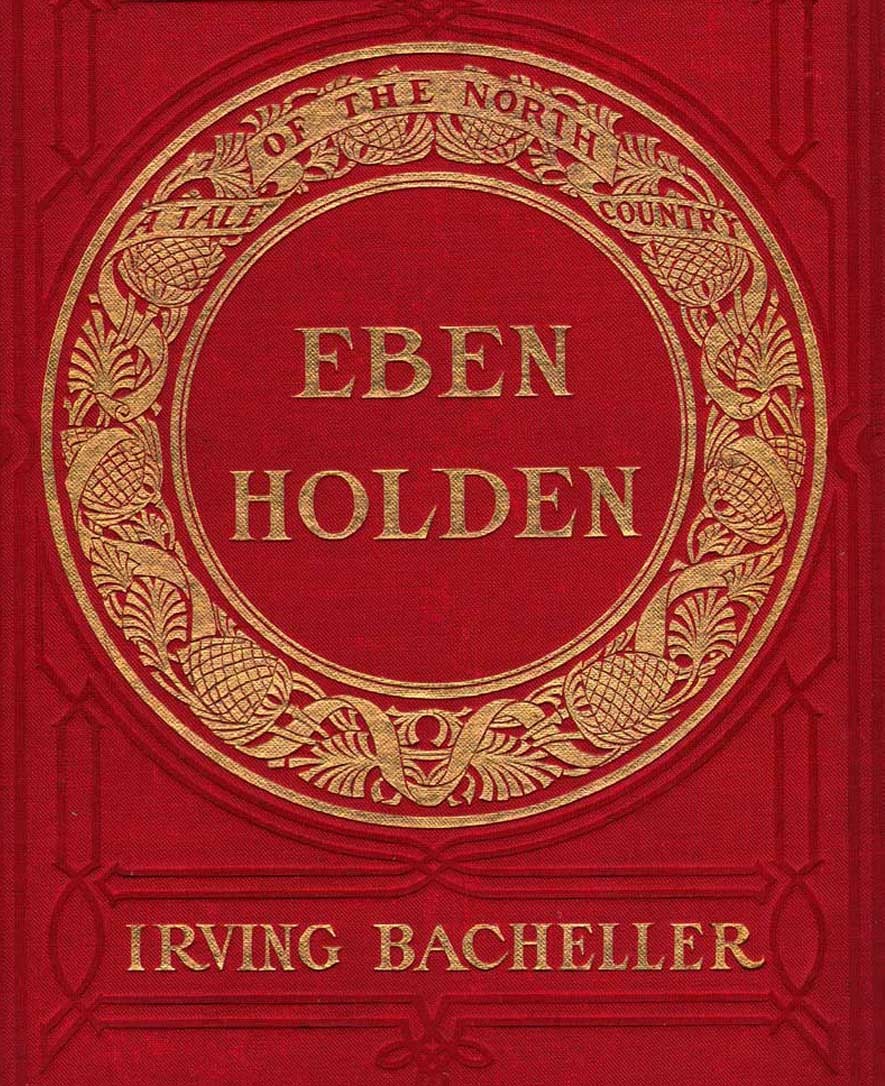 Detail: Cover for "Eben Holden: A Tale of The North Country": Edition de luxe by Irving Bacheller. Lothrop Publishing, Boston: 1903. Gilt-engraved decorative cloth with circular design featuring a design of a ribbon interlaced with pinecones and leaves: 21.0 x 14.2 cm: One of the best selling novels from the very beginning of the 20th Century, this edition features 12 photogravure plates by photographer Clarence Hudson White. from: PhotoSeed Archive
Detail: Cover for "Eben Holden: A Tale of The North Country": Edition de luxe by Irving Bacheller. Lothrop Publishing, Boston: 1903. Gilt-engraved decorative cloth with circular design featuring a design of a ribbon interlaced with pinecones and leaves: 21.0 x 14.2 cm: One of the best selling novels from the very beginning of the 20th Century, this edition features 12 photogravure plates by photographer Clarence Hudson White. from: PhotoSeed Archive
Most likely in attendance that night? Clarence Hudson White, (1871-1925) the world-renowned pictorialist photographer who was a recent founding member of the American Photo-Secession and current Newark resident. Only two years earlier, he had taken a series of photographs using his Newark neighbors as models for a special edition of Eben Holden that had been made into this very play.
Written by American journalist and author Irving Bacheller, (1859-1950) the story is a classic rags to riches tale that captivated the masses in the new American century when first published in July of 1900, eventually selling over 1 million copies. The setting at the beginning of the novel is the “North Country” of Northern Vermont , the Adirondack’s and St. Lawrence River Valley of the 1840’s and 1850’s. It tells the coming of age story of William Brower, orphaned at the age of six after his parents and older brother accidentally drowned as well as his relationship with Eben Holden, a farm hand who rescued “Willy” from the cruel fate of an orphanage
But this post is part collecting story, a kind of hunt for treasure, or “spondoolix” as “Uncle Eb” would say in one chapter-his country ways and lack of education brought into sharper focus for the reader by Bacheller’s liberal usage of Holden’s spoken dialect.
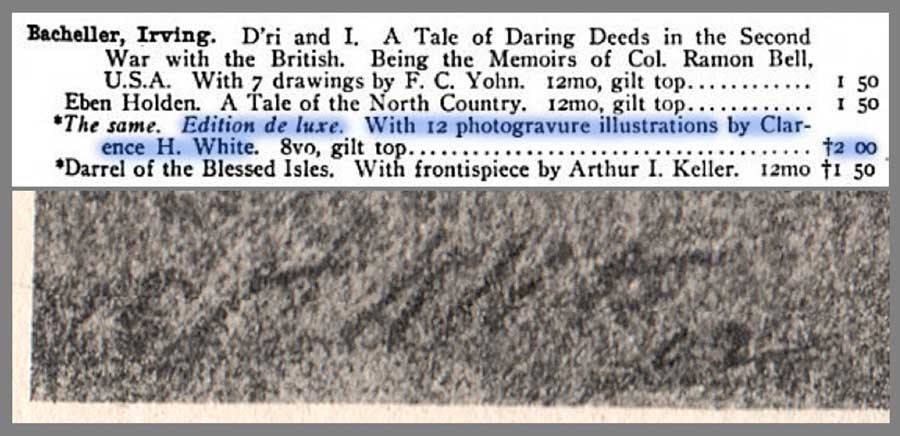 Detail: Top: listing for works by American author Irving Bacheller showing Edition de luxe of Eben Holden highlighted in blue: from: Illustrated Catalogue of Books Standard and Holiday 1903-1904: Chicago: A.C. McClurg and Company: 1903: p. 217 (the † denotes it is a work of fiction, published since November 1, 1902, under the rules of the American Publishers' Association. (from: Hathi Trust)Bottom: close-up detail showing autograph for CH White 02 at bottom left corner of representative photogravure plate from the Edition de luxe: from: PhotoSeed Archive
Detail: Top: listing for works by American author Irving Bacheller showing Edition de luxe of Eben Holden highlighted in blue: from: Illustrated Catalogue of Books Standard and Holiday 1903-1904: Chicago: A.C. McClurg and Company: 1903: p. 217 (the † denotes it is a work of fiction, published since November 1, 1902, under the rules of the American Publishers' Association. (from: Hathi Trust)Bottom: close-up detail showing autograph for CH White 02 at bottom left corner of representative photogravure plate from the Edition de luxe: from: PhotoSeed Archive
The Hunt is on
I consider myself a newbie collector, but one of the first things I put on my list 15 years ago when I first started out was one particular impression of Eben Holden rumored to have been illustrated by hand-pulled photogravures by White, the aforementioned famous photographer.
My curiosity had been piqued after seeing the volume listed in several bibliographies, typically stating the 1900 date. One such entry in author Christian A. Peterson’s Annotated Bibliography on Pictorial Photography did give me hope the work existed, even though finding one in the internet age would prove to be quite the challenge:
The Museum of Modern Art, New York, holds what is probably a unique copy of this book, comprised of the Lothrop text pages bound in leather, with an inscription by White and ten photogravure illustrations by him, including the portrait of Holden. (1.)
Because the novel had been such a success a century earlier, the reality of upwards of 500 vintage copies for sale on the web at any one time was daunting. My course of action however was simple, and eventually effective: send out a mass number of emails to every bookseller in the U.S. listing a copy from a suspect 1901 edition I had honed in on inquiring if it contained any photographic illustrations.
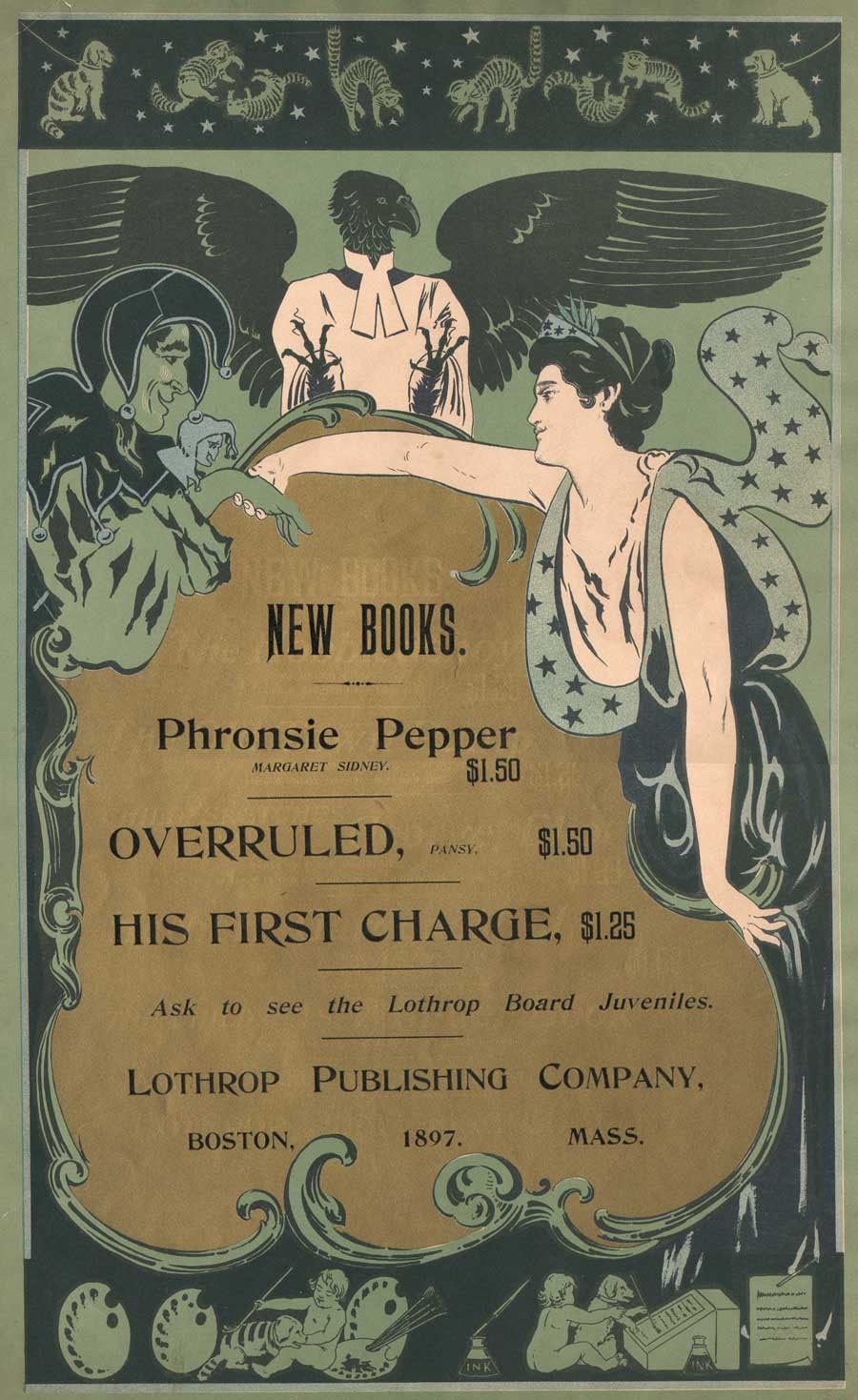 Broadside advertising poster for Lothrop Publishing Company of Boston: 1897: artist: William Schumacher: American: (1870-1931) multiple-color lithograph printed on wove paper: 52.7 x 34.0 cm. Speaking of the beginnings of Eben Holden in the year 1897, author Irving Bacheller said "had unsuccessfully offered the first 'Eben Holden' as it then stood to two juvenile publications; but as I happened to be just starting off on a vacation at that time, I determined myself to see the Boston firm, which was the Lothrop Publishing Company. I met the editor, Mr. Brooks, at the Parker House, and told him the story as I had written it. He immediately saw the possibilities in it and declared I had a big thing if I could carry it out as it should be." (excerpt: "The Critic": Oct. 1904) vintage broadside (trimmed) from: PhotoSeed Archive
Broadside advertising poster for Lothrop Publishing Company of Boston: 1897: artist: William Schumacher: American: (1870-1931) multiple-color lithograph printed on wove paper: 52.7 x 34.0 cm. Speaking of the beginnings of Eben Holden in the year 1897, author Irving Bacheller said "had unsuccessfully offered the first 'Eben Holden' as it then stood to two juvenile publications; but as I happened to be just starting off on a vacation at that time, I determined myself to see the Boston firm, which was the Lothrop Publishing Company. I met the editor, Mr. Brooks, at the Parker House, and told him the story as I had written it. He immediately saw the possibilities in it and declared I had a big thing if I could carry it out as it should be." (excerpt: "The Critic": Oct. 1904) vintage broadside (trimmed) from: PhotoSeed Archive
And so eventually luck prevailed. In 2007, a bookseller in Idaho finally said yes, and a bucket item was now on my library shelf. But that was not the end of it, as Alice would say, things got Curiouser and Curiouser! Because collectors never stop looking, I soon stumbled upon a CT bookseller who knew exactly the significance of the White-illustrated impression, with an astronomical asking price. An excerpt from his description of the work stated:
Elusive and highly desirable work, absent from almost all museum and library collections devoted to photography, and one of only a very few photographically illustrated books produced by a leading member of the Stieglitz circle at the height of the Photo-Secession. (2.)
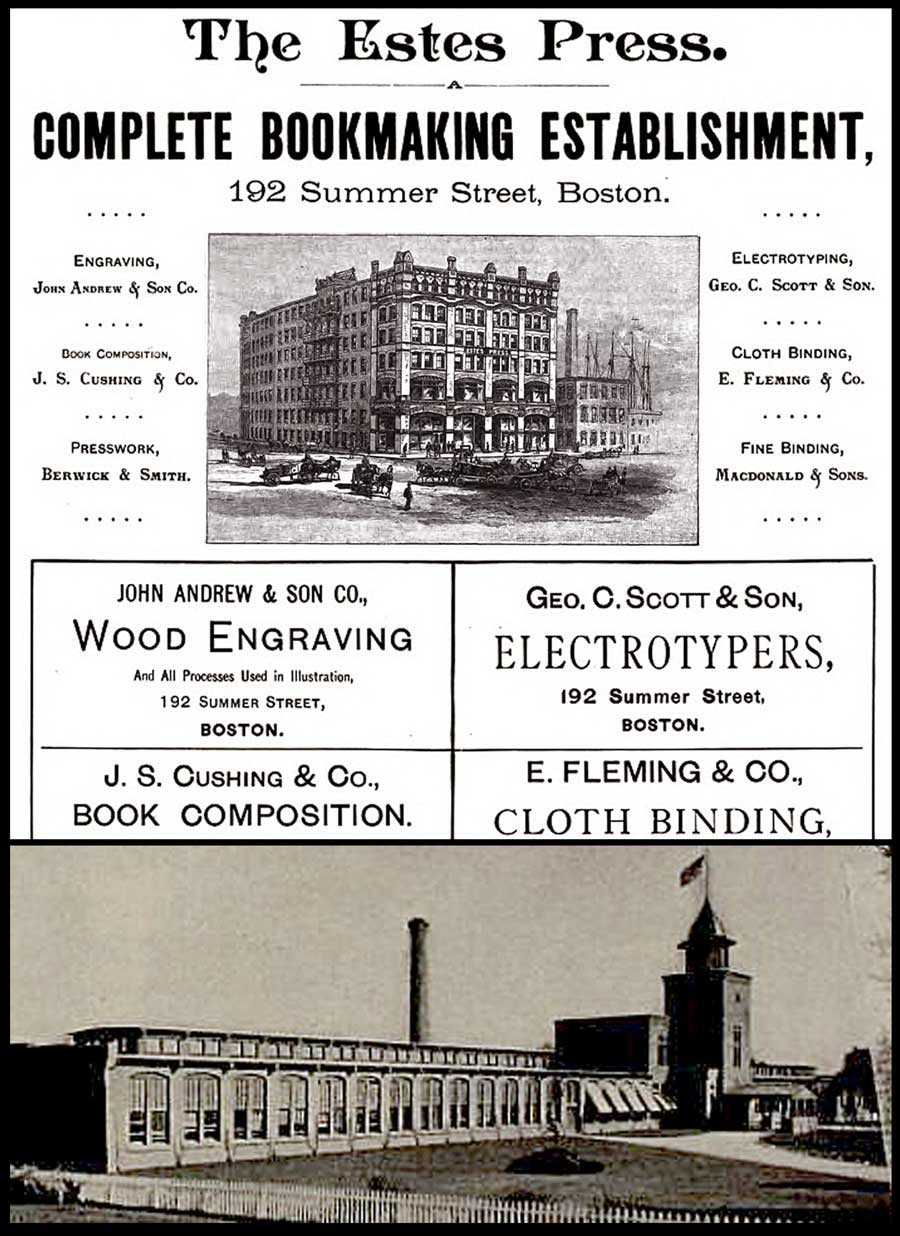 Top: detail: 1891 advertisement for The Estes Press (Dana Estes & Company) from "The American Bookmaker". The woodcut shows the brand new Estes Press Buildings located at 192 Summer St. in Boston first occupied around 1890. The firm housed many different companies involved in the bookmaking process, including: "The celebrated engravers, John Andrew & Son have their studios in the upper story…"; J.S. Cushing & Co., (book composition) Berwick & Smith, (presswork) and E. Fleming & Co. (binding). These last three firms left Estes in 1894 and became part of the Norwood Press. (from: Hathi Trust) Bottom: detail: exterior photograph of Norwood Press from the 1897 volume "Boston Massachusetts" by George W. Englehardt. The original caption noted the firm was located "Fourteen Miles from Boston, on the New England Road" and "as a whole employing nearly three hundred hands." This is where the Eben Holden Edition de luxe was printed. (from: Hathi Trust)
Top: detail: 1891 advertisement for The Estes Press (Dana Estes & Company) from "The American Bookmaker". The woodcut shows the brand new Estes Press Buildings located at 192 Summer St. in Boston first occupied around 1890. The firm housed many different companies involved in the bookmaking process, including: "The celebrated engravers, John Andrew & Son have their studios in the upper story…"; J.S. Cushing & Co., (book composition) Berwick & Smith, (presswork) and E. Fleming & Co. (binding). These last three firms left Estes in 1894 and became part of the Norwood Press. (from: Hathi Trust) Bottom: detail: exterior photograph of Norwood Press from the 1897 volume "Boston Massachusetts" by George W. Englehardt. The original caption noted the firm was located "Fourteen Miles from Boston, on the New England Road" and "as a whole employing nearly three hundred hands." This is where the Eben Holden Edition de luxe was printed. (from: Hathi Trust)
And so I sucked it in and didn’t purchase the second copy, which he told me he had originally purchased in Marlborough, NH. Eventually he sold it to a European collection, but I’ve since visited him several times and made a few purchases over the years, something I highly recommend rather than doing everything through e-commerce.
But then lighting struck again five years ago, when I purchased a second copy which had been personally inscribed by the author in 1911 to John A. Dix, then governor of New York state.
Curiouser? The first copy, fourth edition imprint stated Two Hundred and Sixty-fifth Thousand, March 12, 1901 and the second copy was for Two Hundred and Seventieth Thousand, September 18, 1903.
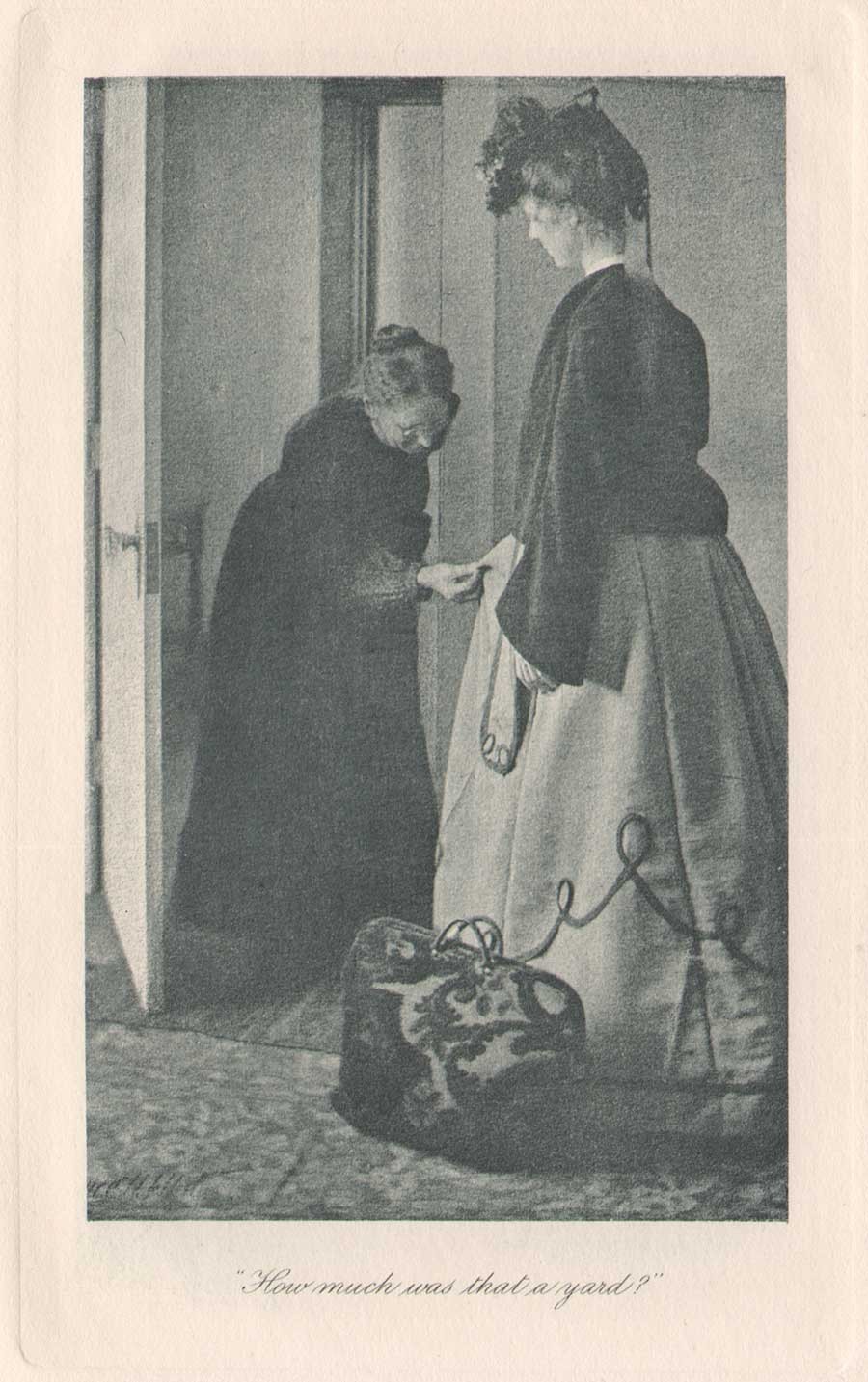 Detail: Clarence H. White: American: "How much was that a yard ?" Hand-pulled photogravure plate printed by John Andrew & Son (image: 12.2 x 7.5 cm | support: 20.0 x 14.0 cm ) from: Edition de luxe impression of Eben Holden: Lothrop Publishing, Boston: 1903. The Library of Congress states the model at right is Ann Fulton and the woman examining the dress is the photographer's mother Phoebe Billman White (1845-1920) : from: PhotoSeed Archive
Detail: Clarence H. White: American: "How much was that a yard ?" Hand-pulled photogravure plate printed by John Andrew & Son (image: 12.2 x 7.5 cm | support: 20.0 x 14.0 cm ) from: Edition de luxe impression of Eben Holden: Lothrop Publishing, Boston: 1903. The Library of Congress states the model at right is Ann Fulton and the woman examining the dress is the photographer's mother Phoebe Billman White (1845-1920) : from: PhotoSeed Archive
Knowing the book now existed in multiple impressions with the Clarence White photogravures was perplexing to me at first, but I’m certain the inclusion of the White photographs was intended by the publisher Lothrop for a more discriminating audience, so its assumed they had the monetary incentive to publish more than the one impression-even with the fickleness and extra work necessary to bind an edition with hand-pulled gravures.
To this end, my research in preparing this post discovered 1901 to be the year Clarence White was first commissioned by the Boston publisher to illustrate a new edition of Eben Holden. The intended publication date of very late 1902 was designed to coincide with the lucrative holiday sales season. Even with the move to e-books in our modern age, publishers earn good money issuing ornate and extra-illustrated editions during this time of year catering to the once a year book buyer and bibliophile alike.
Known as the Edition de luxe, this edition of Eben Holden with the White photogravures priced at $2.00 somehow managed to miss the late 1902 holiday sales season. The curious fact of the inclusion of the imprint for March 12, 1901 on the limitation page and White’s signature including the year 02 on many of the 12 plates in the published work was basic economics for publisher Lothrop-they simply used existing leaves, including the old limitation pages from current stock when it was eventually released for sale to bookstores in 1903.
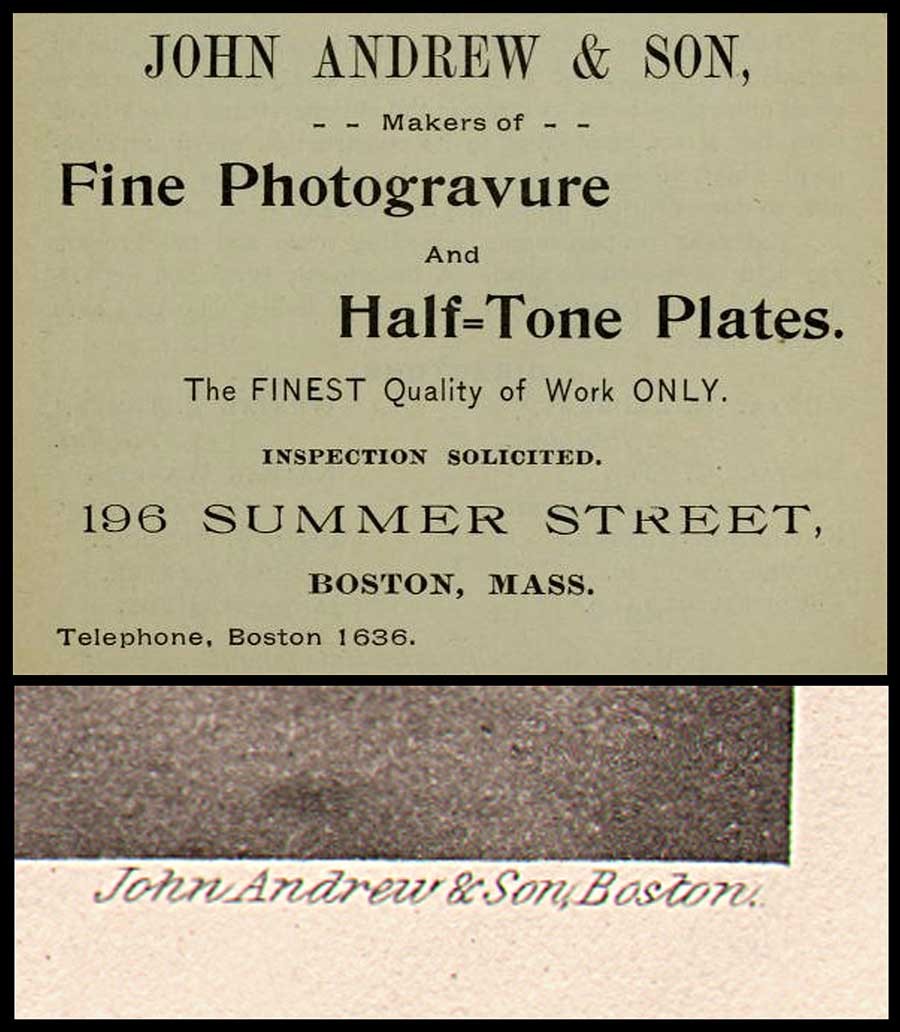 Top: detail: 1896: advertisement for John Andrew & Son from the "Boston Blue Book". (from: Hathi Trust) Bottom: detail: typical example of the firm's engraved credit appearing at lower right corner of image margin on plate recto from the 1903 Photographic Times-Bulletin. The John Andrew firm was established in Boston in 1852. from: PhotoSeed Archive
Top: detail: 1896: advertisement for John Andrew & Son from the "Boston Blue Book". (from: Hathi Trust) Bottom: detail: typical example of the firm's engraved credit appearing at lower right corner of image margin on plate recto from the 1903 Photographic Times-Bulletin. The John Andrew firm was established in Boston in 1852. from: PhotoSeed Archive
This was by no means unprecedented by Lothrop, or other large publishing houses of the era, as they would have set aside a certain number of unbound sheets from a best-selling work for limited impressions featuring artwork. The first illustrated edition of Eben Holden featured halftone photographs taken by Joseph Byron from the Broadway production of the same name hadn’t even debuted until Oct. 28 of 1901. This also used the March 12, 1901 imprint date. Known as the Dramatic Edition, it was described in the trade monthly The Bookseller:
”An illustrated edition of Eben Holden has been recently published called the Dramatic edition. It contains seven pictures of the play as it appeared in New York and a fine portrait of the author.” (3.)
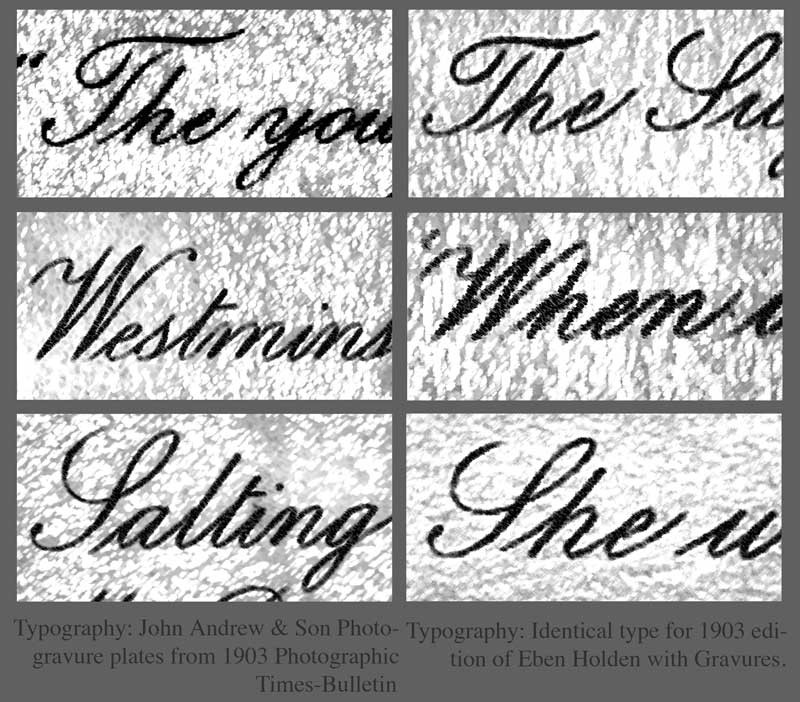 Details: with manipulations in PhotoShop to highlight typography: In order to show Boston's John Andrew & Son atelier printed the photogravure plates uncredited in the de luxe edition of Eben Holden, it is useful to analyze the script font typeface used for photographic plate titles. Column at left, top to bottom shows known examples from the Andrew atelier taken from the 1903 Photographic Times-Bulletin. Column at right shows plate titles from the Eben Holden volume. all from PhotoSeed Archive.
Details: with manipulations in PhotoShop to highlight typography: In order to show Boston's John Andrew & Son atelier printed the photogravure plates uncredited in the de luxe edition of Eben Holden, it is useful to analyze the script font typeface used for photographic plate titles. Column at left, top to bottom shows known examples from the Andrew atelier taken from the 1903 Photographic Times-Bulletin. Column at right shows plate titles from the Eben Holden volume. all from PhotoSeed Archive.
Published in 1903
Finally, with the eventual tenth imprint of the fourth edition stating Two Hundred and Seventieth Thousand, September 18, 1903, (6.) the makeup of the Edition de luxe was that of a small 8vo Octavo instead of the common edition, a 12mo Duodecimo. The inclusion of 12 fine, hand-pulled photogravure plates by White seen here is another matter altogether. For one, other than White’s autograph-appearing often (and faintly) in the lower left hand corner of each plate image as CH White 02, the Edition de luxe neglects to give him any printed credit for the photographs nor the atelier who printed them. This is very surprising for a special edition. Typically, there would at the very least be a separate illustrations page noting titles and page numbers at the front of a similar volume, but for whatever reason they were not included.
Stieglitz plays Go Between
With Eben Holden’s great success, the dramatization of the novel on the Broadway stage was logical for its day-especially since the Cinema was not an option because of the infancy of the medium. Lothrop’s piggy-backing of the work through this Dramatic edition, even by the “flop” standard of 49 performances, was but one way of keeping the work “fresh”- even a full year after initial publication. At some point late in 1901, a result perhaps of someone seeing the play on Broadway or believing White’s work would lend itself nicely to a series of photographic illustrations, the Boston publisher-perhaps through an association with Fred Holland Day (who lived in nearby Norwood where the Norwood Press printed books for Lothrop) or Alfred Stieglitz in New York-gave White the commission for its second illustrated edition of the novel.
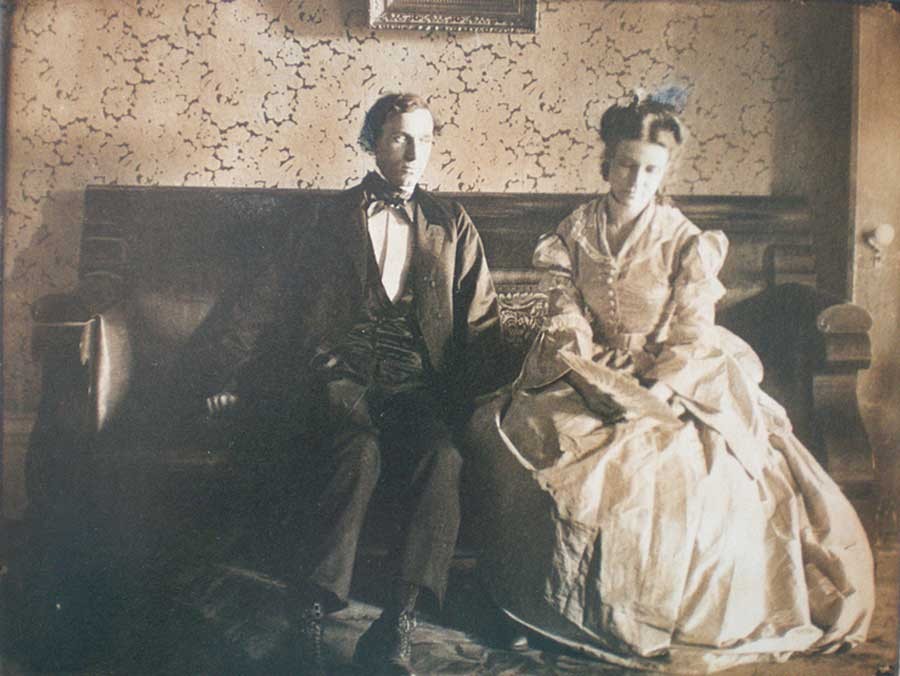 Clarence H. White: American: 1902: "She was still looking down at the fan": vintage Platinum or gelatin silver print: Showing typical retouching by White, the models are Alfred Dodge Cole, (1861-1928) a professor of Chemistry and Physics at Denison University and his wife Emily Downer Cole. (1865-1957) They play the roles of William Brower and Hope, whom Brower eventually marries in the novel Eben Holden. The photograph was reproduced as a photogravure plate and included in the Edition de luxe. Curators at the Robbins Hunter Museum where this and other White photographs are held stated the photographer had taken family photographs of the Downer family on the lawn of the home in the late 1890's and so he "would have been familiar with the house and furnishings from that commission. It was common for Clarence White to ask acquaintances to pose for photographs, often in costumes that he would provide. The photographs for Eben Holden were staged with costumes from the Civil War era." Photograph courtesy: Collection of the Robbins Hunter Museum in the Avery Downer House, Granville, OH.
Clarence H. White: American: 1902: "She was still looking down at the fan": vintage Platinum or gelatin silver print: Showing typical retouching by White, the models are Alfred Dodge Cole, (1861-1928) a professor of Chemistry and Physics at Denison University and his wife Emily Downer Cole. (1865-1957) They play the roles of William Brower and Hope, whom Brower eventually marries in the novel Eben Holden. The photograph was reproduced as a photogravure plate and included in the Edition de luxe. Curators at the Robbins Hunter Museum where this and other White photographs are held stated the photographer had taken family photographs of the Downer family on the lawn of the home in the late 1890's and so he "would have been familiar with the house and furnishings from that commission. It was common for Clarence White to ask acquaintances to pose for photographs, often in costumes that he would provide. The photographs for Eben Holden were staged with costumes from the Civil War era." Photograph courtesy: Collection of the Robbins Hunter Museum in the Avery Downer House, Granville, OH.
Ultimately, Stieglitz’s publishing background, connections and established relationship with White through his editorship of Camera Notes, his new involvement with Camera Work, as well as his having his own work exhibited in an early salon of pictorial photography in Newark Ohio in late 1900 and other exhibitions made Stieglitz a believer in White’s potential as an illustrator:
“What is especially fascinating, however, is what occurs when White is commissioned, as he was in 1901, to take up literary illustration himself. Through the assistance of Stieglitz, White received the commission to illustrate a new edition of the novel Eben Holden by Irving Bacheller. ( 4. )
And much later, the photographer’s grandson Maynard Pressley White commented about a bit of reluctance on his grandfather’s part in dealing with Lothrop as part of his Ph.D. dissertation in 1975:
“The correspondence with Stieglitz concerning the illustrations for Eben Holden is revealing of his character as well as Stieglitz informed him that he suffered from no such timidity and would—and indeed did—handle the matter with the publishers, as it turned out, to the advantage of White.” (5.)
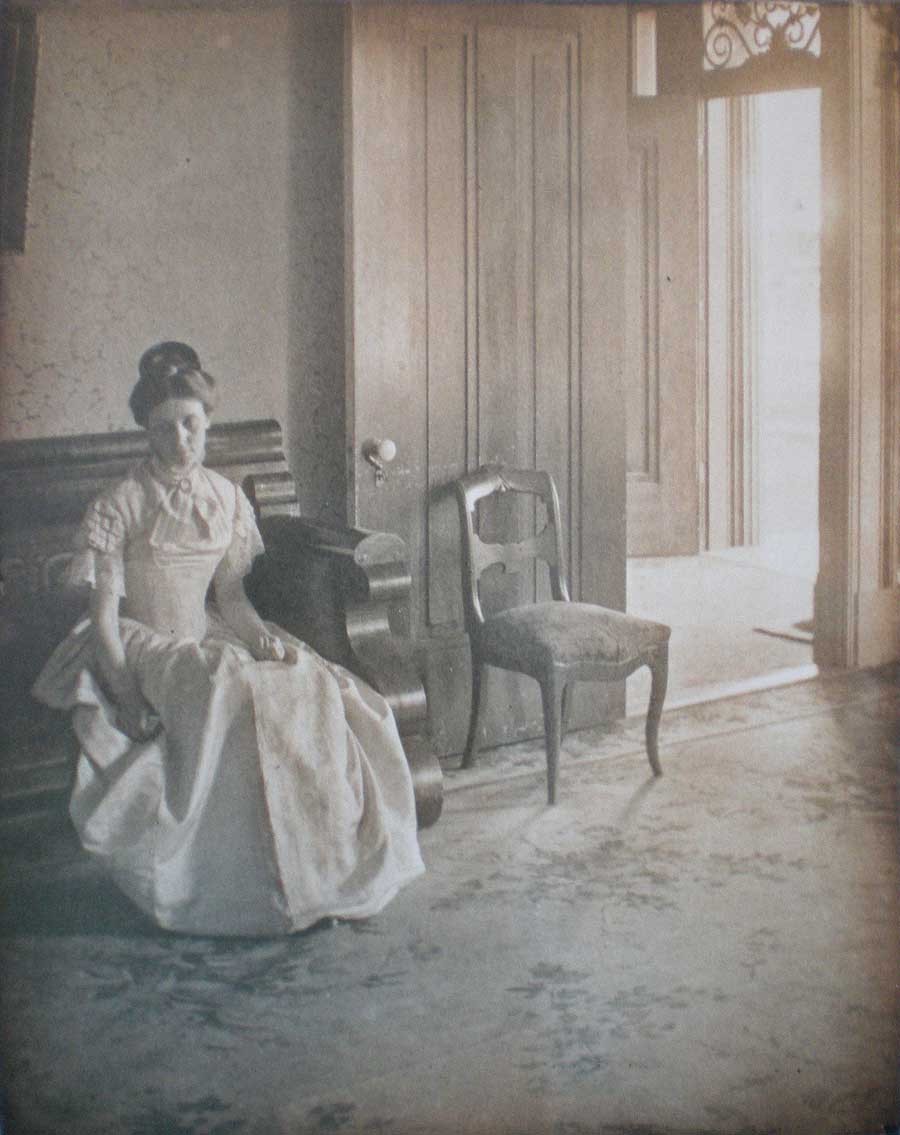 Clarence H. White: American: 1902? : vintage untitled Platinum or gelatin silver print: The model Emily Downer Cole (1865-1957) poses wearing a different dress than seen in the published Eben Holden photogravure "She was still looking down at the fan" taken on the same settee in the front parlor of the Downer family home. This was likely an alternate study Clarence White took for consideration for his series of Eben Holden illustrations. Photograph courtesy: Collection of the Robbins Hunter Museum in the Avery Downer House, Granville, OH.
Clarence H. White: American: 1902? : vintage untitled Platinum or gelatin silver print: The model Emily Downer Cole (1865-1957) poses wearing a different dress than seen in the published Eben Holden photogravure "She was still looking down at the fan" taken on the same settee in the front parlor of the Downer family home. This was likely an alternate study Clarence White took for consideration for his series of Eben Holden illustrations. Photograph courtesy: Collection of the Robbins Hunter Museum in the Avery Downer House, Granville, OH.
John Andrew & Son: founded in Boston: 1852
In giving credit to White and the firm that printed his photographs as gravures, a bit of elucidation seems in order to set things straight. Upon close inspection of these plates along with many others by Boston’s John Andrew & Son from the same time frame, I feel confident giving the Andrew firm credit for printing them. This is based on a near exact match in the script font used for the plate titles in the de luxe edition of Eben Holden as well as those plates credited to the firm appearing in the Photographic Times Bulletin from 1902-04.
I’ve included examples of the font as a comparison with this post. Another exact match is the same plate paper was used for both publications: this is very revealing especially on the plate verso where a very fine stipple pattern can be seen on the paper surface of the cream-colored plate paper. Perhaps the strongest association with the John Andrew atelier and the Norwood Press (which printed the de luxe edition) emerged in my research on business associations with some of the individual companies that came together in 1894 when that press was formed. These included J.S. Cushing & Co., (for composition and typesetting) Berwick & Smith Co., (for presswork) and E. Fleming & Co. (for binding). Beginning around 1890, all of these firms along with John Andrew were under one roof as part of the brand new Dana Estes & Company publishing house buildings on Summer Street in Boston.
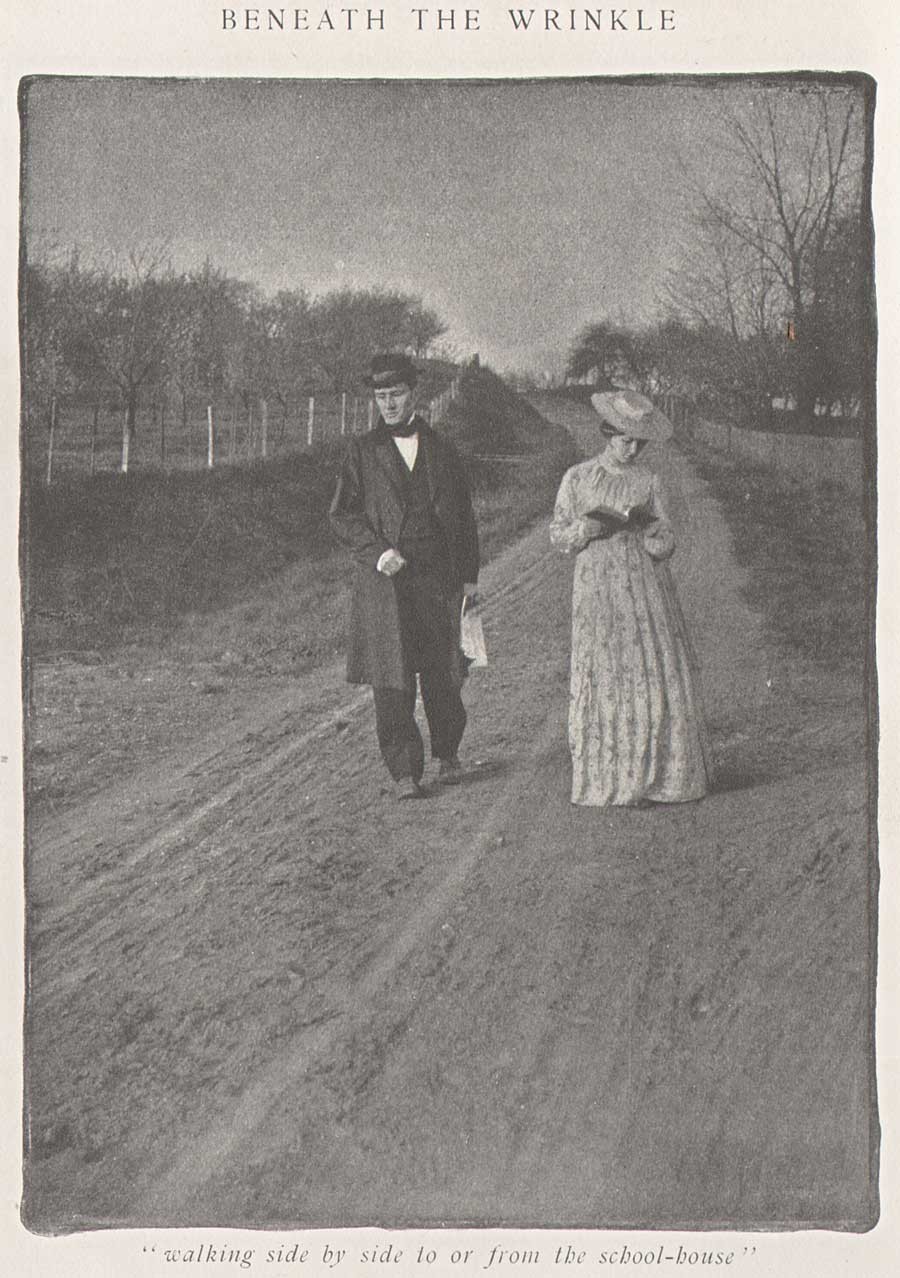 Clarence H. White: American: 1903: halftone: "Walking side by side to or from the school-house" was one of three photographs published to illustrate the Clara Morris story "Beneath the Wrinkle" published in the February, 1904 issue of McClure's Magazine. (12.8 x 9.5 cm) published: p. 430. From: PhotoSeed Archive
Clarence H. White: American: 1903: halftone: "Walking side by side to or from the school-house" was one of three photographs published to illustrate the Clara Morris story "Beneath the Wrinkle" published in the February, 1904 issue of McClure's Magazine. (12.8 x 9.5 cm) published: p. 430. From: PhotoSeed Archive
With the move to Norwood in 1894, the Andrew atelier stayed behind in Boston at 196 Summer St. but continued to provide fine photo engraving work to the major publishing houses in Boston and New York. Known today for printing many of the photogravure plates beginning in 1907 for the monumental Edward Sheriff Curtis work The North American Indian, the firm sometime in the first decade of the 20th Century became a department of the Suffolk Engraving & Electrotyping Co. of Boston with offices at 394 Atlantic Ave.
Named after John Andrew, (1815-1870) a wood engraver born in England who immigrated to Boston where he worked with fellow engraver Andrew Filmer, the firm eventually made the transition to photo engraving, including the half tone and photogravure processes. Andrew’s son George T. Andrew succeeded his father at the business, located at 196 Summer St. An 1892 overview of the firm from the volume Picturesque Hampden gives some background:
JOHN ANDREW & SON COMPANY.
ENGRAVERS AND MAKERS OF FINE BOOKS, BOSTON MASS.
If we go back a few years, we find that in illustrating books and magazines wood and steel engraving were about the only methods available. Nor could steel engraving have any wide use on account of the great expense of printing. Ever since its start, in 1852, the firm, now styled the John Andrew & Son Company, has held a prominent place among illustrators, especially in work of the finest grades. Their reputation was made in the first place as engravers on wood, but the discovery of delicate chemical and mechanical processes has in later years led them to also take the photo-engraving and half-tone work which has at present such wide use and popularity. In this field they do work for some of the best magazines and books published in this country. In what they undertake they strive not so much to do the cheapest work in price as the best work in quality. Quite recently the firm has taken up the photo-gravure process in addition to those spoken of above. The industry we describe is not located in Hampden county, but the mention here is not inappropriate as the engraving of our pen and ink pictures was done almost wholly by this firm. Their address is 196 Summer street, Boston.
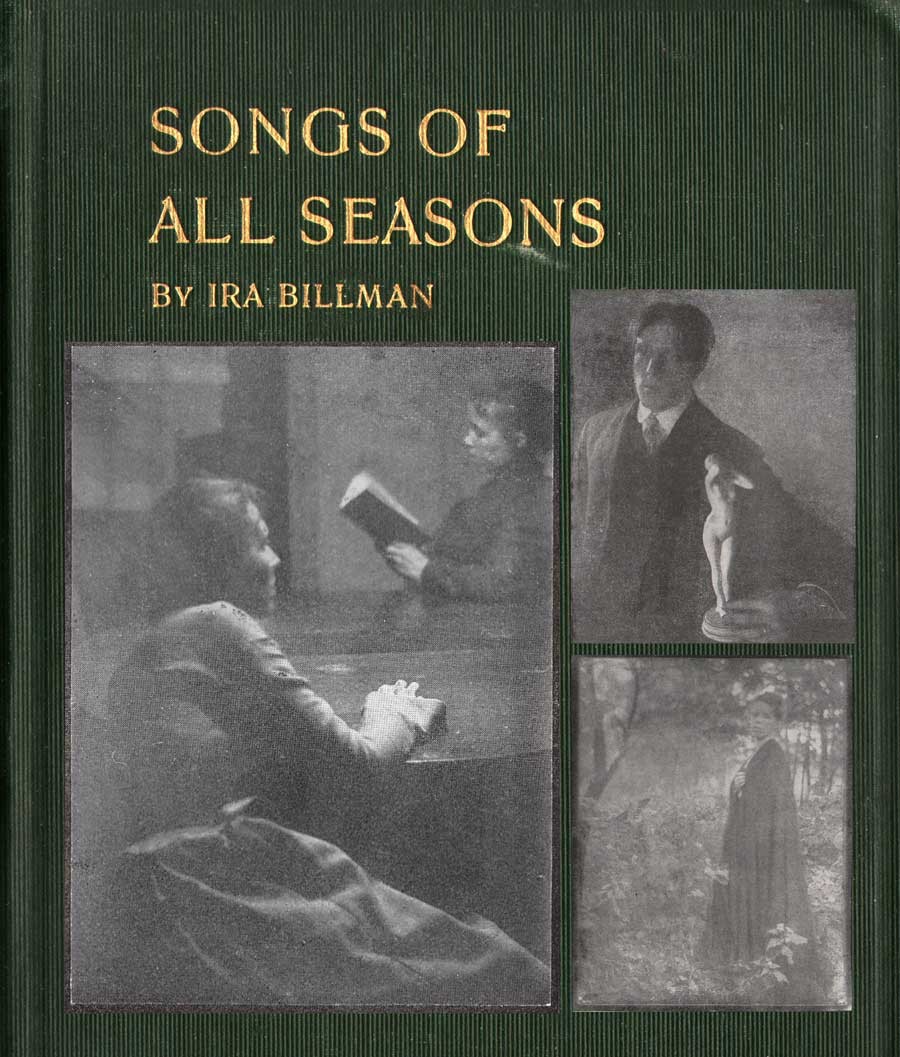 Detail: Cover for "Songs of All Seasons" by Ira Billman. The Hollenbeck Press, Indianapolis: 1904. Gilt-engraved stamped cloth: 20.4 x 13.6 cm: shown inset with representative photographs taken by Clarence White reproduced in halftone in the volume. Photo left: "The Book Lovers" (p. 181); top right: untitled man with statuette illustrating poem "The Twin Flower" (p.137); bottom right: "The Gloaming" (p. 199). Billman was Clarence White's uncle and was "one of his earliest artistic influences in his life": From: PhotoSeed Archive
Detail: Cover for "Songs of All Seasons" by Ira Billman. The Hollenbeck Press, Indianapolis: 1904. Gilt-engraved stamped cloth: 20.4 x 13.6 cm: shown inset with representative photographs taken by Clarence White reproduced in halftone in the volume. Photo left: "The Book Lovers" (p. 181); top right: untitled man with statuette illustrating poem "The Twin Flower" (p.137); bottom right: "The Gloaming" (p. 199). Billman was Clarence White's uncle and was "one of his earliest artistic influences in his life": From: PhotoSeed Archive
Photographic Illustration: a New Outlet
A newspaper clipping, believed to be from the Newark Daily Advocate in the Clarence Hudson White clipping file at the Newark, OH public library, includes the following undated (but 1903) story discussing Eben Holden in passing while concentrating on a new commission that inevitably came from it: costume-piece photographs by White similar to those he did for Lothrop for author Clara Morris’s story published in McClure’s magazine in February, 1904 entitled “Beneath the Wrinkle”:
PICTURES From Real Life by Clarence White
Forwarded On Order to a New York Magazine-Local Artist’s Latest Work.
Mr. Clarence White received a command last fall from the art department of McClure’s Magazine to illustrate Clara Morris’ new story, entitled, “Beneath the Wrinkle,” that will appear in that magazine presumably in the near future. Mr. White was to have been given all the time he wanted, but in view of the change of art editors, Mr. White was notified about three weeks ago that the illustrations would be required immediately. Mr. White at once notified the publishers that he would use all his efforts to complete them immediately, and would forward them when completed. Today the set comprising six, were forwarded and as equaly as clever and well executed as the ones made for the illustrating of the holiday edition of Eben Holden that was to have made its appearance last Christmas, but was not completed in time for that season. The ones now in progress are all local personages, done in quaint, old-fashioned garb and surroundings, recalling vividly to mind the characteristics in dress and decorations then in vogue. They show the fine and beautiful artistic temperament of Mr. White in his striking correct interpretation of dress and customs of the period in which the characters live. Mr. White deserves the honor the illustrations will surely bring to him, as he is always conscientious and painstaking in whatever he undertakes in his profession.
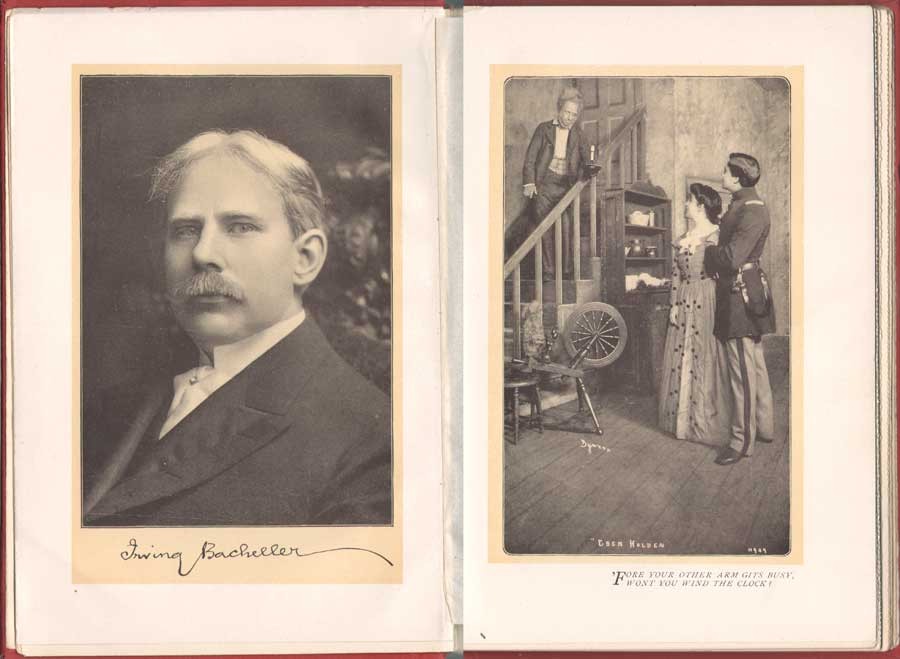 Left: Irving Bacheller, (1859-1950) American journalist and author, wrote the novel Eben Holden which sold over 1 million copies. This portrait with facsimile autograph by an unknown photographer appeared as the frontis (13.3 x 9.1 cm) to the Dramatic Edition of the book-the first illustrated edition featuring photographs of the Broadway stage production that debuted Oct. 28, 1901 and ran for only 49 performances. Right: " 'Fore your other arm gits busy, wont you wind the clock?" (14.1 x 8.4 cm) Actor E.M. Holland at left plays the role of Eben Holden, Lucille Flaven plays Hope and Earle Ryder as an American Civil War officer plays William Brower. The important New York commercial photographer Joseph Byron, (1847-1923) founder of the Byron Company (currently, the 7th & 8th generations runs Byron Photography) took stage photographs of the play at New York's Savoy Theatre with plates published in the Dramatic Edition. from: PhotoSeed Archive
Left: Irving Bacheller, (1859-1950) American journalist and author, wrote the novel Eben Holden which sold over 1 million copies. This portrait with facsimile autograph by an unknown photographer appeared as the frontis (13.3 x 9.1 cm) to the Dramatic Edition of the book-the first illustrated edition featuring photographs of the Broadway stage production that debuted Oct. 28, 1901 and ran for only 49 performances. Right: " 'Fore your other arm gits busy, wont you wind the clock?" (14.1 x 8.4 cm) Actor E.M. Holland at left plays the role of Eben Holden, Lucille Flaven plays Hope and Earle Ryder as an American Civil War officer plays William Brower. The important New York commercial photographer Joseph Byron, (1847-1923) founder of the Byron Company (currently, the 7th & 8th generations runs Byron Photography) took stage photographs of the play at New York's Savoy Theatre with plates published in the Dramatic Edition. from: PhotoSeed Archive
White Family Connections: Songs of all Seasons
During the time he received the commission for illustrating Beneath the Wrinkle in 1903, a more intimate family connection developed which allowed White the opportunity to take another series of photographic illustrations, 42 in all, published in 1904 within a slim volume of poetry titled Songs of All Seasons.
The author was nationally known poet Ira Billman, Clarence White’s uncle, the brother of his mother Phoebe Billman White. In the volume Symbolism of Light: The Photographs of Clarence H. White published in 1977 which accompanied an exhibition of White’s work at the Delaware Art Museum and International Center of Photography, White’s grandson Maynard P. White, Jr. describes Ira Billman as a major influence on Clarence and Songs:
Among the gathering of aunts and uncles that gave meaning and context to the artist’s early life was Ira Billman, his mother’s brother. “Poetic” is the word most often used to describe White’s photography, and his Uncle Ira, a poet by avocation, was one of the earliest artistic influences in his life. …Billman’s work celebrates rural America; his poems are songs to people and to nature, and they are imbued with the deep religious sentiments of his Lutheran heritage, without being mawkish or even faintly cloying. What is important for the purpose of my discussion is that Clarence White made the photographic illustrations for Songs of All Seasons, and Billman dedicated the volume to him. (7.)
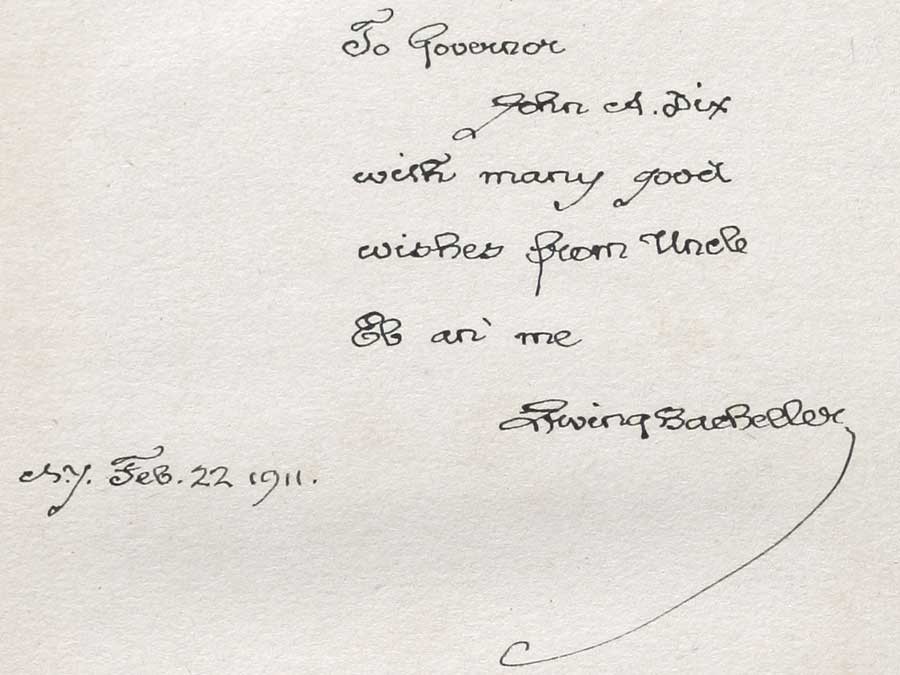 "To Governor John A. Dix with many good wishes from Uncle Eb an' me Irving Bacheller N.Y. Feb. 22 1911." This personal inscription by Bacheller to John A. Dix, then Governor of New York State, appears in a volume of Eben Holden with the imprint of Two Hundred and Seventieth Thousand, September 18, 1903, the actual year the novel was released for sale. In a 1901 newspaper article, Bacheller said the character Eben Holden was based on "a composite of my father and his hired man-a very jolly old fellow". from: PhotoSeed Archive
"To Governor John A. Dix with many good wishes from Uncle Eb an' me Irving Bacheller N.Y. Feb. 22 1911." This personal inscription by Bacheller to John A. Dix, then Governor of New York State, appears in a volume of Eben Holden with the imprint of Two Hundred and Seventieth Thousand, September 18, 1903, the actual year the novel was released for sale. In a 1901 newspaper article, Bacheller said the character Eben Holden was based on "a composite of my father and his hired man-a very jolly old fellow". from: PhotoSeed Archive
Ninety-one poems and sonnets are included in the volume. Here, The Test, a representative poem from the work:
The Test
Not what I felt will be the test
When song and fragrance filled the hour,
And all the sunshine of the blest
Unfolded me to perfect flower.
Not what I aid will be the test
When by sweet waters wound my way,
And white-haired, thoughtful hills all guessed
The word I was about to say.
Not what I did will be the test
When stunned by cry of human needs
I dreamed I was myself oppressed,
And woke to passion of great deeds.
Not what I chose will be the test
When first I saw one world in hand
Is worth two in the bush-the best
Of which it is to understand.
O! none of these will be the test,
But what God knows I would have done,
Had I been nurtured in the nest
Of one, I now condemn and shun. (8.)
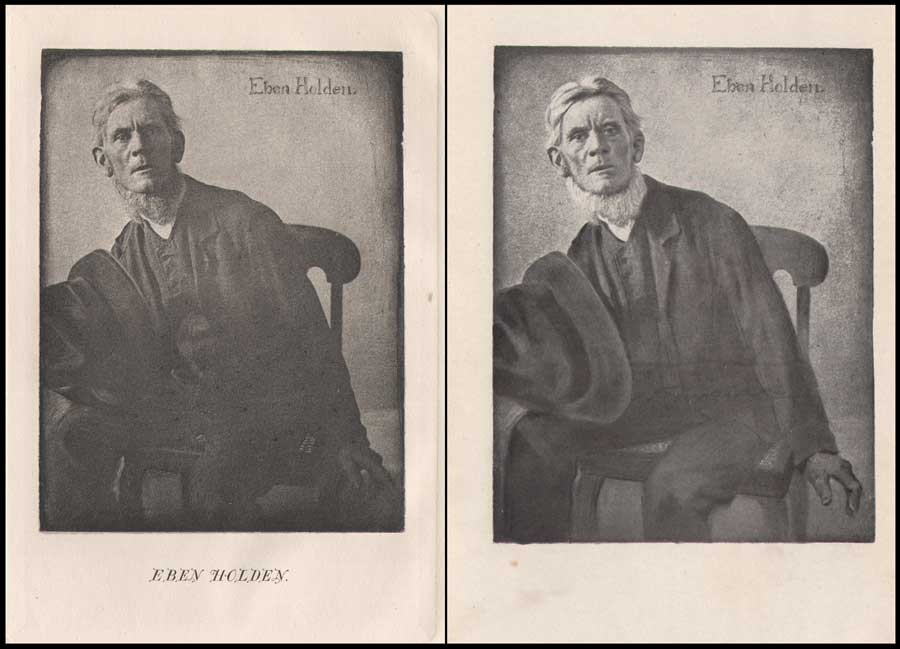 Left: Clarence H. White: American: 1902: hand-pulled photogravure: (9.7 x 7.3 cm) in: Eben Holden: A Tale of the North Country: Boston: Lothrop Publishing. (1903) Appearing as the frontis portrait in the Edition de luxe, this unknown subject was the novel's namesake: a fictional character who was a former farm-hand and main father figure for the newly orphaned William Brower serving as the narrator in the work. Right: Clarence H. White: American: 1902: halftone: (12.0 x 9.2 cm) in: Eben Holden: Harper & Brothers Publishers. (1914) Part of the Pine Tree Edition of Irving Bacheller's (Collected) Works. This heavily manipulated portrait from the original photograph by Clarence White of Eben Holden published 11 years earlier also appeared as the frontis for the first volume in the Pine Tree series. From: PhotoSeed Archive
Left: Clarence H. White: American: 1902: hand-pulled photogravure: (9.7 x 7.3 cm) in: Eben Holden: A Tale of the North Country: Boston: Lothrop Publishing. (1903) Appearing as the frontis portrait in the Edition de luxe, this unknown subject was the novel's namesake: a fictional character who was a former farm-hand and main father figure for the newly orphaned William Brower serving as the narrator in the work. Right: Clarence H. White: American: 1902: halftone: (12.0 x 9.2 cm) in: Eben Holden: Harper & Brothers Publishers. (1914) Part of the Pine Tree Edition of Irving Bacheller's (Collected) Works. This heavily manipulated portrait from the original photograph by Clarence White of Eben Holden published 11 years earlier also appeared as the frontis for the first volume in the Pine Tree series. From: PhotoSeed Archive
Pictorial Illustration for Photography a Growing Field
By 1904, esteemed critic Sadakichi Hartman, writing in Leslie’s Weekly, weighed in on the growing use of photography for book illustration:
”…and Clarence H. White, of Newark, O., has found a new opening for photography in the illustration of books. His illustrations for “Eben Holden” have attracted wide and deserved attention.” (9.)
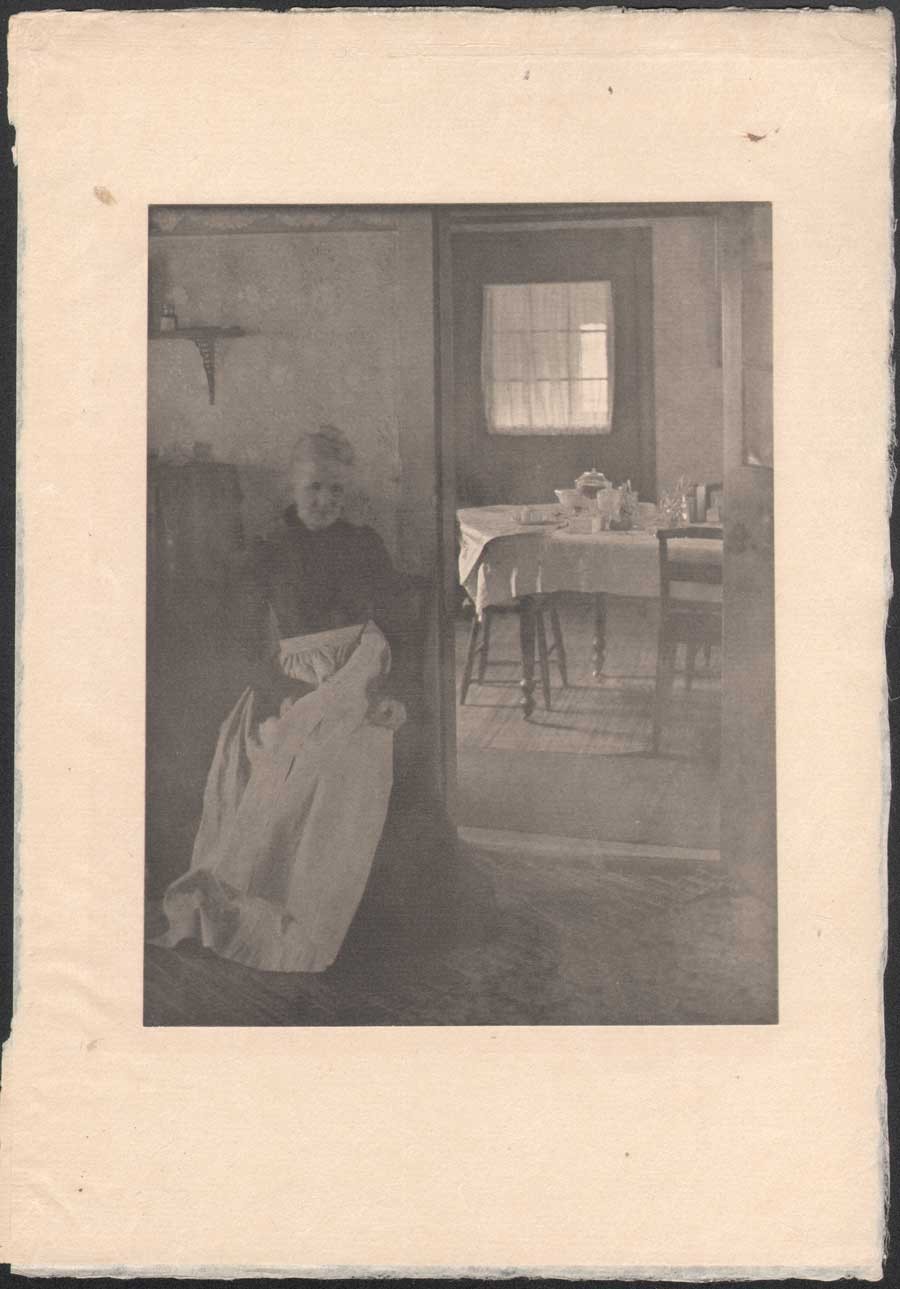 Clarence H. White: American: 1902: "Illustration to "Eben Holden"" (1903) hand-pulled photogravure: (tipped image:19.7 x 15.0 cm | Japan paper support: 30.5 x 21.0 cm) in: Camera Work III. (1903) Two plates in the Edition de luxe of Eben Holden: "How much was that a yard ?" (seen in this post-CW IX: 1905) and this one: "Mother was living in the old home alone"-an interior portrait of the photographer's mother Phoebe Billman White (1845-1920) were also published as photogravures in Camera Work. From: PhotoSeed Archive
Clarence H. White: American: 1902: "Illustration to "Eben Holden"" (1903) hand-pulled photogravure: (tipped image:19.7 x 15.0 cm | Japan paper support: 30.5 x 21.0 cm) in: Camera Work III. (1903) Two plates in the Edition de luxe of Eben Holden: "How much was that a yard ?" (seen in this post-CW IX: 1905) and this one: "Mother was living in the old home alone"-an interior portrait of the photographer's mother Phoebe Billman White (1845-1920) were also published as photogravures in Camera Work. From: PhotoSeed Archive
And later that year, citing White’s involvement with Eben Holden while writing in the Photographic Times Bulletin, Hartman brought up the potential financial rewards possible for pictorial photographer in this new field:
“The only way to approximate a market value of pictorial prints is to investigate how much they might bring on the average, if offered for sale as illustrations. There is lately a decided demand for photographic illustrations, and consequently a certain standard price in vogue. The pictorialist, of course, and perhaps with some right, aspires to illustrator’s prices (i.e., $50-$100 for the full page of a magazine), but he has never reached it, with the one exception of Clarence H. White, who is said to have received several hundred dollars for his series of “Eben Holden” illustrations.” (10.)
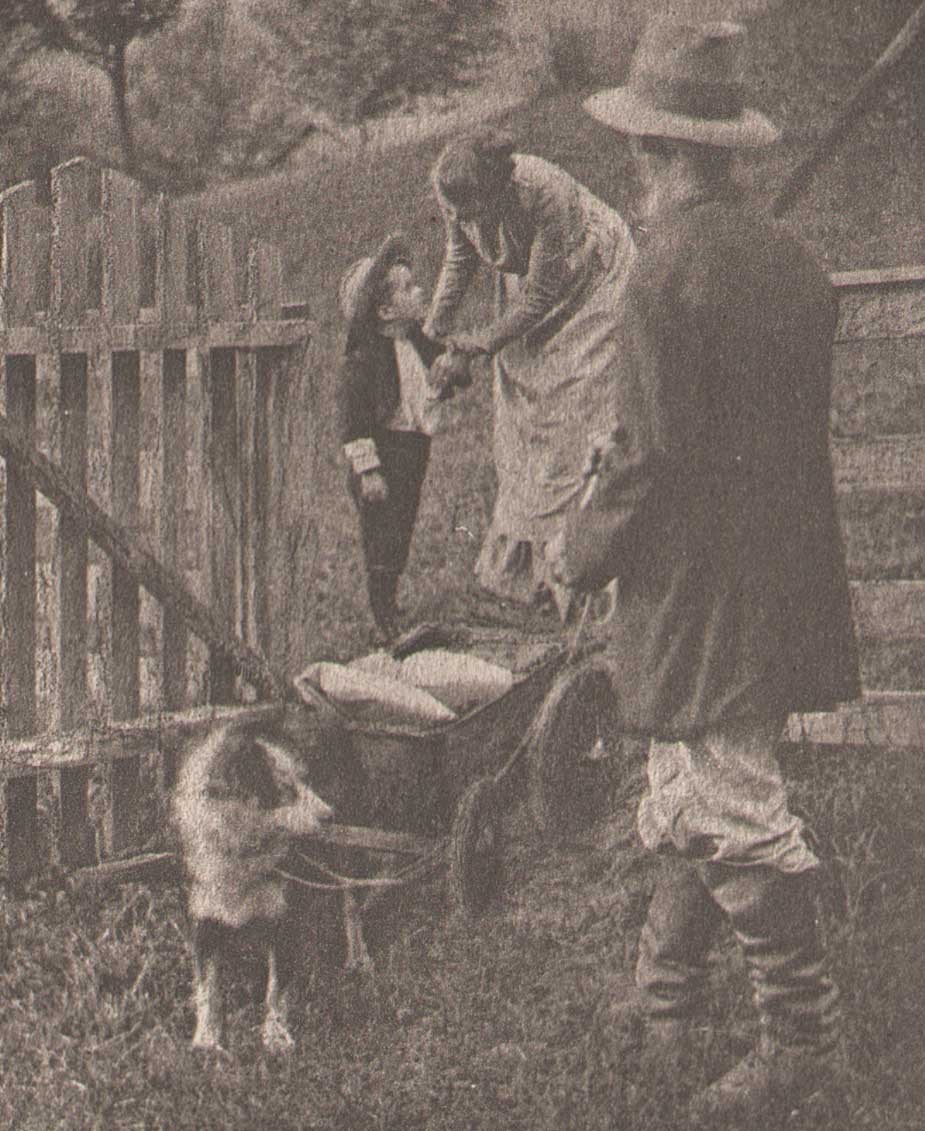 Detail: "Tucked some cookies into my pocket" : Clarence H. White: American: 1902: hand-pulled photogravure plate (11.9 x 7.3 cm) included with Edition de luxe of Eben Holden (1903): Lothrop Publishing, Boston. The young orphan William Brower is possibly modeled here by the photographer's son Maynard Pressley White (b. 1896) and his wife Jane Felix. (1869-1943) The scene shows Brower preparing to head out into the wilderness in a dog-pulled cart with Eben Holden at right. From the novel: "Our hostess met us at the gate and the look of her face when she bade us good-by and tucked some cookies into my pocket, has always lingered in my memory and put in me a mighty respect for all women." From: PhotoSeed Archive
Detail: "Tucked some cookies into my pocket" : Clarence H. White: American: 1902: hand-pulled photogravure plate (11.9 x 7.3 cm) included with Edition de luxe of Eben Holden (1903): Lothrop Publishing, Boston. The young orphan William Brower is possibly modeled here by the photographer's son Maynard Pressley White (b. 1896) and his wife Jane Felix. (1869-1943) The scene shows Brower preparing to head out into the wilderness in a dog-pulled cart with Eben Holden at right. From the novel: "Our hostess met us at the gate and the look of her face when she bade us good-by and tucked some cookies into my pocket, has always lingered in my memory and put in me a mighty respect for all women." From: PhotoSeed Archive
This additional source of significant money to Clarence White and his young family through these illustration commissions invariably gave him additional confidence in his abilities as a photographer and financial peace of mind to eventually make his way to New York City, leaving Newark in 1906. It is also not a stretch to infer White’s own life mimicked the storyline of hard work that can earn the “American Dream” found between the pages of Eben Holden. Although the critic for the New York Times reviewing the play at New York’s Savoy theater didn’t care too much for the acting:
”As an exhibition of dramatic craft “Eben Holden” is hardly worth serious consideration“…
he did, a few paragraphs later, write the production had a few redeeming qualities:
But, despite its defects, the play is wholesome; it is redolent of the woods and the fields, and it provides the opportunity for an evening of entertainment that need not be looked back upon with regret. (11.)
No doubt Clarence White, had he been in attendance watching the play inside Newark’s Auditorium that 1904 November evening, would have agreed with these last sentiments of the big city critic, marveling and grinning to himself in the darkened hall while taking in the surreal juxtaposition that art imitating life can bring about.
Notes:
1. (White, Clarence H.) excerpt: An Annotated Bibliography on Pictorial Photography: Selected Books from the Library of Christian A. Peterson: Laurence McKinley Gould Library: Carleton College: Northfield, Minnesota: 2004
2. ABE listing: 120407. Besides multiple copies held by PhotoSeed, other known copies are in the Library of Congress, MOMA and Photogravure.com.
3. The Bookseller-Devoted to the Book and News Trade: Chicago: January, 1902: p. 28
4. Peter C. Bunnell: Inside the Photograph: writings on Twentieth-Century Photography: Aperture Foundation: 2006: p. 47
5. Clarence H. White : a personal portrait: Maynard Pressley White: Ph.D. dissertation, University of Delaware, 1975: pp. 79-80
6. see Beaumont Newhall’s Photography: A Short Critical History, from 1938, lists Eben Holden with the White illustrations as being published in 1903 on p. 215
7. excerpt: see Symbolism of Light: 1977: p. 7
8. Songs of All Seasons: Ira Billman: Indianapolis: The Hollenbeck Press: 1904: p. 65
9. excerpt: Advances in Artistic Photography: Sidney Allan: in: Leslie’s Weekly: April 28, 1904: New York: p. 388
10. excerpt: from: What is the Commercial Value of Pictorial Prints?: Sidney Allen: in: The Photographic Times Bulletin: December, 1904: p. 539
11. excerpt: review: “Eben Holden” at the Savoy: The New York Times, October 29, 1901